Telit Communications S p A GE910Q3 Quad Band GSM/GPRS module User Manual 1vv0300962 GE910 Hardware User Guide r12
Telit Communications S.p.A. Quad Band GSM/GPRS module 1vv0300962 GE910 Hardware User Guide r12
Contents
- 1. User Manual
- 2. Users Manual
User Manual

GE910 Hardware User Guide
1vv0300962 Rev.12 – 2013-10-22
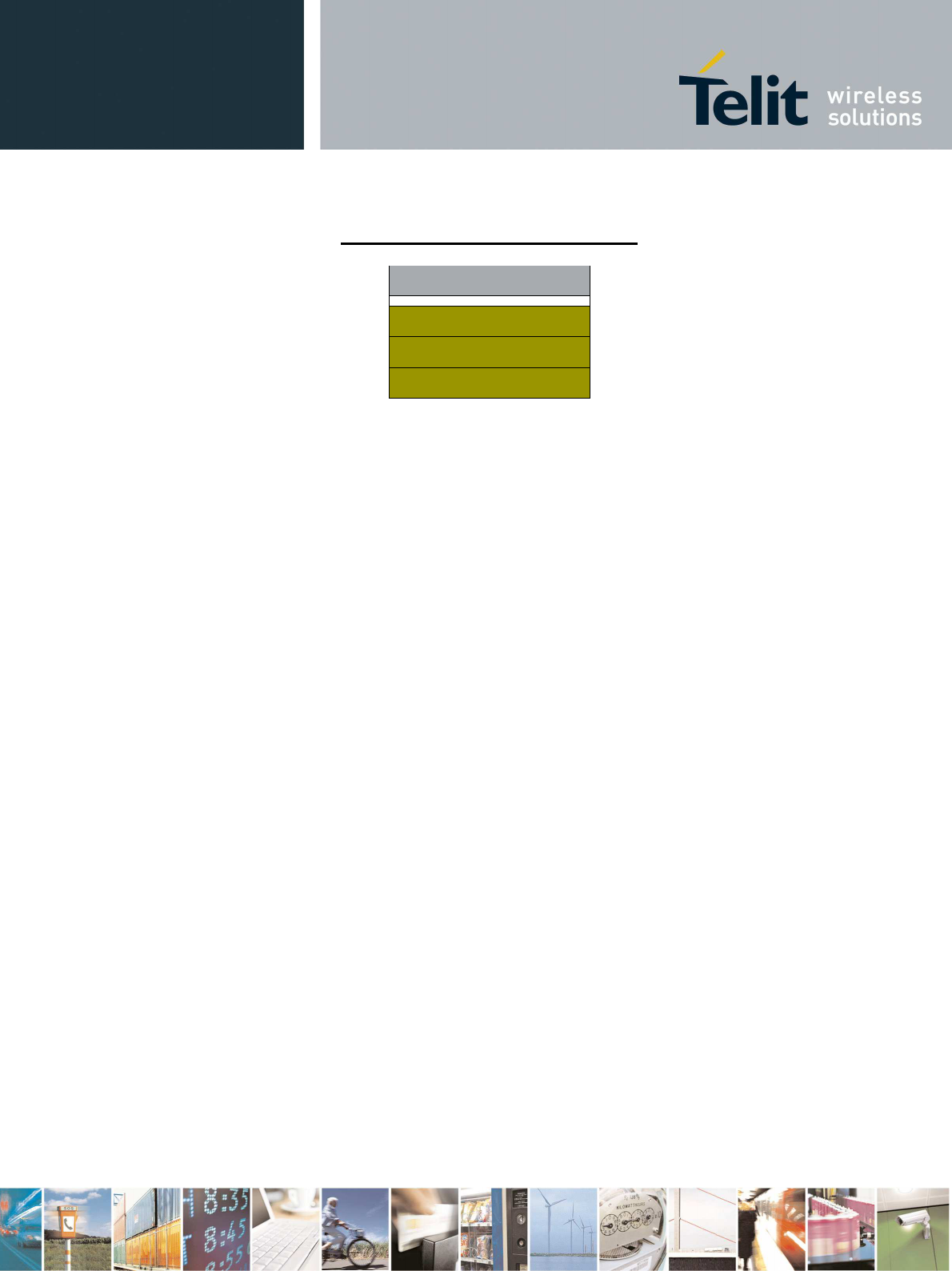
GE910 Hardware User Guide
1vv0300962 Rev.12 2013-10-22
Reproduction forbidden without Telit Communications S.p.A. written authorization - All Rights Reserved
page 2 of 83
Mod. 0805 2011-07 Rev.2
APPLICABILITY TABLE
PRODUCT
GE910-GNSS
GE910-QUAD
GE910-QUAD V3

GE910 Hardware User Guide
1vv0300962 Rev.12 2013-10-22
Reproduction forbidden without Telit Communications S.p.A. written authorization - All Rights Reserved
page 3 of 83
Mod. 0805 2011-07 Rev.2
SPECIFICATIONS SUBJECT TO CHANGE WITHOUT NOTICE
Notice
While reasonable efforts have been made to assure the accuracy of this document, Telit assumes
no liability resulting from any inaccuracies or omissions in this document, or from use of the
information obtained herein. The information in this document has been carefully checked and is
believed to be entirely reliable. However, no responsibility is assumed for inaccuracies or
omissions. Telit reserves the right to make changes to any products described herein and
reserves the right to revise this document and to make changes from time to time in content
hereof with no obligation to notify any person of revisions or changes. Telit does not assume
any liability arising out of the application or use of any product, software, or circuit described
herein; neither does it convey license under its patent rights or the rights of others.
It is possible that this publication may contain references to, or information about Telit products
(machines and programs), programming, or services that are not announced in your country.
Such references or information must not be construed to mean that Telit intends to announce
such Telit products, programming, or services in your country.
Copyrights
This instruction manual and the Telit products described in this instruction manual may be,
include or describe copyrighted Telit material, such as computer programs stored in
semiconductor memories or other media. Laws in the Italy and other countries preserve for Telit
and its licensors certain exclusive rights for copyrighted material, including the exclusive right
to copy, reproduce in any form, distribute and make derivative works of the copyrighted
material. Accordingly, any copyrighted material of Telit and its licensors contained herein or in
the Telit products described in this instruction manual may not be copied, reproduced,
distributed, merged or modified in any manner without the express written permission of Telit.
Furthermore, the purchase of Telit products shall not be deemed to grant either directly or by
implication, estoppel, or otherwise, any license under the copyrights, patents or patent
applications of Telit, as arises by operation of law in the sale of a product.
Computer Software Copyrights
The Telit and 3rd Party supplied Software (SW) products described in this instruction manual
may include copyrighted Telit and other 3rd Party supplied computer programs stored in
semiconductor memories or other media. Laws in the Italy and other countries preserve for Telit
and other 3rd Party supplied SW certain exclusive rights for copyrighted computer programs,
including the exclusive right to copy or reproduce in any form the copyrighted computer
program. Accordingly, any copyrighted Telit or other 3rd Party supplied SW computer programs
contained in the Telit products described in this instruction manual may not be copied (reverse
engineered) or reproduced in any manner without the express written permission of Telit or the
3rd Party SW supplier. Furthermore, the purchase of Telit products shall not be deemed to grant
either directly or by implication, estoppel, or otherwise, any license under the copyrights,
patents or patent applications of Telit or other 3rd Party supplied SW, except for the normal
non-exclusive, royalty free license to use that arises by operation of law in the sale of a product.

GE910 Hardware User Guide
1vv0300962 Rev.12 2013-10-22
Reproduction forbidden without Telit Communications S.p.A. written authorization - All Rights Reserved
page 4 of 83
Mod. 0805 2011-07 Rev.2
Usage and Disclosure Restrictions
License Agreements
The software described in this document is the property of Telit and its licensors. It is furnished
by express license agreement only and may be used only in accordance with the terms of such
an agreement.
Copyrighted Materials
Software and documentation are copyrighted materials. Making unauthorized copies is
prohibited by law. No part of the software or documentation may be reproduced, transmitted,
transcribed, stored in a retrieval system, or translated into any language or computer language,
in any form or by any means, without prior written permission of Telit
High Risk Materials
Components, units, or third-party products used in the product described herein are NOT fault-
tolerant and are NOT designed, manufactured, or intended for use as on-line control equipment
in the following hazardous environments requiring fail-safe controls: the operation of Nuclear
Facilities, Aircraft Navigation or Aircraft Communication Systems, Air Traffic Control, Life
Support, or Weapons Systems (High Risk Activities"). Telit and its supplier(s) specifically
disclaim any expressed or implied warranty of fitness for such High Risk Activities.
Trademarks
TELIT and the Stylized T Logo are registered in Trademark Office. All other product or service
names are the property of their respective owners.
Copyright © Telit Communications S.p.A. 2013

GE910 Hardware User Guide
1vv0300962 Rev.12 2013-10-22
Reproduction forbidden without Telit Communications S.p.A. written authorization - All Rights Reserved
page 5 of 83
Mod. 0805 2011-07 Rev.2
Contents
1.
Introduction ..................................................................................................................................................................... 7
1.1.
Scope ........................................................................................................................................................................ 7
1.2.
Audience .................................................................................................................................................................. 7
1.3.
Contact Information, Support ................................................................................................................................... 7
1.4.
Document Organization ........................................................................................................................................... 8
1.5.
Text Conventions ..................................................................................................................................................... 9
1.6.
Related Documents .................................................................................................................................................. 9
2.
Overview ........................................................................................................................................................................ 10
3.
GE910 module connections .......................................................................................................................................... 11
3.1.
PIN-OUT ................................................................................................................................................................ 11
3.2.
Important Pin-out to Debug in customer’s application .......................................................................................... 15
3.3.
LGA PADs Layout ................................................................................................................................................. 16
4.
Hardware Commands................................................................................................................................................... 17
4.1.
Turning ON the GE910 .......................................................................................................................................... 17
4.2.
Turning OFF the GE910 ........................................................................................................................................ 21
4.3.
HW Unconditional Shutdown on GE910 ............................................................................................................... 23
5.
Power Supply ................................................................................................................................................................. 25
5.1.
Power Supply Requirements .................................................................................................................................. 25
5.2.
Power Consumption ............................................................................................................................................... 26
5.2.1.
Power consumption Plots .............................................................................................................................. 27
5.3.
General Design Rules ............................................................................................................................................. 31
5.3.1.
Electrical Design Guidelines ......................................................................................................................... 31
5.3.2.
Thermal Design Guidelines ........................................................................................................................... 34
5.3.3.
Power Supply PCB layout Guidelines ........................................................................................................... 35
6.
GSM Radio Section ....................................................................................................................................................... 36
6.1.
GSM Antenna Requirements ................................................................................................................................. 36
6.2.
GSM Antenna - PCB line Guidelines ..................................................................................................................... 37
6.3.
PCB Guidelines in case of FCC certification ......................................................................................................... 38
6.3.1.
Transmission line design ............................................................................................................................... 38
6.3.2.
Transmission line measurements ................................................................................................................... 39
6.4.
GSM Antenna - Installation Guidelines ................................................................................................................. 41
7.
Global Navigation Satellite System (GE910-GNSS) ................................................................................................... 42
7.1.
Principles of operation ........................................................................................................................................... 42
7.2.
GNSS Signals Pinout ............................................................................................................................................. 43
7.3.
Turning ON/OFF the GNSS module only in standalone mode .............................................................................. 43
7.4.
RF Front End Design.............................................................................................................................................. 43
7.4.1.
RF Signal Requirements ................................................................................................................................ 44
7.4.2.
GNSS Antenna – PCB Line Guidelines ......................................................................................................... 44
7.4.3.
GNSS Antenna Polarization .......................................................................................................................... 44
7.4.4.
GNSS Antenna Gain ...................................................................................................................................... 45
7.4.5.
Active versus Passive Antenna ...................................................................................................................... 45
7.4.6.
RF Trace Losses ............................................................................................................................................ 46
7.4.7.
Implications of the Pre-select SAW Filter ..................................................................................................... 46
7.4.8.
External LNA Gain and Noise Figure ........................................................................................................... 46

GE910 Hardware User Guide
1vv0300962 Rev.12 2013-10-22
Reproduction forbidden without Telit Communications S.p.A. written authorization - All Rights Reserved
page 6 of 83
Mod. 0805 2011-07 Rev.2
7.4.9.
Powering the External LNA (active antenna) ................................................................................................ 46
7.4.10.
External LNA Enable ..................................................................................................................................... 47
8.
Logic Level Specifications ............................................................................................................................................ 48
9.
USB Port ........................................................................................................................................................................ 49
9.1.
USB 2.0 FS ............................................................................................................................................................ 49
10.
Serial Ports ................................................................................................................................................................ 50
10.1.
Modem Serial Port ................................................................................................................................................. 50
10.2.
RS232 level translation .......................................................................................................................................... 52
11.
Audio Section Overview ........................................................................................................................................... 54
11.1.
Digital Voice Interface (DVI) ................................................................................................................................ 54
11.1.1.
DVI Electrical Connections ........................................................................................................................... 54
11.2.
Analog Front-End ................................................................................................................................................... 54
11.2.1.
MIC connection ............................................................................................................................................. 54
11.2.2.
LINE-IN connection ....................................................................................................................................... 56
11.2.3.
EAR connection ............................................................................................................................................. 57
11.2.4.
Electrical Characteristics .............................................................................................................................. 59
12.
General Purpose I/O ................................................................................................................................................. 61
12.1.
Using a GPIO Pad as INPUT ................................................................................................................................. 62
12.2.
Using a GPIO Pad as OUTPUT ............................................................................................................................. 62
12.3.
Indication of network service availability .............................................................................................................. 63
12.4.
RTC Bypass out ..................................................................................................................................................... 64
12.5.
External SIM Holder Implementation .................................................................................................................... 64
12.6.
ADC Converter ...................................................................................................................................................... 64
12.6.1.
Description .................................................................................................................................................... 64
12.6.2.
Using ADC Converter ................................................................................................................................... 64
13.
Mounting the GE910 on your Board....................................................................................................................... 65
13.1.
General ................................................................................................................................................................... 65
13.2.
Module finishing & dimensions ............................................................................................................................. 65
13.3.
Recommended foot print for the application .......................................................................................................... 66
13.4.
Stencil ..................................................................................................................................................................... 67
13.5.
PCB pad design ...................................................................................................................................................... 67
13.6.
Recommendations for PCB pad dimensions .......................................................................................................... 67
13.7.
Solder paste ............................................................................................................................................................ 69
13.7.1.
GE910 Solder reflow ..................................................................................................................................... 69
14.
Packing system .......................................................................................................................................................... 71
14.1.
Packing on Reel ...................................................................................................................................................... 71
14.1.1.
Carrier Tape Detail ....................................................................................................................................... 71
14.1.2.
Reel Detail ..................................................................................................................................................... 72
14.1.3.
Packaging Detail ........................................................................................................................................... 73
14.2.
Packing on tray ....................................................................................................................................................... 74
14.3.
Moisture sensibility ................................................................................................................................................ 76
15.
Conformity Assessment Issues ................................................................................................................................. 77
16.
SAFETY RECOMMANDATIONS ......................................................................................................................... 82
17.
Document History ..................................................................................................................................................... 83

GE910 Hardware User Guide
1vv0300962 Rev.12 2013-10-22
Reproduction forbidden without Telit Communications S.p.A. written authorization - All Rights Reserved
page 7 of 83
Mod. 0805 2011-07 Rev.2
1. Introduction
1.1. Scope
The aim of this document is the description of some hardware solutions useful for developing a
product with the Telit GE910 module.
1.2. Audience
This document is intended for Telit customers, who are integrators, about to implement their
applications using our GE910 modules.
1.3. Contact Information, Support
For general contact, technical support, to report documentation errors and to order manuals,
contact Telit’s Technical Support Centre (TTSC) at:
TS-EMEA@telit.com
TS-NORTHAMERICA@telit.com
TS-LATINAMERICA@telit.com
TS-APAC@telit.com
Alternatively, use:
http://www.telit.com/en/products/technical-support-center/contact.php
For detailed information about where you can buy the Telit modules or for recommendations on
accessories and components visit:
http://www.telit.com
To register for product news and announcements or for product questions contact Telit’s
Technical Support Centre (TTSC).
Our aim is to make this guide as helpful as possible. Keep us informed of your comments and
suggestions for improvements.
Telit appreciates feedback from the users of our information.
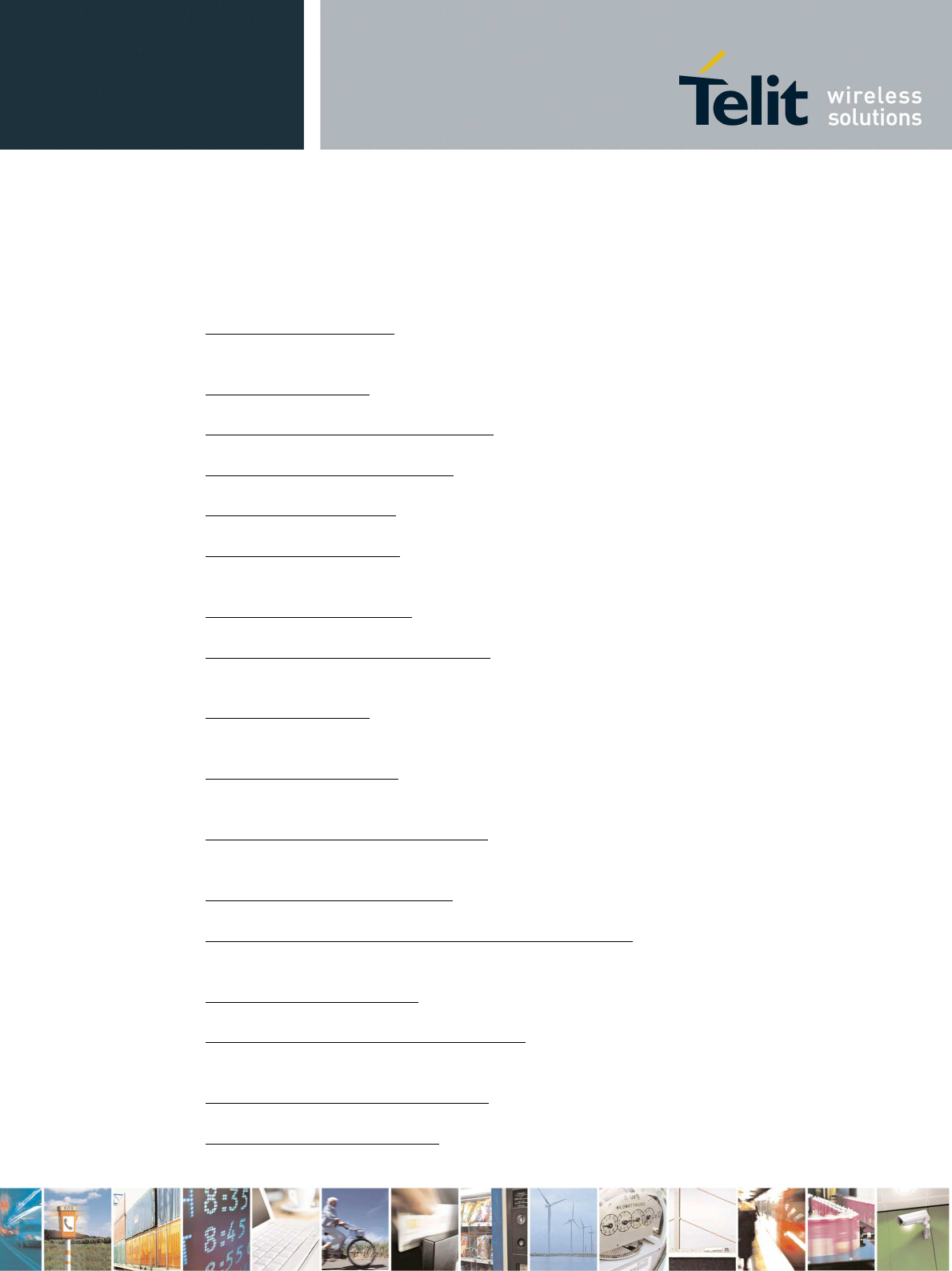
GE910 Hardware User Guide
1vv0300962 Rev.12 2013-10-22
Reproduction forbidden without Telit Communications S.p.A. written authorization - All Rights Reserved
page 8 of 83
Mod. 0805 2011-07 Rev.2
1.4. Document Organization
This document contains the following chapters:
Chapter 1: “Introduction” provides a scope for this document, target audience, contact and
support information, and text conventions.
Chapter 2: “Overview” provides an overview of the document.
Chapter 3: “GE910 Module Connections” deals with the pin out configuration and layout.
Chapter 4: “Hardware Commands” How to operate on the module via hardware.
Chapter 5: “Power supply” Power supply requirements and general design rules.
Chapter 6: “GSM Radio” The antenna connection and board layout design are the most
important parts in the full product design.
Chapter 7: “GNSS Receiver” This section describes the GNSS receiver.
Chapter 8: “Logic Level specifications” Specific values adopted in the implementation of logic
levels for this module.
Chapter 9: “USB Port” Describes the USB port and the interface between the module and OEM
hardware.
Chapter 10: “Serial ports” Describes the UART ports present and the interface between the
module and OEM hardware.
Chapter 11: “Audio Section overview” Refers to the audio blocks of the Base Band Chip of the
GE910 Telit Modules.
Chapter 12: “General Purpose I/O” How the general purpose I/O pads can be configured.
Chapter 13: “Mounting the GE910 on the application board” Recommendations and specifics on
how to mount the module on the user’s board.
Chapter 14: “Packing system” Packaging Information.
Chapter 15: “Conformity Assessment Issues” Information related to the Conformity
Assessments.
Chapter 16: “Safety Recommendations” Information related to the Safety topics.
Chapter 17: “Document History”
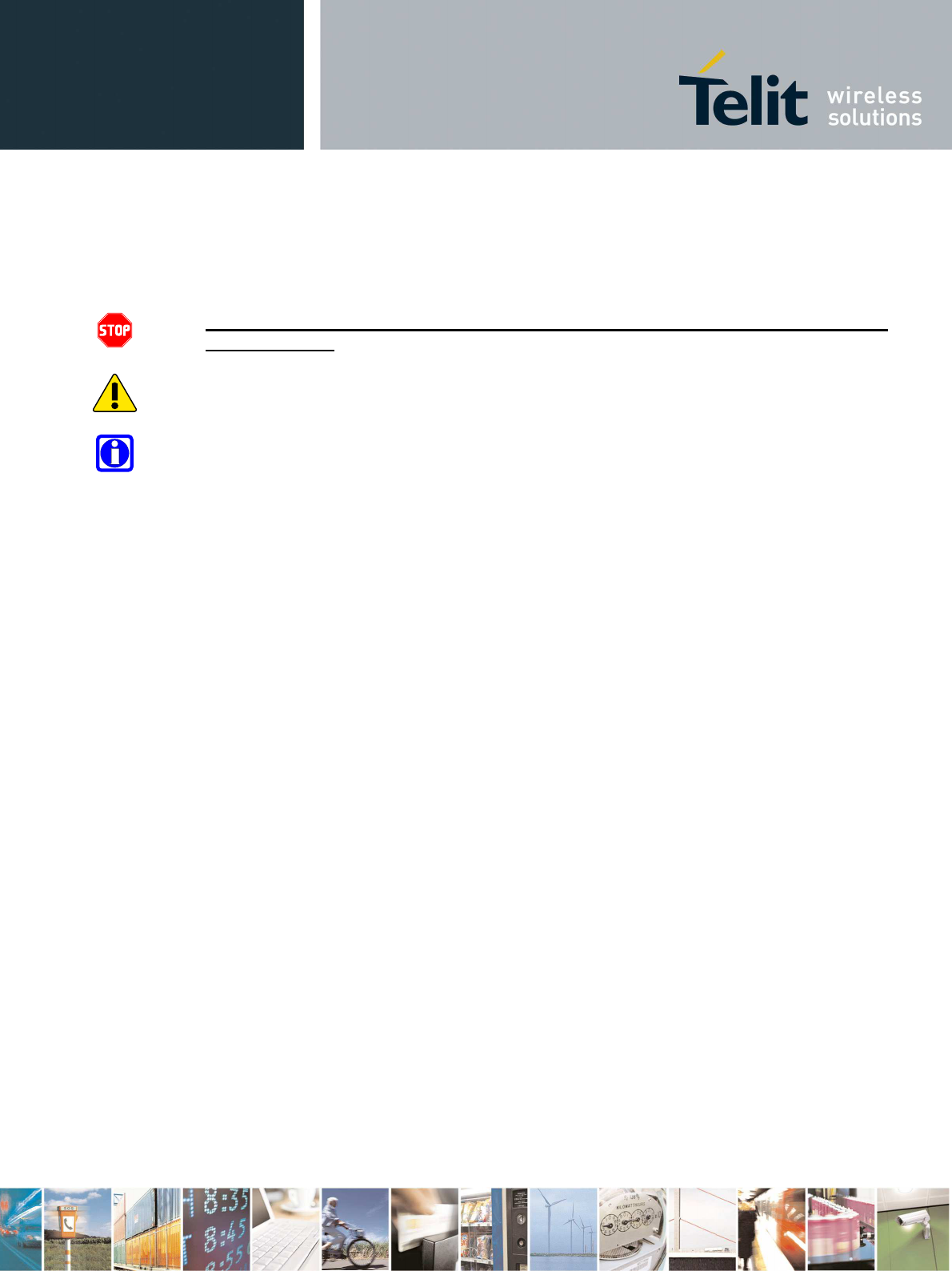
GE910 Hardware User Guide
1vv0300962 Rev.12 2013-10-22
Reproduction forbidden without Telit Communications S.p.A. written authorization - All Rights Reserved
page 9 of 83
Mod. 0805 2011-07 Rev.2
1.5. Text Conventions
Danger – This information MUST be followed or catastrophic equipment failure or bodily
injury may occur.
Caution or Warning – Alerts the user to important points about integrating the module, if
these points are not followed, the module and end user equipment may fail or malfunction.
Tip or Information – Provides advice and suggestions that may be useful when integrating
the module.
All dates are in ISO 8601 format, i.e. YYYY-MM-DD.
1.6. Related Documents
• Telit 's GSM/GPRS Family Software User Guide, 1vv0300784
• Audio settings application note , 80000NT10007a
• Digital Voice Interface Application Note, 80000NT10004a
• GE910 Product description, 80397ST10107A
• SIM Holder Design Guides, 80000NT10001a
• AT Commands Reference Guide, 80000ST10025a
• Telit EVK2 User Guide, 1vv0300704

GE910 Hardware User Guide
1vv0300962 Rev.12 2013-10-22
Reproduction forbidden without Telit Communications S.p.A. written authorization - All Rights Reserved
page 10 of 83
Mod. 0805 2011-07 Rev.2
2. Overview
The aim of this document is the description of some hardware solutions useful for developing a
product with the Telit GE910 module.
In this document all the basic functions of a mobile phone will be taken into account; for each
one of them a proper hardware solution will be suggested and eventually the wrong solutions
and common errors to be avoided will be evidenced. Obviously this document cannot embrace
the whole hardware solutions and products that may be designed. The wrong solutions to be
avoided shall be considered as mandatory, while the suggested hardware configurations shall not
be considered mandatory, instead the information given shall be used as a guide and a starting
point for properly developing your product with the Telit GE910 module. For further hardware
details that may not be explained in this document refer to the Telit GE910 Product Description
document where all the hardware information is reported.
NOTICE:
(The integration of the GSM/GPRS GE910 cellular module within user application shall be
done according to the design rules described in this manual.
The information presented in this document is believed to be accurate and reliable. However, no
responsibility is assumed by Telit Communications S.p.A. for its use, nor any infringement of
patents or other rights of third parties which may result from its use. No license is granted by
implication or otherwise under any patent rights of Telit Communications S.p.A. other than for
circuitry embodied in Telit products. This document is subject to change without notice.
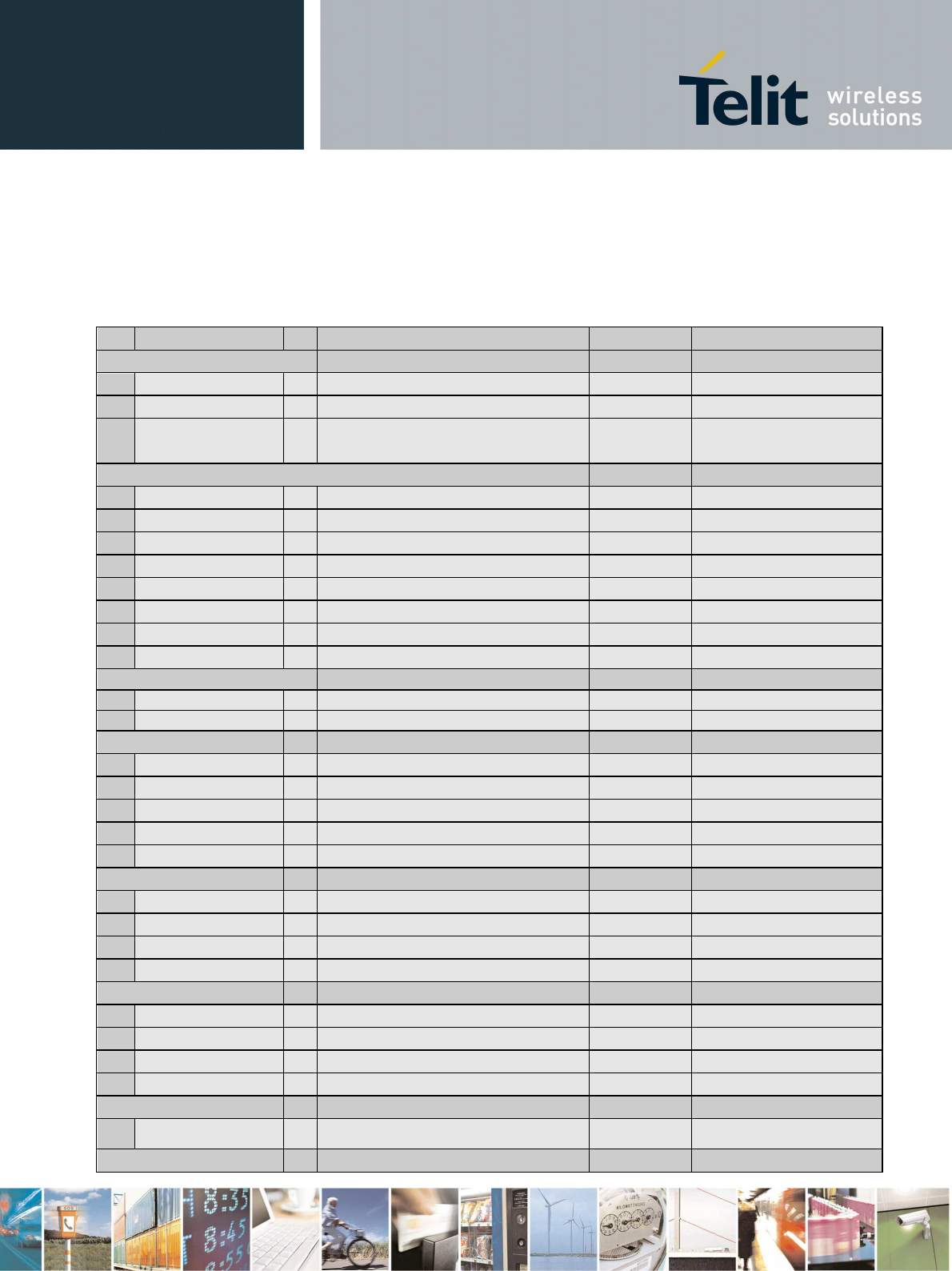
GE910 Hardware User Guide
1vv0300962 Rev.12 2013-10-22
Reproduction forbidden without Telit Communications S.p.A. written authorization - All Rights Reserved
page 11 of 83
Mod. 0805 2011-07 Rev.2
3. GE910 module connections
3.1. PIN-OUT
PAD
Signal I/O Function Type COMMENT
USB 2.0 COMMUNICATION PORT
B15 USB_D+ I/O USB differential Data (+) 3.3V Reserved on GE910-QUAD V3
C15 USB_D- I/O USB differential Data (-) 3.3V Reserved on GE910-QUAD V3
A13 VUSB AI Power sense for USB presence 5V Accepted range 1.8V to 5V
Reserved on GE910-QUAD V3
Asynchronous UART1 – Program / Data + HW Flow Control
N15 C103/TXD I Serial data input from DTE CMOS 1.8V UART1
M15
C104/RXD O Serial data output to DTE CMOS 1.8V UART1
M14
C108/DTR I Input for (DTR) from DTE CMOS 1.8V
L14 C105/RTS I Input for Request to send signal (RTS) from DTE CMOS 1.8V
P15 C106/CTS O Output for Clear to Send signal (CTS) to DTE
CMOS 1.8V
N14 C109/DCD O Output for (DCD) to DTE CMOS 1.8V
P14 C107/DSR O Output for (DSR) to DTE CMOS 1.8V
R14 C125/RING O Output for Ring (RI) to DTE CMOS 1.8V
Asynchronous Auxiliary UART2
D15 TX_AUX O Auxiliary UART (TX Data to DTE) CMOS 1.8V UART2
E15 RX_AUX I Auxiliary UART (RX Data from DTE) CMOS 1.8V UART2
SIM card interface
A6 SIMCLK O External SIM signal – Clock 1.8 / 3V
A7 SIMRST O External SIM signal – Reset 1.8 / 3V
A5 SIMIO I/O External SIM signal – Data I/O 1.8 / 3V
A4 SIMIN I External SIM signal – Presence (active low) CMOS 1.8
A3 SIMVCC - External SIM signal – Power supply for the SIM 1.8 / 3V
Analog Voice Interface
B2
EAR+ AO Ear signal output, phase +
B3
EAR- AO Ear signal output, phase -
B4
MIC+ AI Microphone signal input; phase +
B5
MIC- AI Microphone signal input; phase -
Digital Voice Interface (DVI)
B9 DVI_WA0 I/O Digital Audio Interface (WA0) CMOS 1.8V
B6 DVI_RX I/O Digital Audio Interface (RX) CMOS 1.8V
B7 DVI_TX I/O Digital Audio Interface (TX) CMOS 1.8V
B8 DVI_CLK I/O Digital Audio Interface (CLK) CMOS 1.8V
ADC
B1 ADC_IN1 AI Analog to Digital converter input A/D Values 0 to 1.3V
0 to 1.2V on GE910-QUAD V3
DIGITAL IO
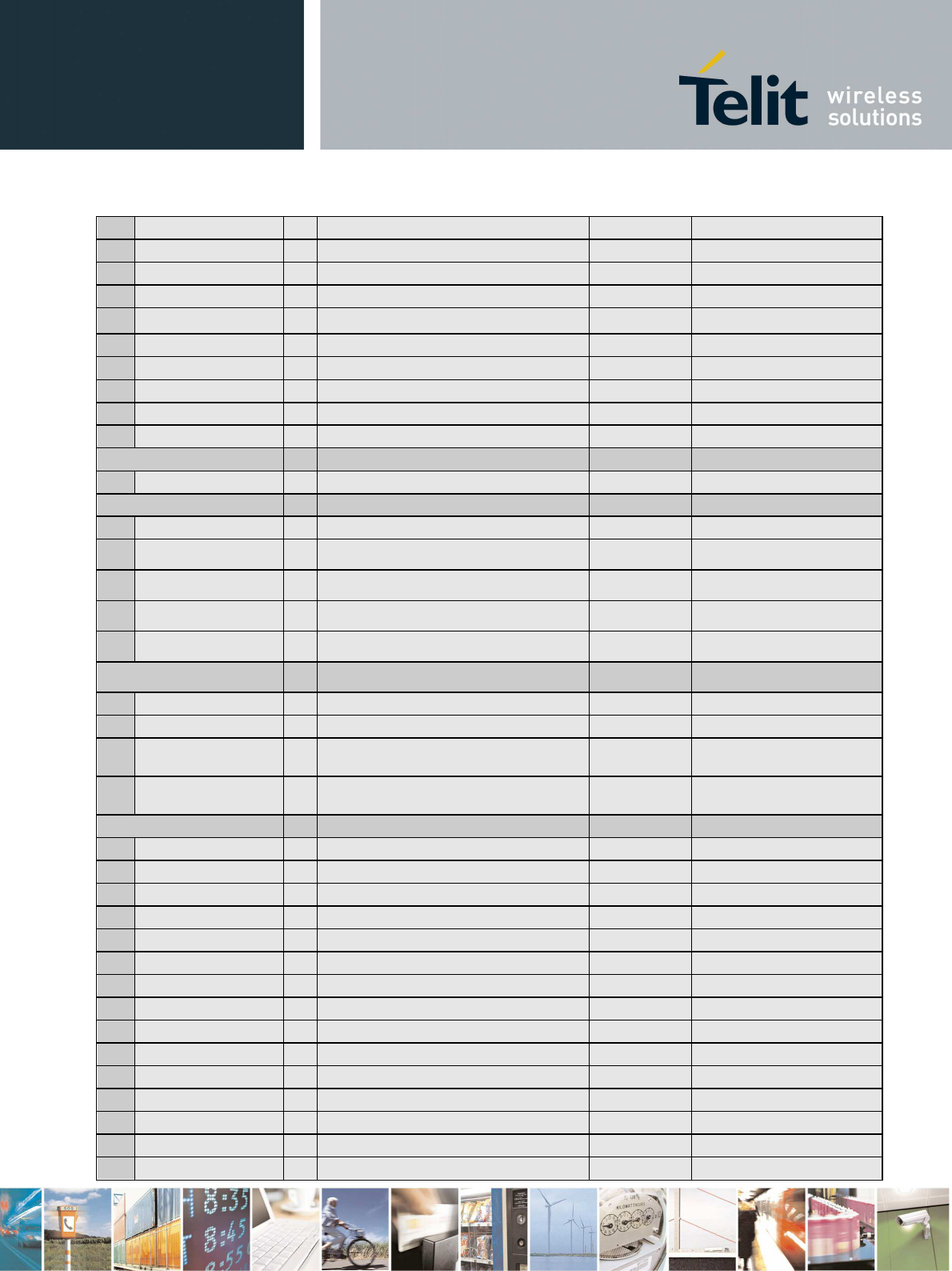
GE910 Hardware User Guide
1vv0300962 Rev.12 2013-10-22
Reproduction forbidden without Telit Communications S.p.A. written authorization - All Rights Reserved
page 12 of 83
Mod. 0805 2011-07 Rev.2
C8 GPIO_01 I/O GPIO_01 / STAT_LED CMOS 1.8V Alternate Function STATUS LED
C9 GPIO_02 I/O GPIO_02 CMOS 1.8V
C10 GPIO_03 I/O GPIO_03 CMOS 1.8V
C11 GPIO_04 I/O GPIO_04 CMOS 1.8V
B14 GPIO_05 I/O GPIO_05 / RFTXMON CMOS 1.8V Alternate Function RFTXMON
C12 GPIO_06 I/O GPIO_06 CMOS 1.8V
C13 GPIO_07 I/O GPIO_07 CMOS 1.8V
K15 GPIO_08 I/O GPIO_08 CMOS 1.8V
L15 GPIO_09 I/O GPIO_09 CMOS 1.8V
G15 GPIO_10 I/O GPIO_10 CMOS 1.8V
RF SECTION GSM
K1 ANTENNA GSM - GSM/GPRS Antenna (50 ohm) RF
GNSS SECTION
R9 ANTENNA GNSS - GNSS Antenna (50 ohm) RF Reserved on GE910-QUAD V3
G14 GNSS_EN* I External GNSS ON-OFF VBATT ref. Open Colector active low
Reserved on GE910-QUAD V3
J14 GNSS_NMEA_TX O UART NMEA Output 1.8V UART3 or GNSS_BOOT
Reserved on GE910-QUAD V3
K14 GNSS_NMEA_RX I UART NMEA Input 1.8V UART3
Reserved on GE910-QUAD V3
R7 GNSS_LNA_EN O GNSS External LNA Enable 1.8V Active Antenna Control
Reserved on GE910-QUAD V3
MISCELLANEOUS
FUNCTIONS
R13 HW_SHUTDOWN* I HW Unconditional Shutdown VBATT ref. Open Colector active low
R12 ON_OFF* I Input command for power ON VRTC 2,3V ref. Open Colector active low
C14 VRTC I VRTC Backup capacitor RTC Power Backup for the embedded RTC
supply, don’t connect to VBATT!
R11 VAUX/PWRMON O Supply Output for external accessories / Power
ON Monitor 1.8V
POWER SUPPLY
M1 VBATT - Main power supply (Baseband) Power
M2 VBATT - Main power supply (Baseband) Power
N1 VBATT_PA - Main power supply (Radio PA) Power
N2 VBATT_PA - Main power supply (Radio PA) Power
P1 VBATT_PA - Main power supply (Radio PA) Power
P2 VBATT_PA - Main power supply (Radio PA) Power
E1 GND - Ground Power
G1 GND - Ground Power
H1 GND - Ground Power
J1 GND - Ground Power
L1 GND - Ground Power
A2 GND - Ground Power
E2 GND - Ground Power
F2 GND - Ground Power
G2 GND - Ground Power
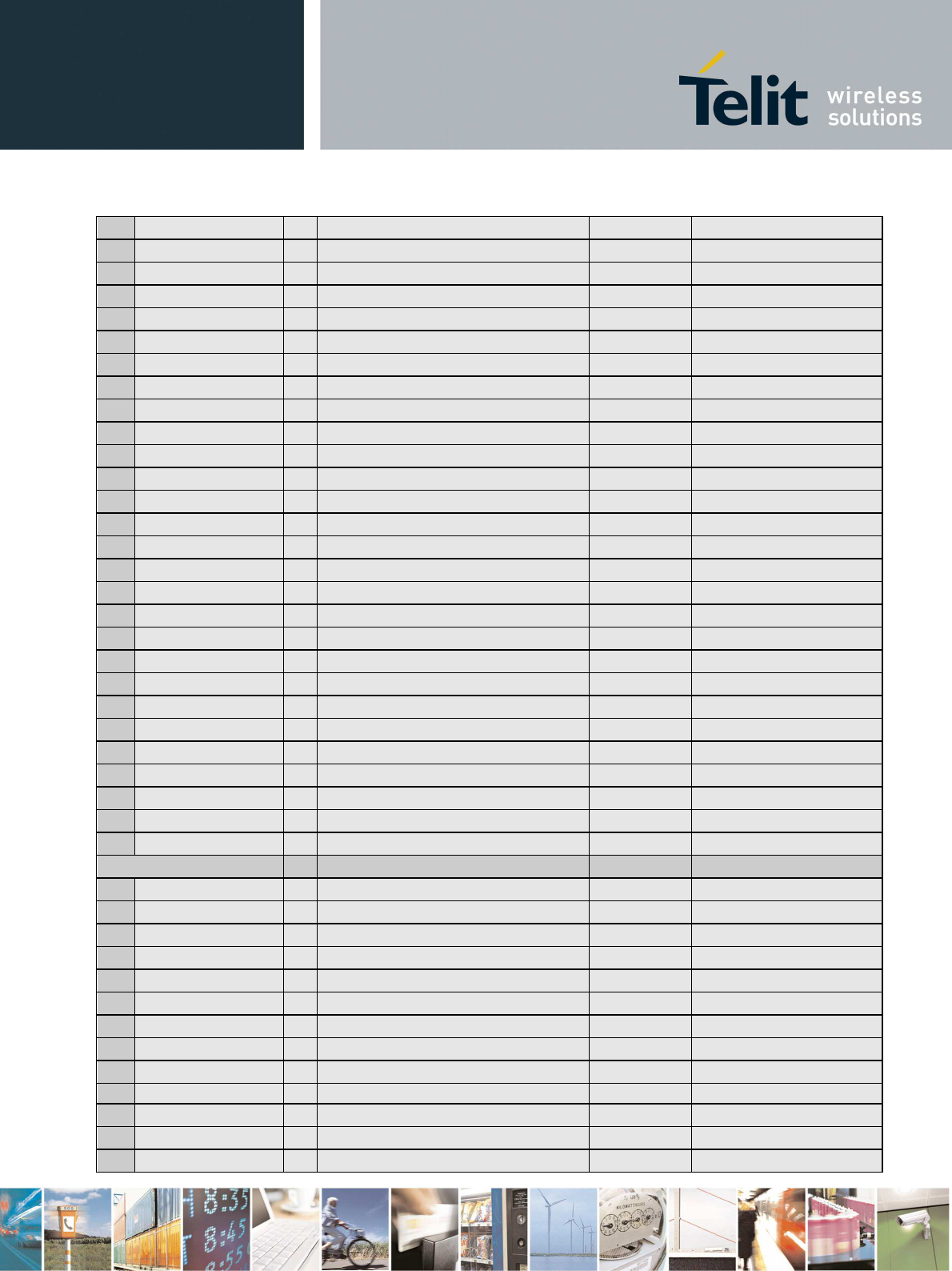
GE910 Hardware User Guide
1vv0300962 Rev.12 2013-10-22
Reproduction forbidden without Telit Communications S.p.A. written authorization - All Rights Reserved
page 13 of 83
Mod. 0805 2011-07 Rev.2
H2 GND - Ground Power
J2 GND - Ground Power
K2 GND - Ground Power
L2 GND - Ground Power
R2 GND - Ground Power
M3 GND - Ground Power
N3 GND - Ground Power
P3 GND - Ground Power
R3 GND - Ground Power
M4 GND - Ground Power
N4 GND - Ground Power
P4 GND - Ground Power
R4 GND - Ground Power
N5 GND - Ground Power
P5 GND - Ground Power
R5 GND - Ground Power
N6 GND - Ground Power
P6 GND - Ground Power
R6 GND - Ground Power
P8 GND - Ground Power
R8 GND - Ground Power
P9 GND - Ground Power
P10 GND - Ground Power
R10 GND - Ground Power
M12
GND - Ground Power
B13 GND - Ground Power
P13 GND - Ground Power
E14 GND - Ground Power
RESERVED
C1 RESERVED - RESERVED
P7 RESERVED - RESERVED
D1 RESERVED - RESERVED
C2 RESERVED - RESERVED
D2 RESERVED - RESERVED
C3 RESERVED - RESERVED
D3 RESERVED - RESERVED
E3 RESERVED - RESERVED
F3 RESERVED - RESERVED
G3 RESERVED - RESERVED
H3 RESERVED - RESERVED
J3 RESERVED - RESERVED
K3 RESERVED - RESERVED
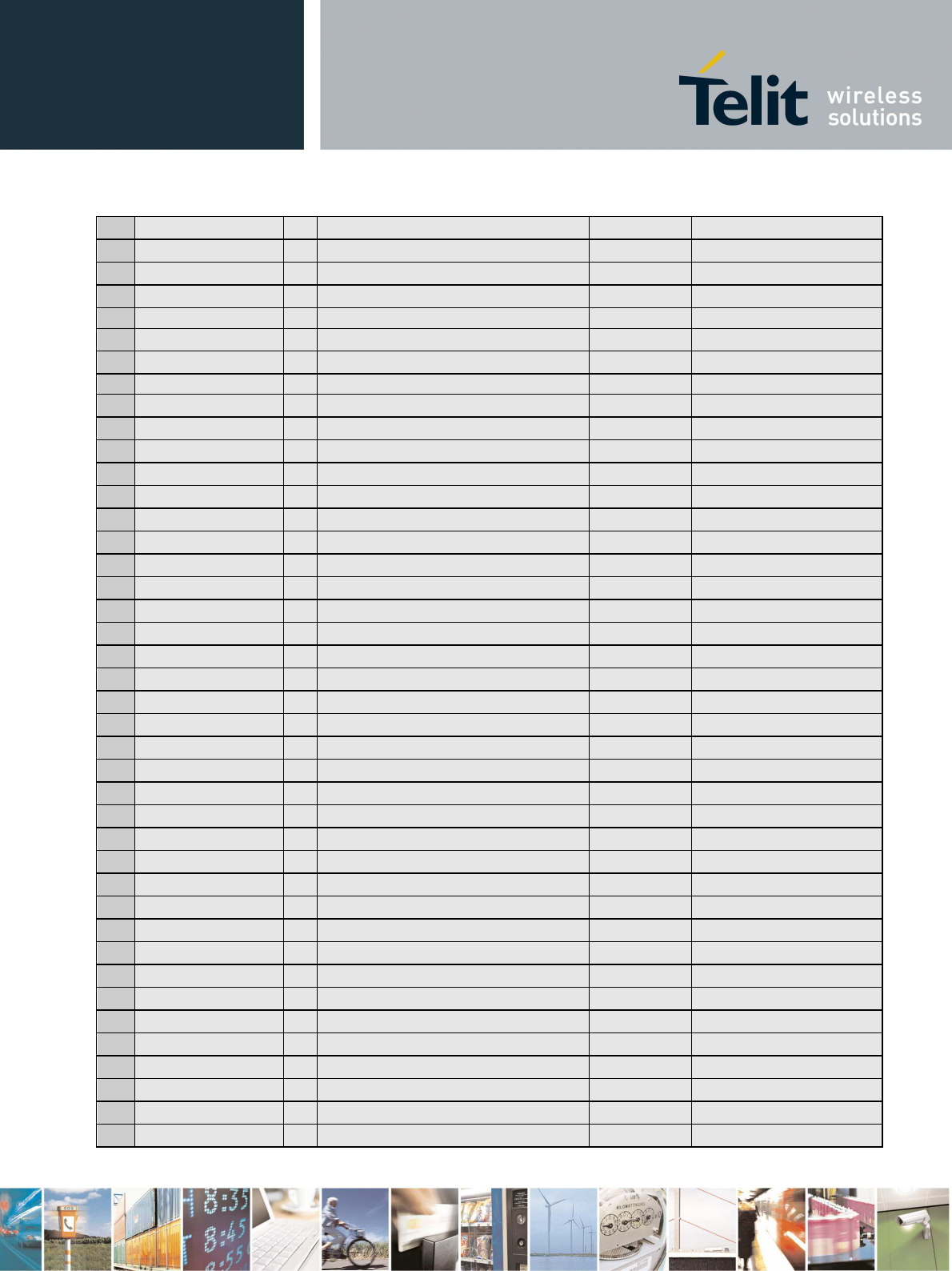
GE910 Hardware User Guide
1vv0300962 Rev.12 2013-10-22
Reproduction forbidden without Telit Communications S.p.A. written authorization - All Rights Reserved
page 14 of 83
Mod. 0805 2011-07 Rev.2
L3 RESERVED - RESERVED
C4 RESERVED - RESERVED
C5 RESERVED - RESERVED
C6 RESERVED - RESERVED
C7 RESERVED - RESERVED
N7 RESERVED - RESERVED
N8 RESERVED - RESERVED
N9 RESERVED - RESERVED
A10 RESERVED - RESERVED
N10 RESERVED - RESERVED
N11 RESERVED - RESERVED
B12 RESERVED - RESERVED
D12 RESERVED - RESERVED
N12 RESERVED - RESERVED
P12 RESERVED - RESERVED
F14 RESERVED - RESERVED
H14 RESERVED - RESERVED
N13 RESERVED - RESERVED
L13 RESERVED - RESERVED
J13 RESERVED - RESERVED
M13
RESERVED - RESERVED
K13 RESERVED - RESERVED
H13 RESERVED - RESERVED
G13 RESERVED - RESERVED
F13 RESERVED - RESERVED
A11 RESERVED - RESERVED
A12 RESERVED - RESERVED
B11 RESERVED - RESERVED
B10 RESERVED - RESERVED
A9 RESERVED - RESERVED
A8 RESERVED - RESERVED
A14 RESERVED - RESERVED
D13 RESERVED - RESERVED
D14 RESERVED - RESERVED
H15 RESERVED - RESERVED
J15 RESERVED - RESERVED
F1 RESERVED - RESERVED
D4 RESERVED - RESERVED
E13 RESERVED - RESERVED
F15 RESERVED - RESERVED
P11 RESERVED - RESERVED
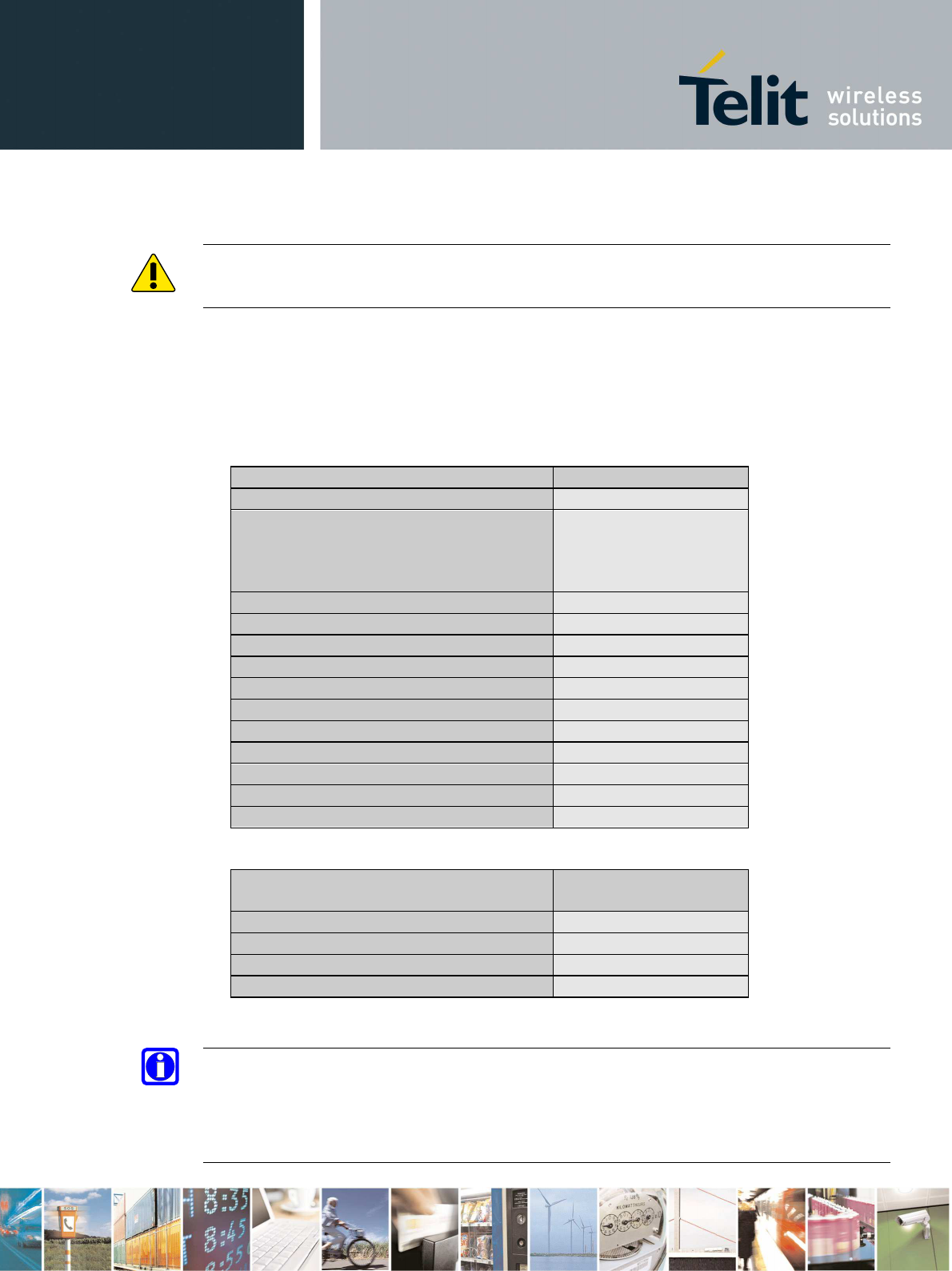
GE910 Hardware User Guide
1vv0300962 Rev.12 2013-10-22
Reproduction forbidden without Telit Communications S.p.A. written authorization - All Rights Reserved
page 15 of 83
Mod. 0805 2011-07 Rev.2
WARNING:
Reserved pins must not be connected.
3.2. Important Pin-out to Debug in customer’s application
The followings pins are necessary to debug the application when the module is assembled on
customer’s application.
We recommend connecting them also to dedicated test point.
PADs for GE910 Signal
M1,M2,N1,N2,P1,P2 VBATT & VBATT_PA
E1,G1,H1,J1,L1,A2,E2,F2,G2,H2,
J2,K2,L2,R2,M3,N3,P3,R3,M4,
N4,P4,R4,N5,P5,R5,N6,P6,R6,P8,
R8,P9,P10,R10,M12,B13,P13,E14
GND
R12 ON/OFF*
R13 HW_SHUTDOWN*
K1 ANTENNA GSM
B15 (
RESERVED
on
GE910
-
QUAD V3
)
USB_D+
C15 (
RESERVED
on
GE910
-
QUAD V3
)
USB_D-
N15 C103/TXD
M15 C104/RXD
L14 C105/RTS
P15 C106/CTS
D15 TXD_AUX
E15 RXD_AUX
ADDITIONAL PADs
for GE910-GNSS only Signal
R9 ANTENNA GNSS
G14 GNSS_EN*
J14 GNSS_NMEA_TX
K14 GNSS_NMEA_RX
NOTE:
Not used pins apart from table above can be left unconnected.
RTS pin should be connected to the GND (on the module side) if flow control is not
used.
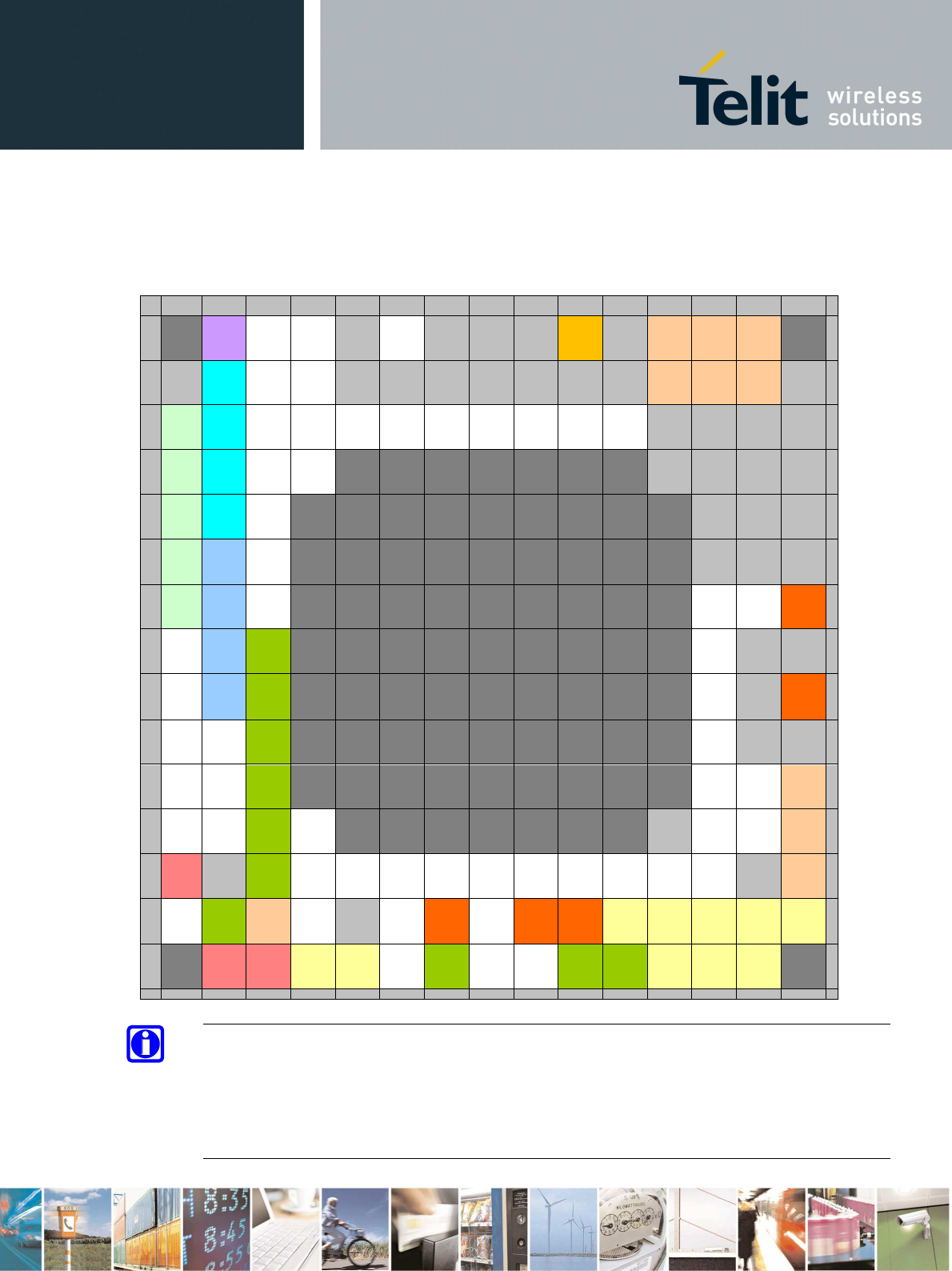
GE910 Hardware User Guide
1vv0300962 Rev.12 2013-10-22
Reproduction forbidden without Telit Communications S.p.A. written authorization - All Rights Reserved
page 16 of 83
Mod. 0805 2011-07 Rev.2
3.3. LGA PADs Layout
TOP VIEW
A B C D E F G H J K L M N P R
1 ADC IN1 RES RES GND RES GND GND GND ANT_GSM GND VBATT VBATT_PA VBATT_PA
2 GND EAR+ RES RES GND GND GND GND GND GND GND VBATT VBATT_PA VBATT_PA GND
3 SIMVCC EAR- RES RES RES RES RES RES RES RES RES GND GND GND GND
4 SIMIN MIC+ RES RES GND GND GND GND
5 SIMIO MIC- RES GND GND GND
6 SIMCLK DVI_RX RES GND GND GND
7 SIMRST DVI_TX RES RES RES GNSS
_LNA_EN
8 RES DVI_CLK GPIO_01 RES GND GND
9 RES DVI_WA0 GPIO_02 RES GND ANT_GNSS
10 RES RES GPIO_03 RES GND GND
11 RES RES GPIO_04 RES RES VAUX /
PWRMON
12 RES RES GPIO_06 RES GND RES RES ON_OFF*
13 USB
_VBUS GND GPIO_07 RES RES RES RES RES RES RES RES RES RES GND HW_SHUT
DOWN*
14 RES GPIO_05 VRTC RES GND RES GNSS_EN* RES GNSS
_NMEA_T
X
GNSS
_NMEA_R
X C105/RTS C108/DTR C109/DCD C107/DSR C125/RING
15 USB_D+ USB_D- TX AUX RX AUX RES GPIO_10 RES RES GPIO_08 GPIO_09 C104/RXD C103/TXD C106/CTS
NOTE:
The pin defined as RES has to be considered RESERVED and not connected on any pin in the
application. The related area on the application has to be kept empty.
Pin G14; J14; K14; R7; R9 are available only on GE910-GNSS variant.
Pin B15; C15; A13 are NOT available on GE910-QUAD V3 variant
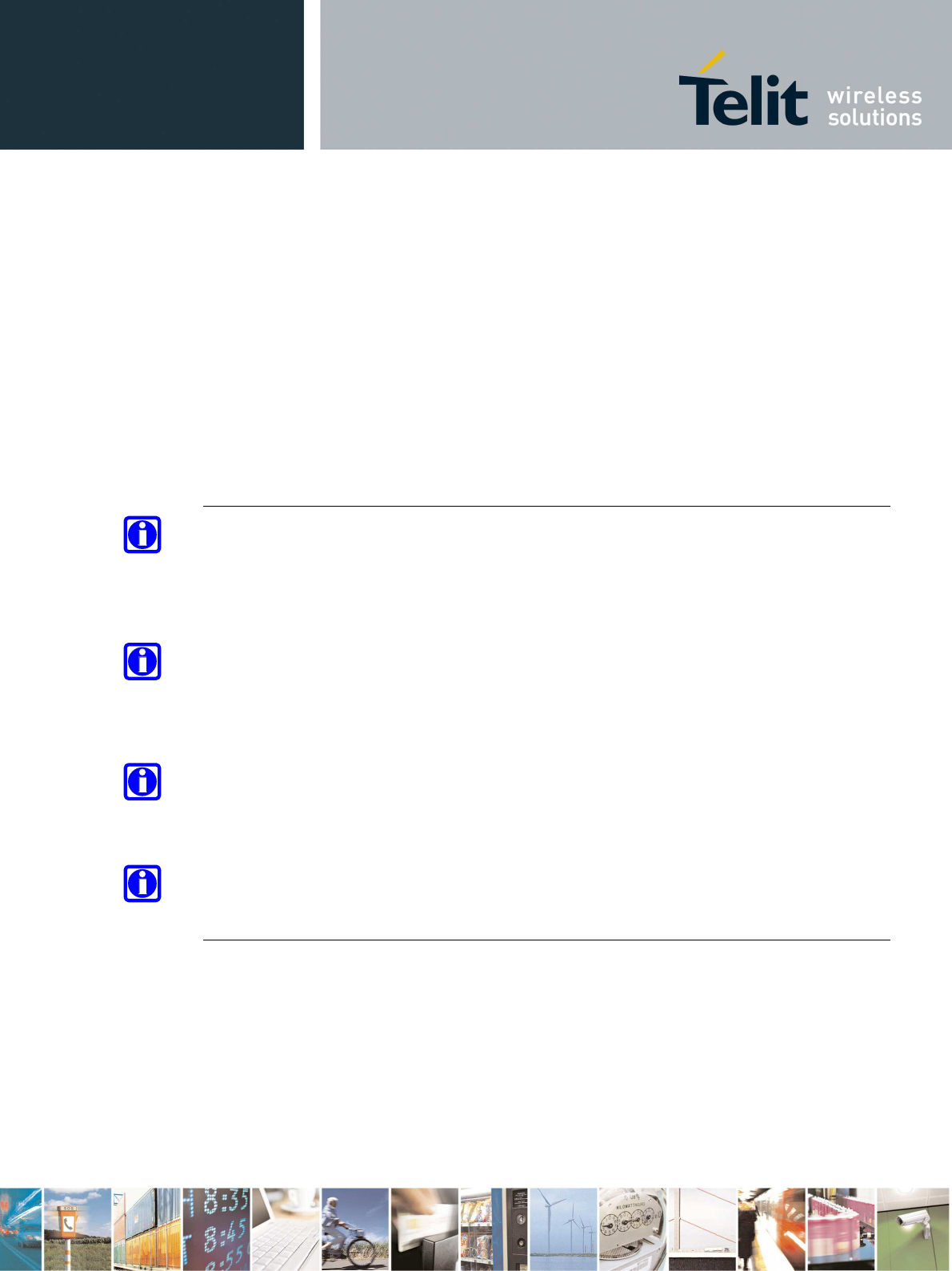
GE910 Hardware User Guide
1vv0300962 Rev.12 2013-10-22
Reproduction forbidden without Telit Communications S.p.A. written authorization - All Rights Reserved
page 17 of 83
Mod. 0805 2011-07 Rev.2
4. Hardware Commands
4.1. Turning ON the GE910
To turn on the GE910 the pad ON-OFF* must be tied low for at least 5 seconds and then
released.
The maximum current that can be drained from the ON-OFF* pad is 0.2mA.
NOTE:
Don't use any pull up resistor on the ON* line, it is internally pulled up. Using pull up resistor
may bring to latch up problems on the GE910 power regulator and improper power on/off of the
module. The line ON* must be connected only in open collector configuration.
NOTE:
In this document all the lines that are inverted, hence have active low signals are labeled with a
name that ends with”*" or with a bar over the name.
TIP:
To check if the device has powered on, the hardware line PWRMON should be monitored. The
device is powered on when PWRMON goes high.
NOTE:
It is mandatory to avoid sending data to the serial ports during the first 200ms of the module
start-up.
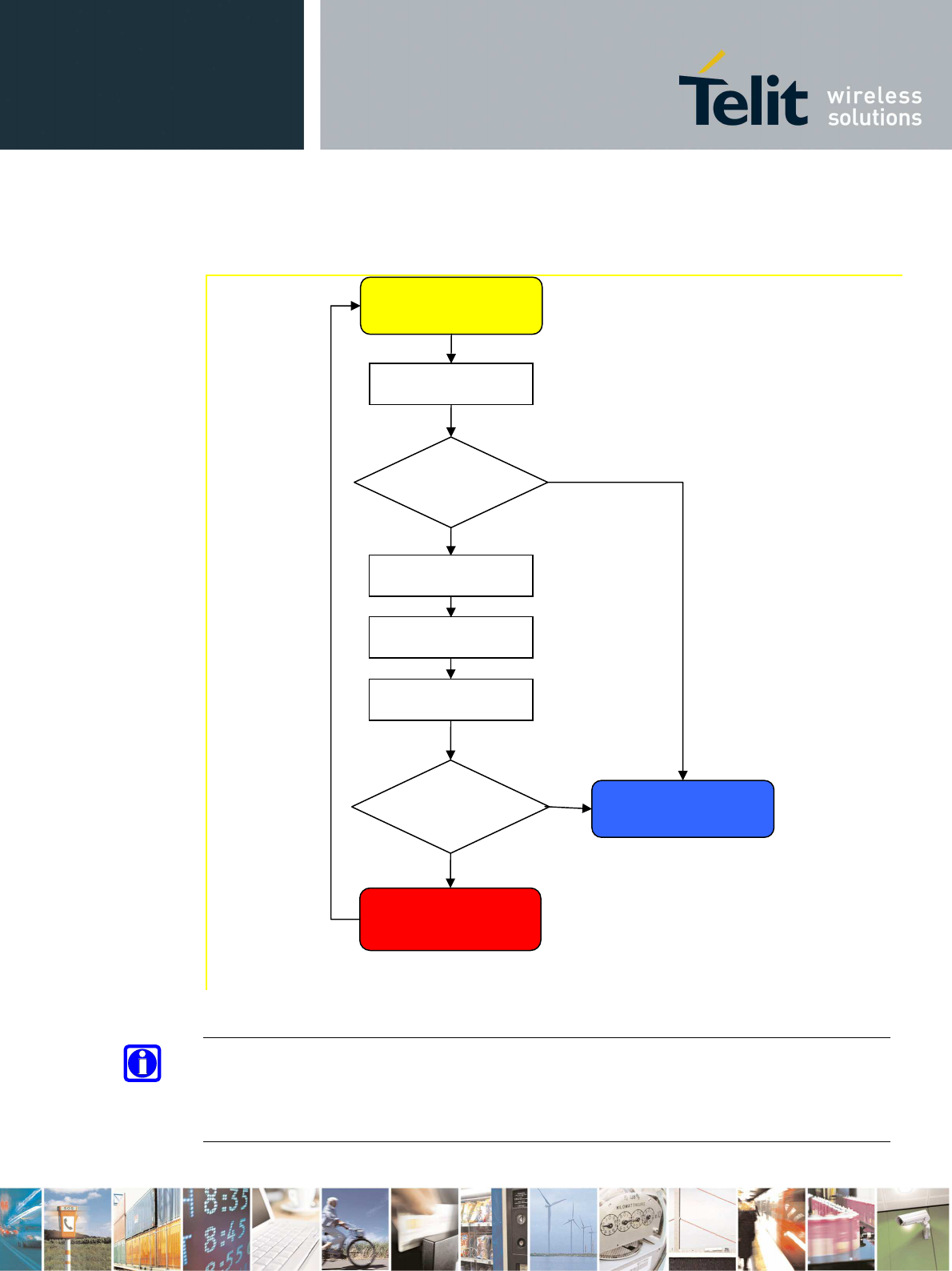
GE910 Hardware User Guide
1vv0300962 Rev.12 2013-10-22
Reproduction forbidden without Telit Communications S.p.A. written authorization - All Rights Reserved
page 18 of 83
Mod. 0805 2011-07 Rev.2
The flow chart showing the proper TURN ON procedure is displayed below:
NOTE:
In order to avoid a back powering effect it is recommended to avoid having any HIGH logic
level signal applied to the digital pins of the GE910 when the module is powered off or during
an ON/OFF transition.
MODEM ON Proc.
Y
N
HW unconditional
SHUTDOWN
Y
PWMON HIGH?
PWMON HIGH?
N
ON_OFF = LOW
WAIT > 5 Sec
ON_OFF = Z
Start AT CMD.
WAIT > 1 Sec
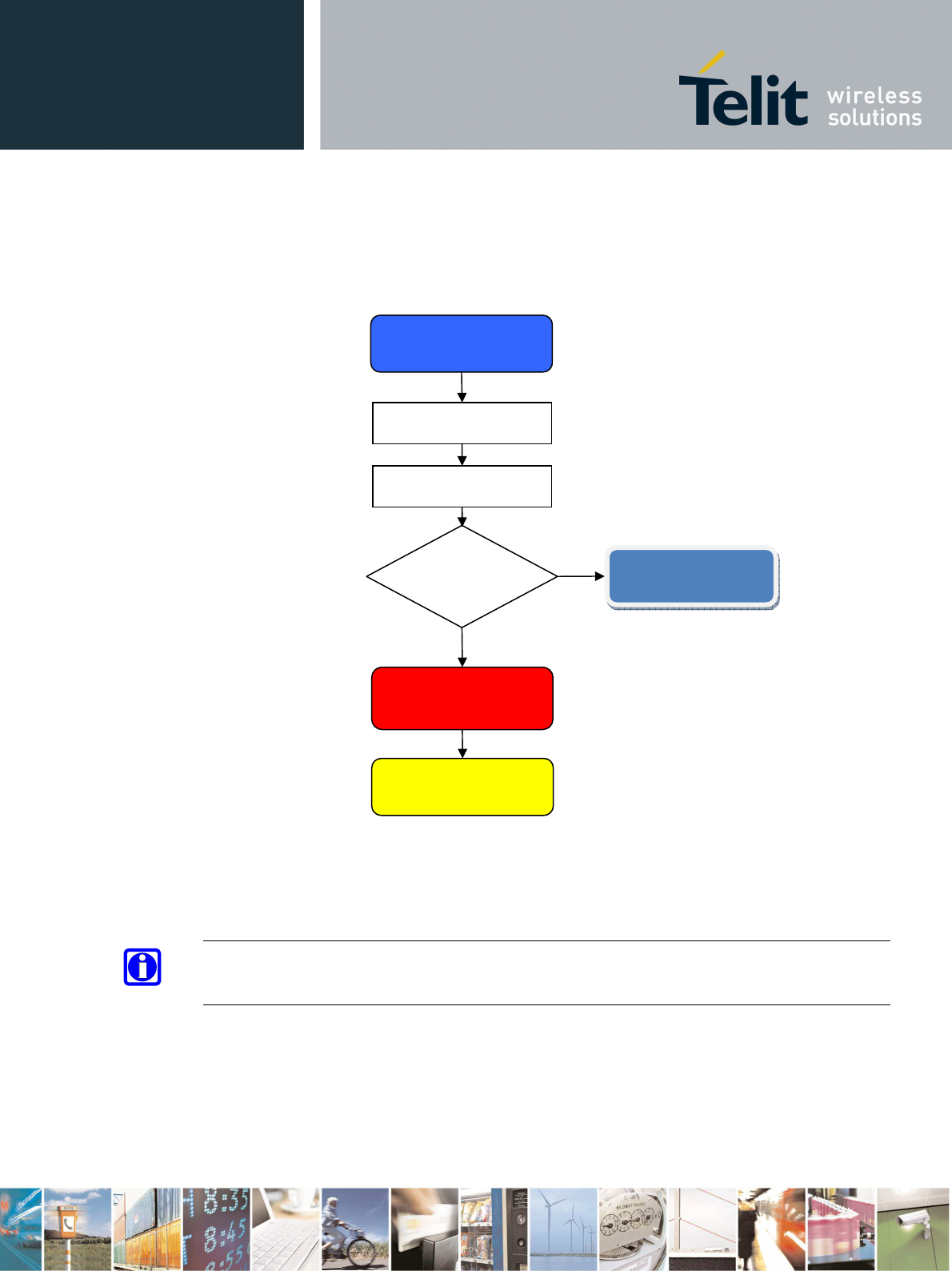
GE910 Hardware User Guide
1vv0300962 Rev.12 2013-10-22
Reproduction forbidden without Telit Communications S.p.A. written authorization - All Rights Reserved
page 19 of 83
Mod. 0805 2011-07 Rev.2
The Flow chart showing the AT commands managing procedure is displayed below:
NOTE:
Do not give any commands before 300 msec after ON/OFF procedure.
AT init sequence.
AT answer ‘OK’
into 1 sec ?
N
DELAY > 300msec
Enter AT<CR>
Start AT CMD.
HW
unconditional
SHUTDOWN
Y
MODEM ON Proc.
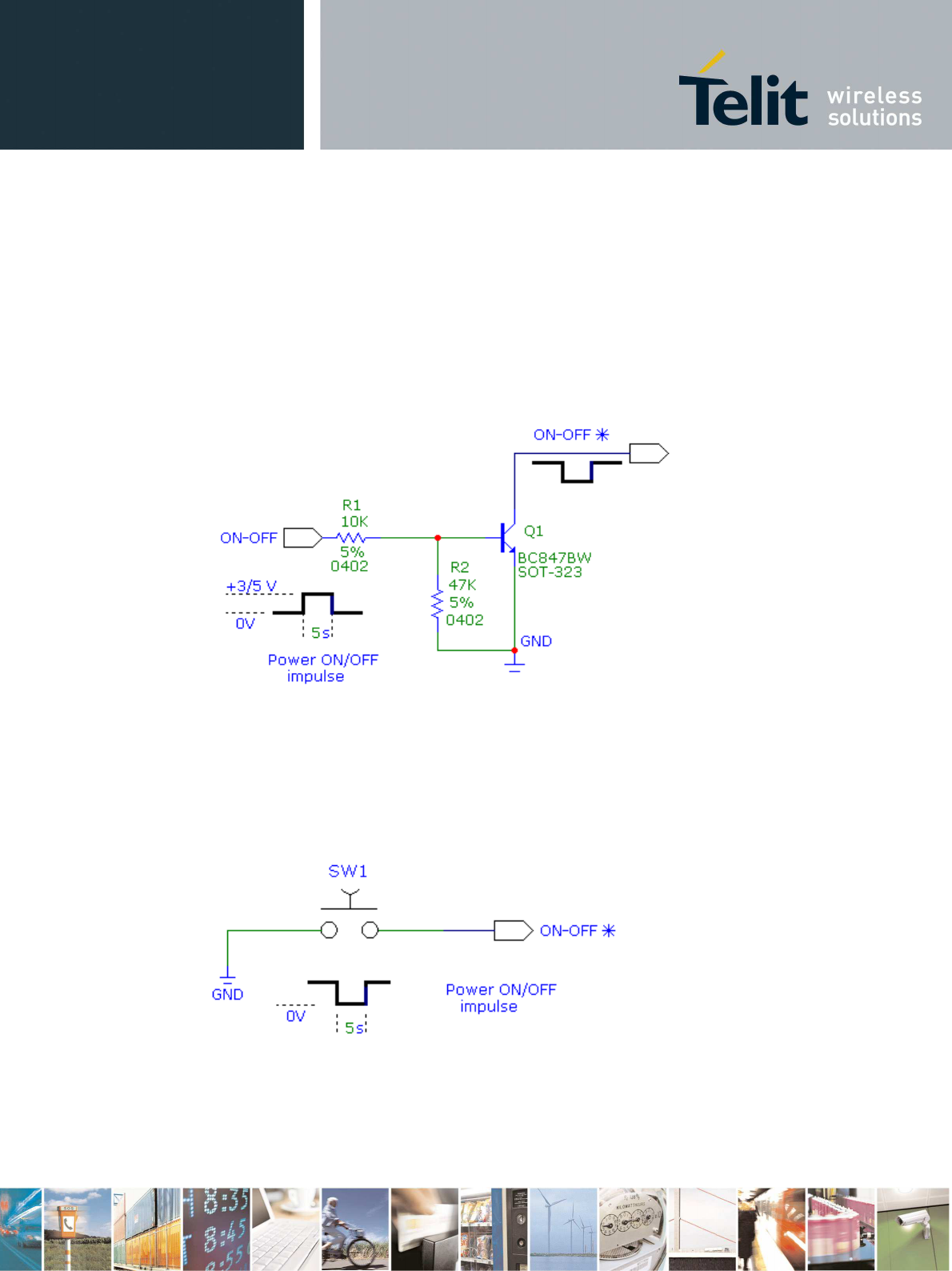
GE910 Hardware User Guide
1vv0300962 Rev.12 2013-10-22
Reproduction forbidden without Telit Communications S.p.A. written authorization - All Rights Reserved
page 20 of 83
Mod. 0805 2011-07 Rev.2
ON-OFF Circuit Examples:
1- If your system does not have Open Collector bus, use this interface:
2- Using a simple ON/OFF external switch:

GE910 Hardware User Guide
1vv0300962 Rev.12 2013-10-22
Reproduction forbidden without Telit Communications S.p.A. written authorization - All Rights Reserved
page 21 of 83
Mod. 0805 2011-07 Rev.2
4.2. Turning OFF the GE910
Turning OFF of the device can be done in two ways:
• via AT command (see GE910 Software User Guide, AT#SHDN)
• by tying low pin ON_OFF* for at least 2s
Either ways, the device issues a detach request to network informing that the device will not
be reachable any more.
To turn OFF the GE910 the pad ON-OFF* must be tied low for at least 2 seconds and then
released.
The same circuitry and timing for the power on must be used.
The device shuts down after the release of the ON-OFF* pad.
TIP:
To check if the device has been powered off, the hardware line PWRMON must be monitored.
The device is powered off when PWRMON goes low.
NOTE:
In order to avoid a back powering effect it is recommended to avoid having any HIGH logic
level signal applied to the digital pins of the GE910 when the module is powered off or during
an ON/OFF transition.
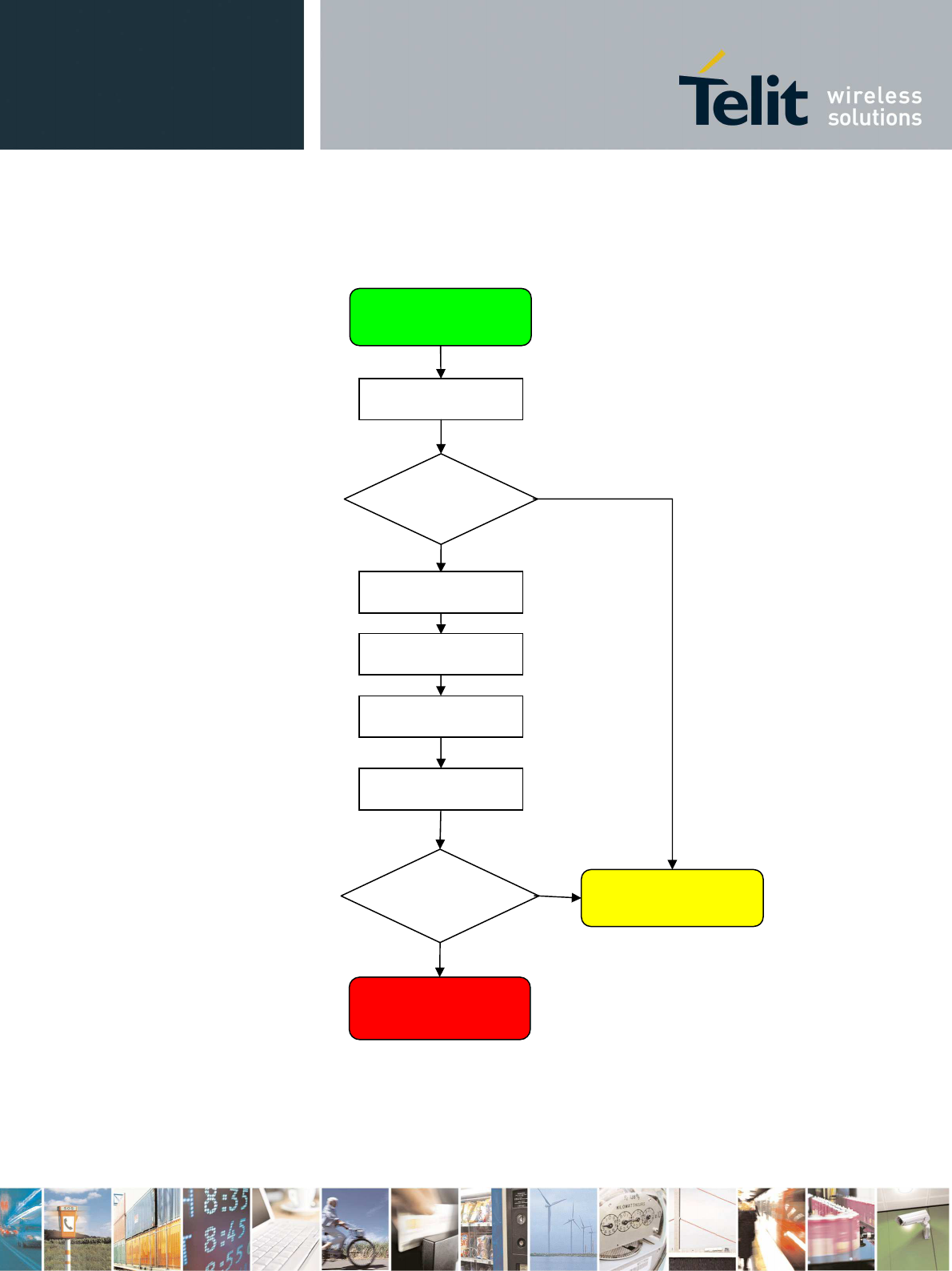
GE910 Hardware User Guide
1vv0300962 Rev.12 2013-10-22
Reproduction forbidden without Telit Communications S.p.A. written authorization - All Rights Reserved
page 22 of 83
Mod. 0805 2011-07 Rev.2
The following flow chart shows the proper HW TURN OFF procedure:
N
Y
HW unconditional
SHUTDOWN
N
PWMON HIGH?
PWMON HIGH?
Y
ON_OFF = LOW
WAIT > 2s
ON_OFF = Z
MODEM OFF Proc.
MODEM ON Proc.
WAIT > 15s
WAIT > 1 Sec
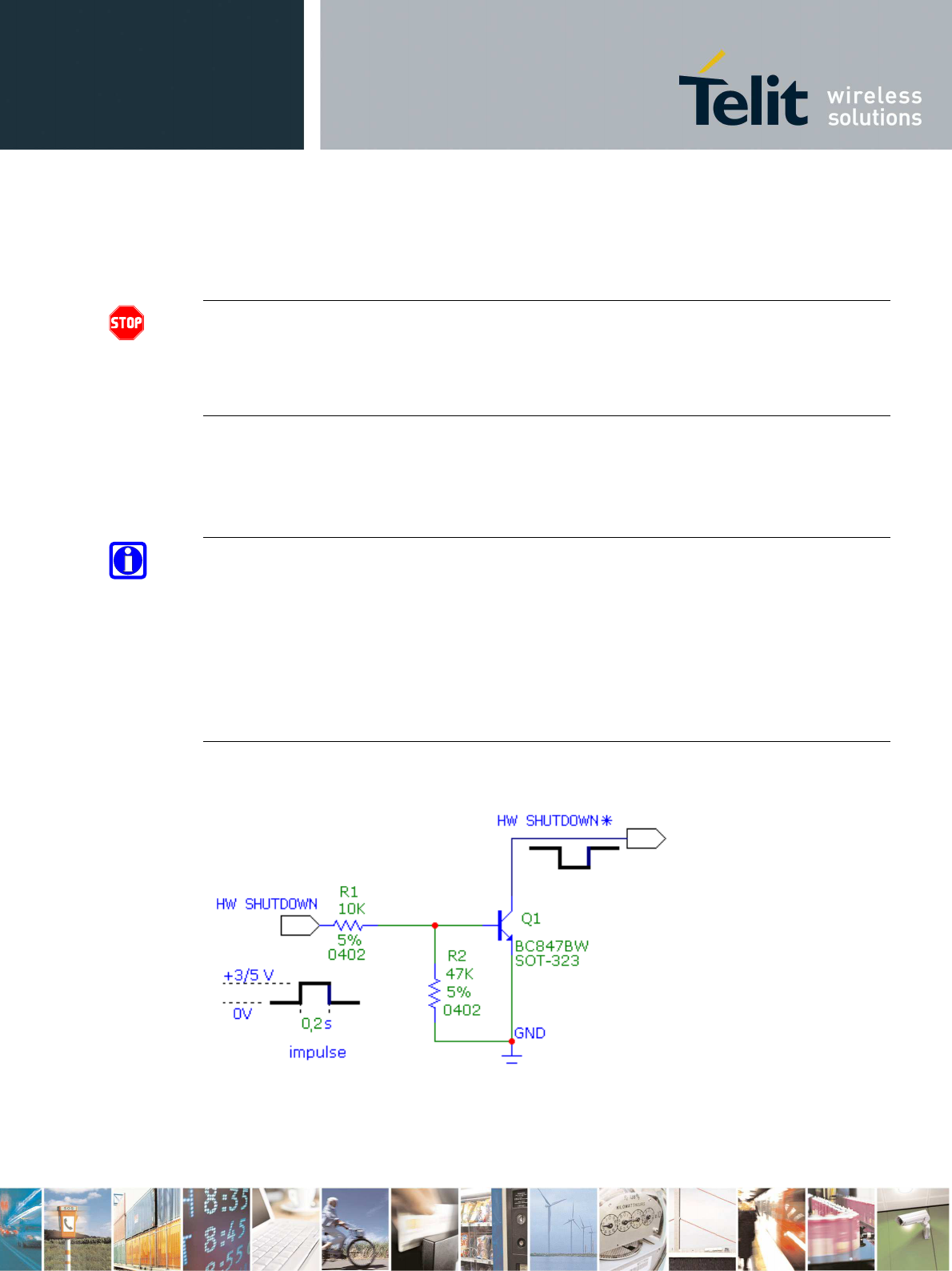
GE910 Hardware User Guide
1vv0300962 Rev.12 2013-10-22
Reproduction forbidden without Telit Communications S.p.A. written authorization - All Rights Reserved
page 23 of 83
Mod. 0805 2011-07 Rev.2
4.3. HW Unconditional Shutdown on GE910
WARNING:
The hardware unconditional Shutdown must not be used during normal operation of the device
since it does not detach the device from the network. It shall be kept as an emergency exit
procedure to be done in the rare case that the device gets stacked waiting for some network or
SIM responses.
To unconditionally Shutdown the GE910, the pad HW_SHUTDOWN* must be tied low for at
least 200 milliseconds and then released. After this operation the module is in OFF condition.
The maximum current that can be drained from the HW_SHUTDOWN* pad is 0,4 mA.
NOTE:
Do not use any pull up resistor on the HW_SHUTDOWN* line or any totem pole digital output.
Using pull up resistor may bring to latch up problems on the GE910 power regulator and
improper functioning of the module. The line HW_SHUTDOWN* must be connected only in
open collector configuration, since it is already internally pull-up to VBATT.
TIP:
The unconditional hardware shutdown must always be implemented on the boards and the
software must use it as an emergency exit procedure.
A simple circuit to do it is:
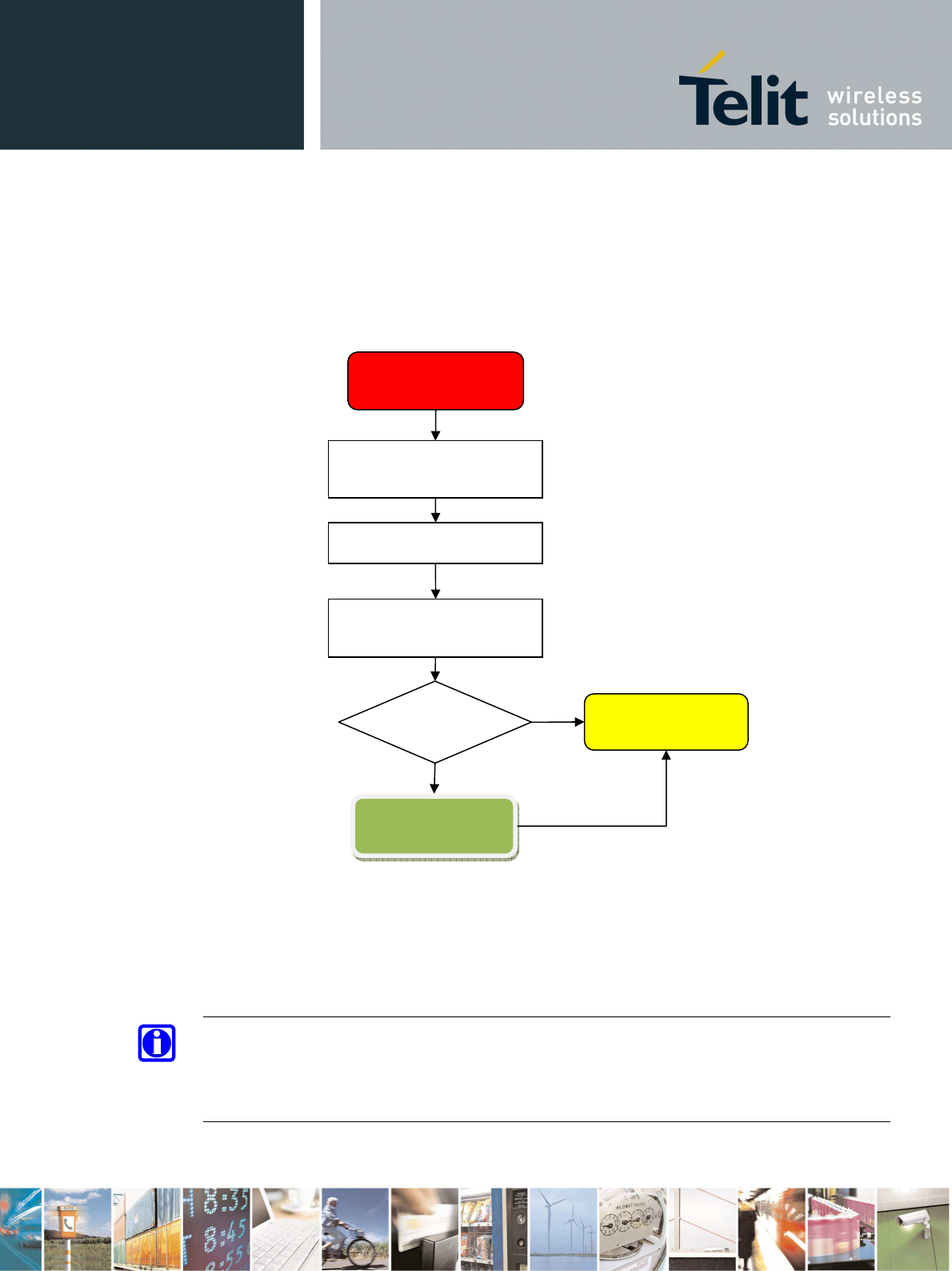
GE910 Hardware User Guide
1vv0300962 Rev.12 2013-10-22
Reproduction forbidden without Telit Communications S.p.A. written authorization - All Rights Reserved
page 24 of 83
Mod. 0805 2011-07 Rev.2
In the following flow chart is detailed the proper HW restart procedure:
NOTE:
In order to avoid a back powering effect it is recommended to avoid having any HIGH logic
level signal applied to the digital pins of the GE910 when the module is powered off or during
an ON/OFF transition.
HW
unconditional
SHUTDOWN
HW SHUTDOWN* =
LOW
Delay > 200ms
HW SHUTDOWN* =
Z
PWRMON = HIGH
Modem ON Proc.
N
Y
Disconnect PWR
supply
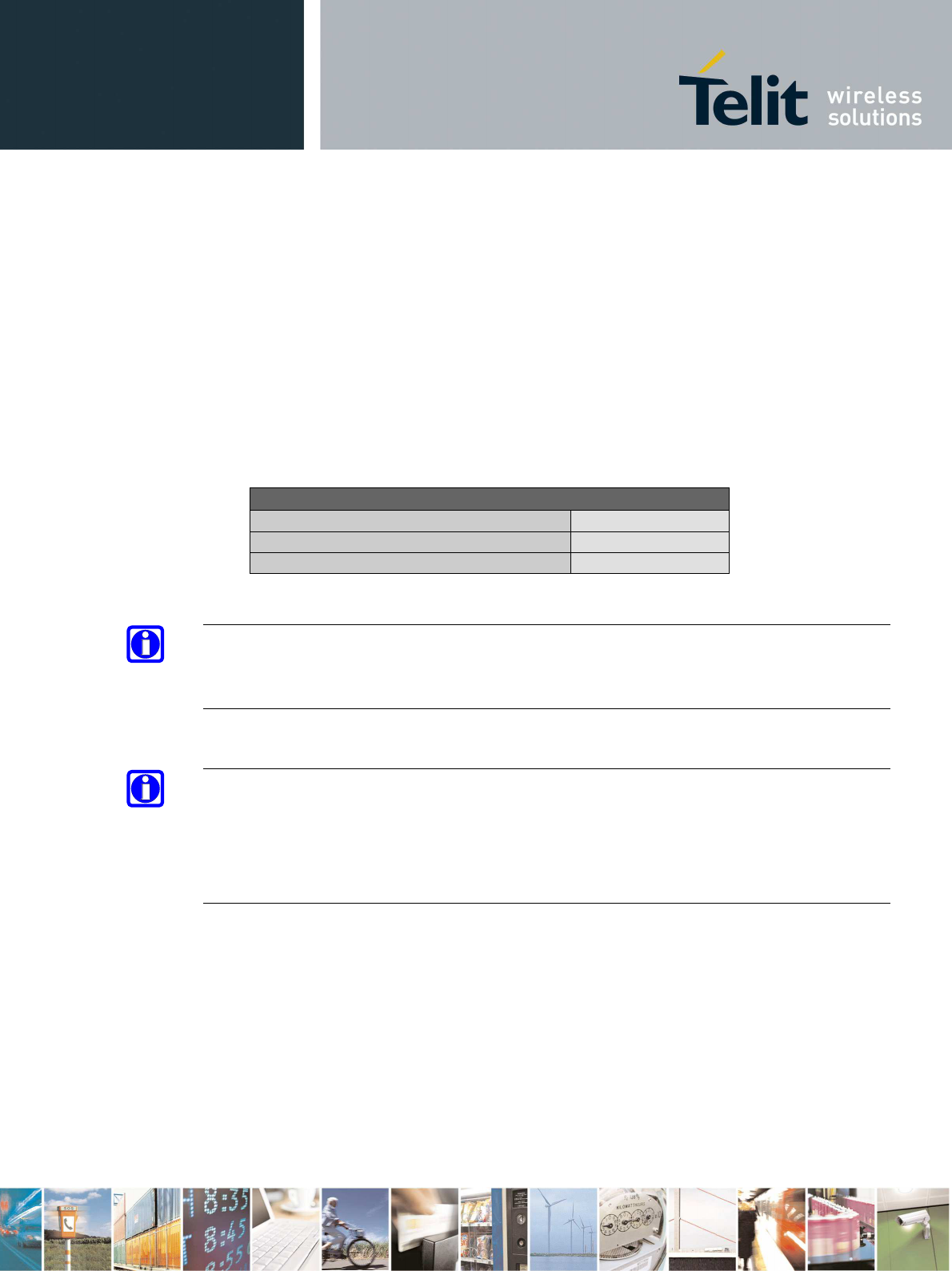
GE910 Hardware User Guide
1vv0300962 Rev.12 2013-10-22
Reproduction forbidden without Telit Communications S.p.A. written authorization - All Rights Reserved
page 25 of 83
Mod. 0805 2011-07 Rev.2
5. Power Supply
The power supply circuitry and board layout are a very important part in the full product design
and they strongly reflect on the product overall performances, hence read carefully the
requirements and the guidelines that will follow for a proper design.
5.1. Power Supply Requirements
The external power supply must be connected to VBATT & VBATT_PA signals and must
fulfill the following requirements:
POWER SUPPLY
Nominal Supply Voltage
3.8 V
Normal Operating Voltage Range
3.40 V÷ 4.20 V
Extended Operating Voltage Range
3.20 V÷ 4.50 V
NOTE:
The Operating Voltage Range MUST never be exceeded; care must be taken in order to fulfil
min/max voltage requirement.
NOTE:
Overshoot voltage (regarding MAX Extended Operating Voltage) and drop in voltage
(regarding MIN Extended Operating Voltage) MUST never be exceeded;
The “Extended Operating Voltage Range” can be used only with completely assumption and
application of the HW User guide suggestions.
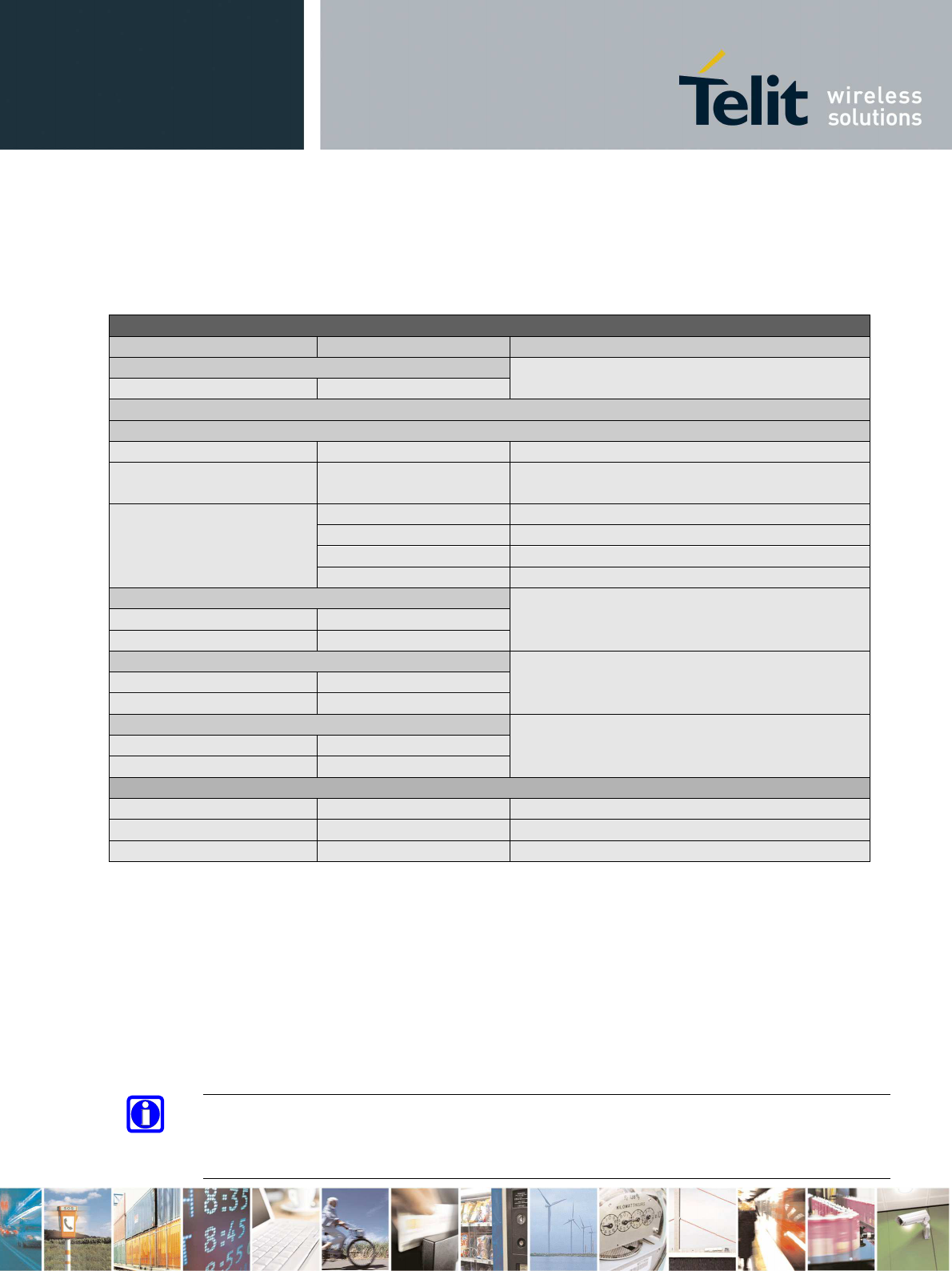
GE910 Hardware User Guide
1vv0300962 Rev.12 2013-10-22
Reproduction forbidden without Telit Communications S.p.A. written authorization - All Rights Reserved
page 26 of 83
Mod. 0805 2011-07 Rev.2
5.2. Power Consumption
The GE910 power consumptions are:
GE910
Mode Average (mA) @3.8V Mode description
GSM+GNSS SWITCHED OFF Module supplied but Switched Off
Switched Off 100uA
GSM mode only
IDLE mode
AT+CFUN=1 21 Normal mode: full functionality of the module
AT+CFUN=4 18 Disabled TX and RX; module is not registered
on the network
AT+CFUN=0 or =5
3,8 Paging Multiframe 2
2,5 Paging Multiframe 3
2,4 Paging Multiframe 4
1,2 Paging Multiframe 9
VOICE TX and RX mode GSM VOICE CALL GSM900 VOICE PL5 230
DCS1800 VOICE PL0 175
GPRS (class 1) 1TX + 1RX GPRS Sending data mode GSM900 PL5 225
DCS1800 PL0 160
GPRS (class 10) 2TX + 3RX GPRS Sending data mode GSM900 PL5 360
DCS1800 PL0 290
GNSS mode only
Tracking GPS 55
Tracking GNSS 65
Acquisition (GNSS) 98
The GSM system is made in a way that the RF transmission is not continuous, else it is packed
into bursts at a base frequency of about 216 Hz, and the relative current peaks can be as high as
about 2A. Therefore the power supply has to be designed in order to withstand with these
current peaks without big voltage drops; this means that both the electrical design and the board
layout must be designed for this current flow.
If the layout of the PCB is not well designed a strong noise floor is generated on the ground and
the supply; this will reflect on all the audio paths producing an audible annoying noise at 216
Hz; if the voltage drop during the peak current absorption is too much, then the device may even
shutdown as a consequence of the supply voltage drop.
NOTE:
The electrical design for the Power supply should be made ensuring it will be capable of a peak
current output of at least 2 A.
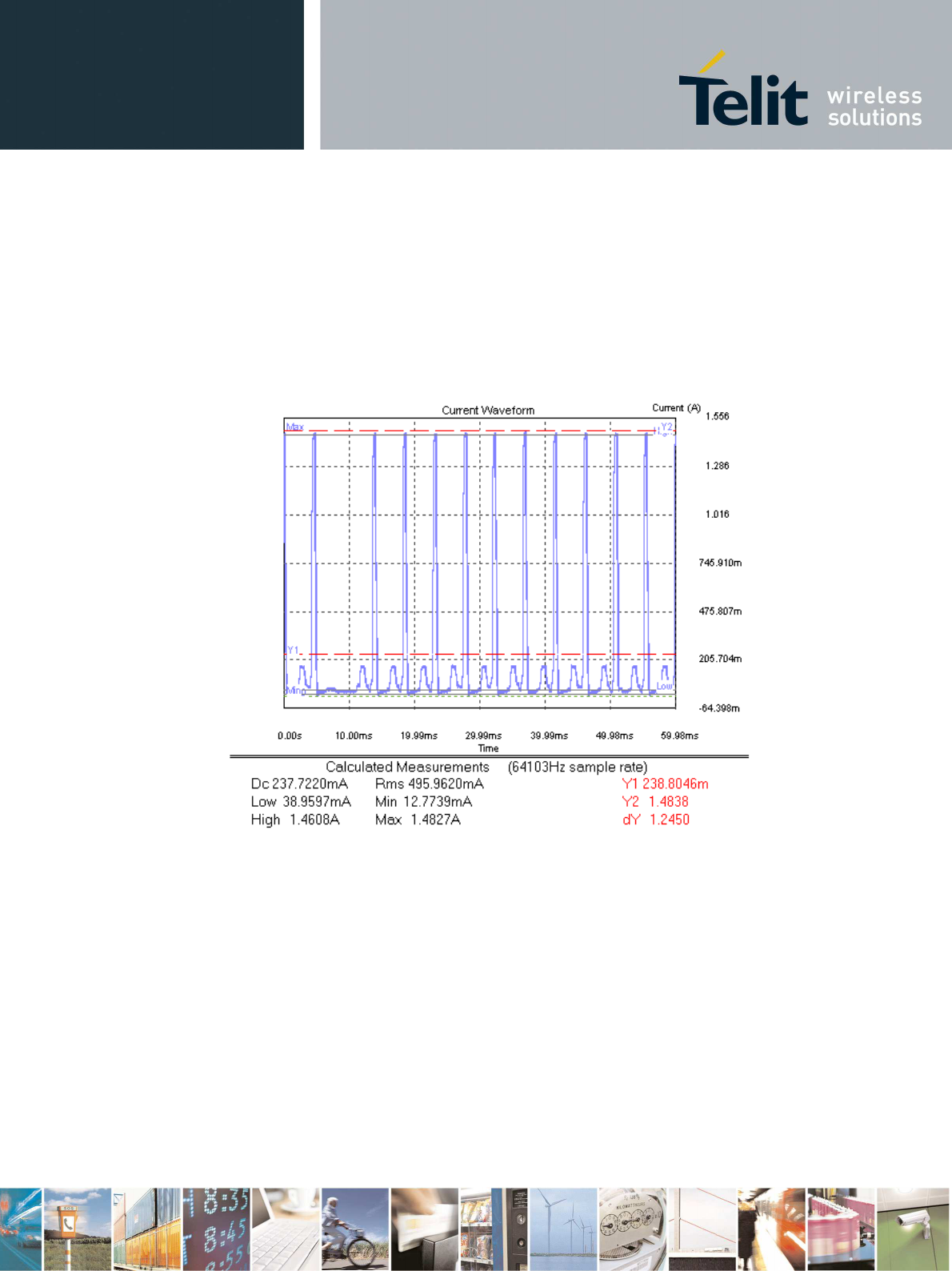
GE910 Hardware User Guide
1vv0300962 Rev.12 2013-10-22
Reproduction forbidden without Telit Communications S.p.A. written authorization - All Rights Reserved
page 27 of 83
Mod. 0805 2011-07 Rev.2
5.2.1. Power consumption Plots
This document section is showing the typical Current consumption plots (using Agilent 66319D)
in the normal working conditions of the module.
GSM900 – Voice Call – Power level 5
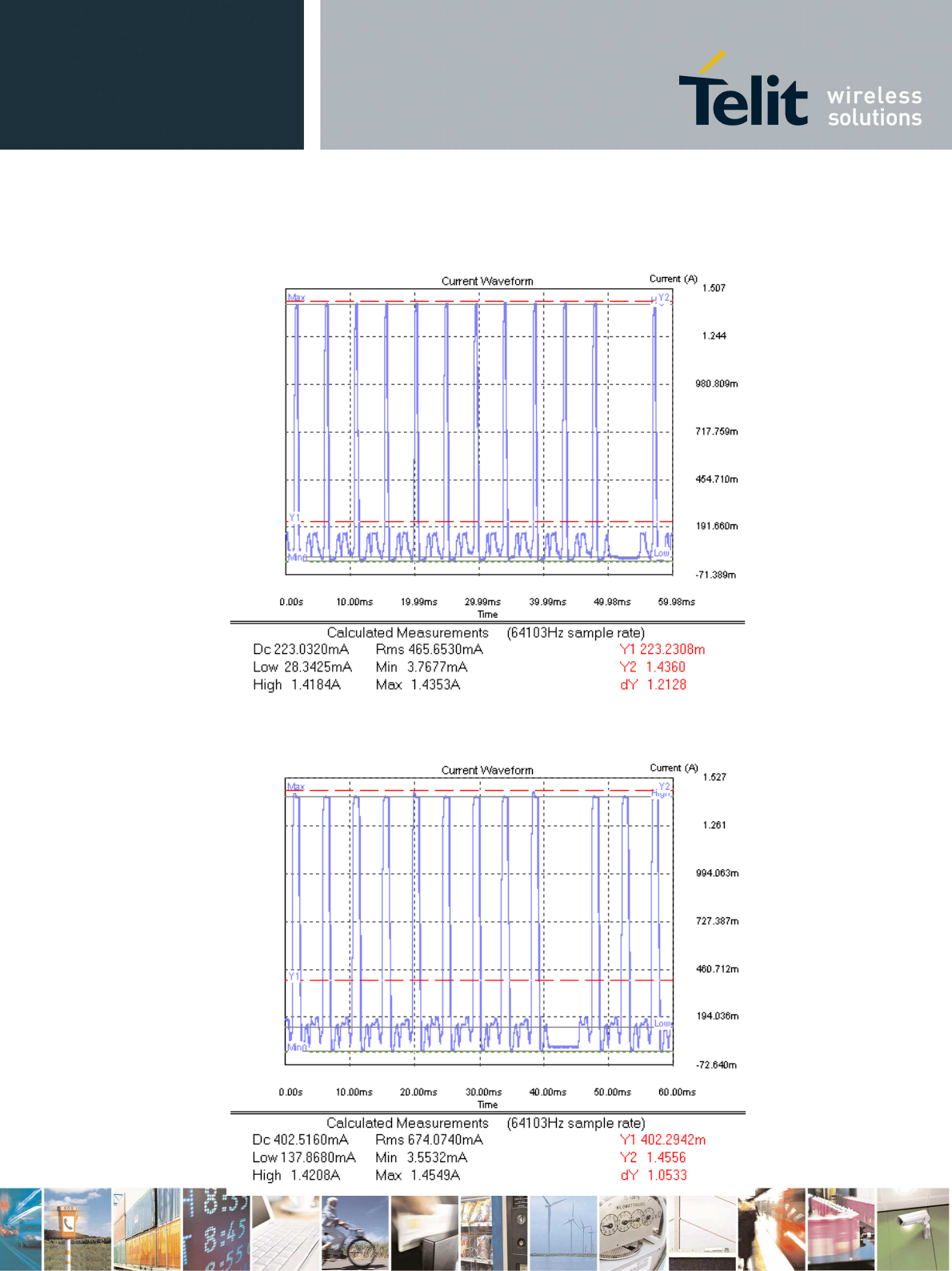
GE910 Hardware User Guide
1vv0300962 Rev.12 2013-10-22
Reproduction forbidden without Telit Communications S.p.A. written authorization - All Rights Reserved
page 28 of 83
Mod. 0805 2011-07 Rev.2
GSM900 – GPRS Call – Power level 5 - 1 Slot TX
GSM900 – GPRS Call – Power level 5 - 2 Slot TX, 3 Slot RX
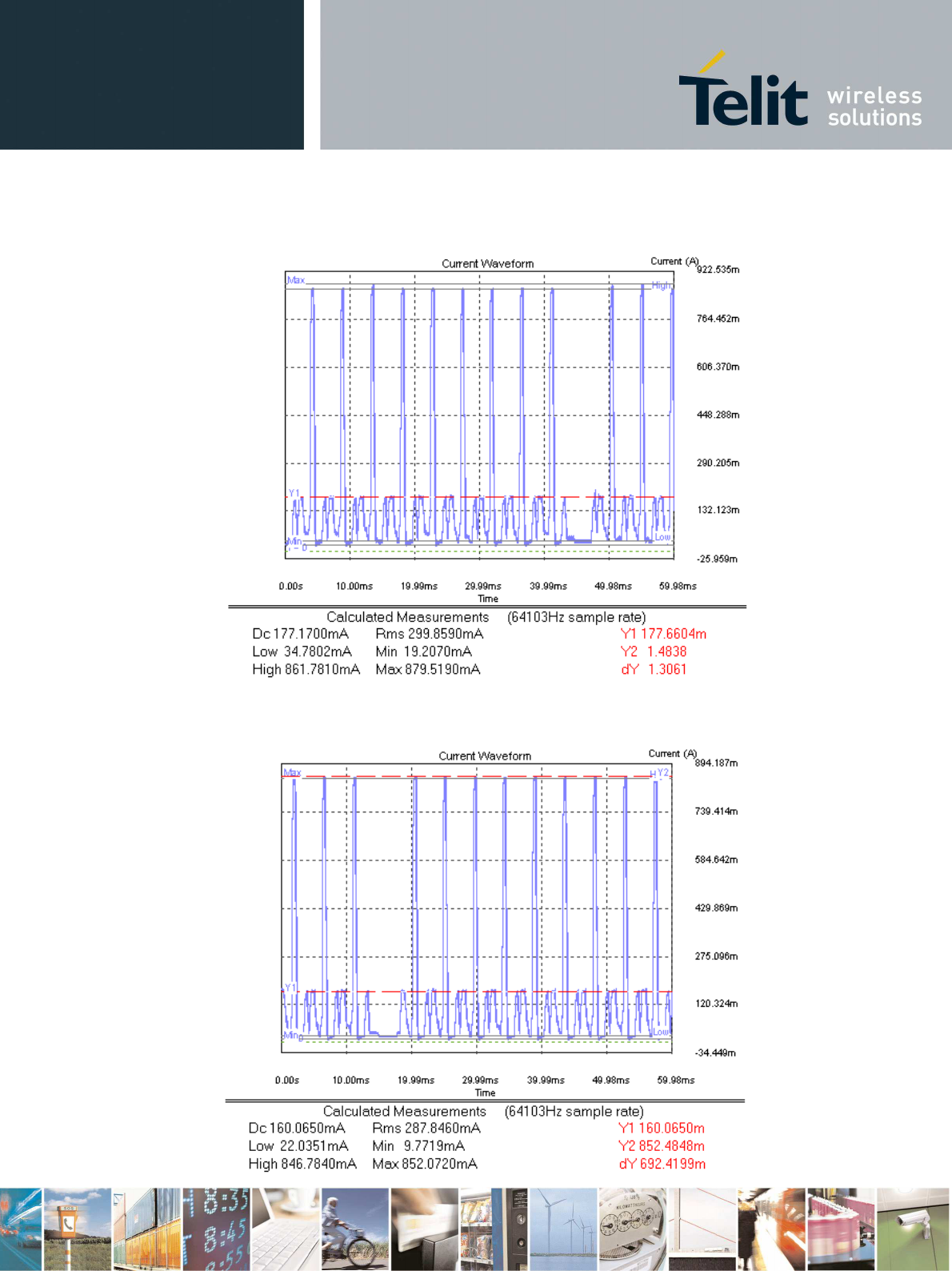
GE910 Hardware User Guide
1vv0300962 Rev.12 2013-10-22
Reproduction forbidden without Telit Communications S.p.A. written authorization - All Rights Reserved
page 29 of 83
Mod. 0805 2011-07 Rev.2
DCS1800 – Voice Call – Power level 0
DCS1800 – GPRS Call – Power level 0 – 1 Slot TX
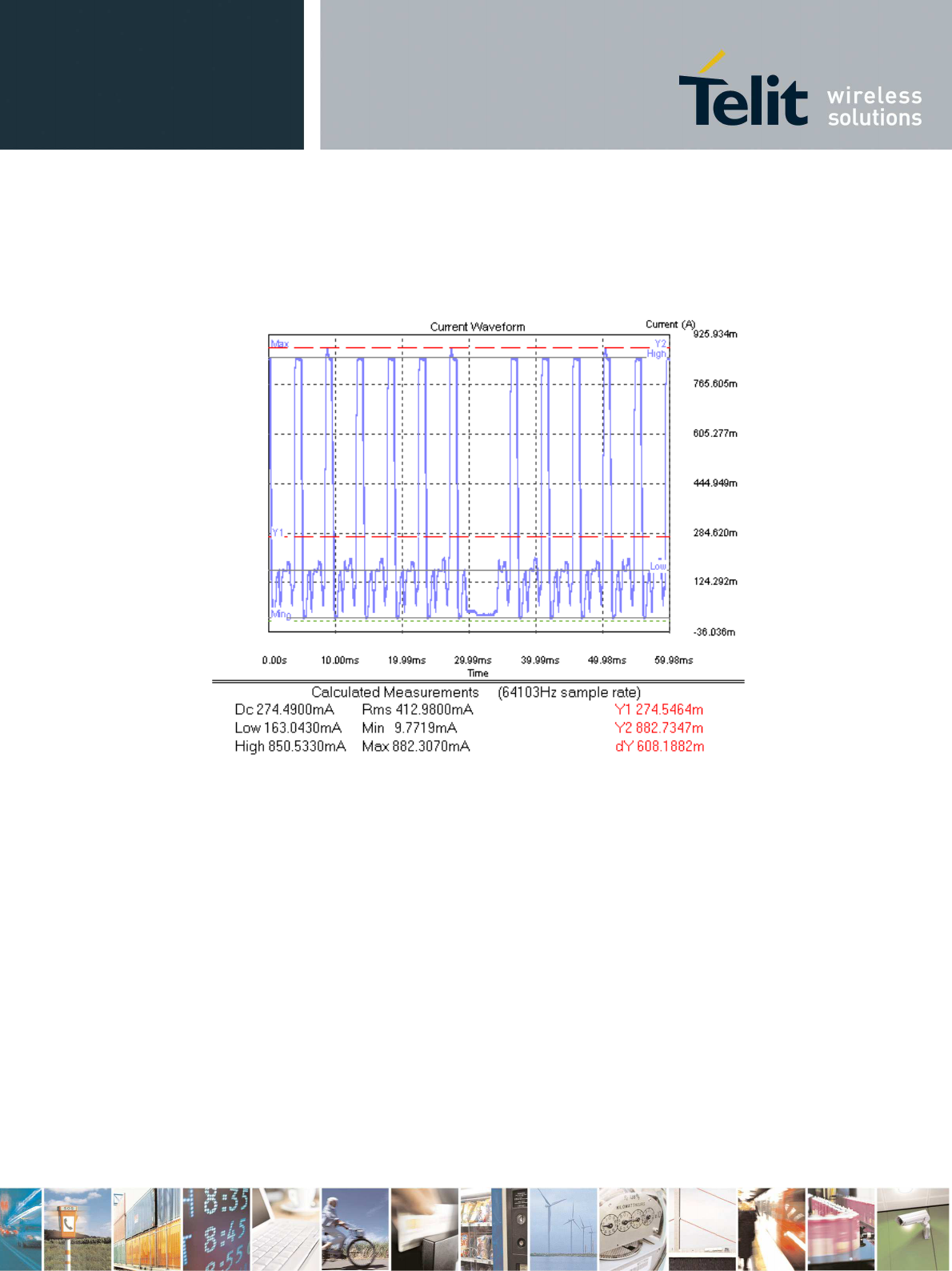
GE910 Hardware User Guide
1vv0300962 Rev.12 2013-10-22
Reproduction forbidden without Telit Communications S.p.A. written authorization - All Rights Reserved
page 30 of 83
Mod. 0805 2011-07 Rev.2
PCS1900 – GPRS Call – Power level 0 - 2 Slot TX, 3 Slot RX
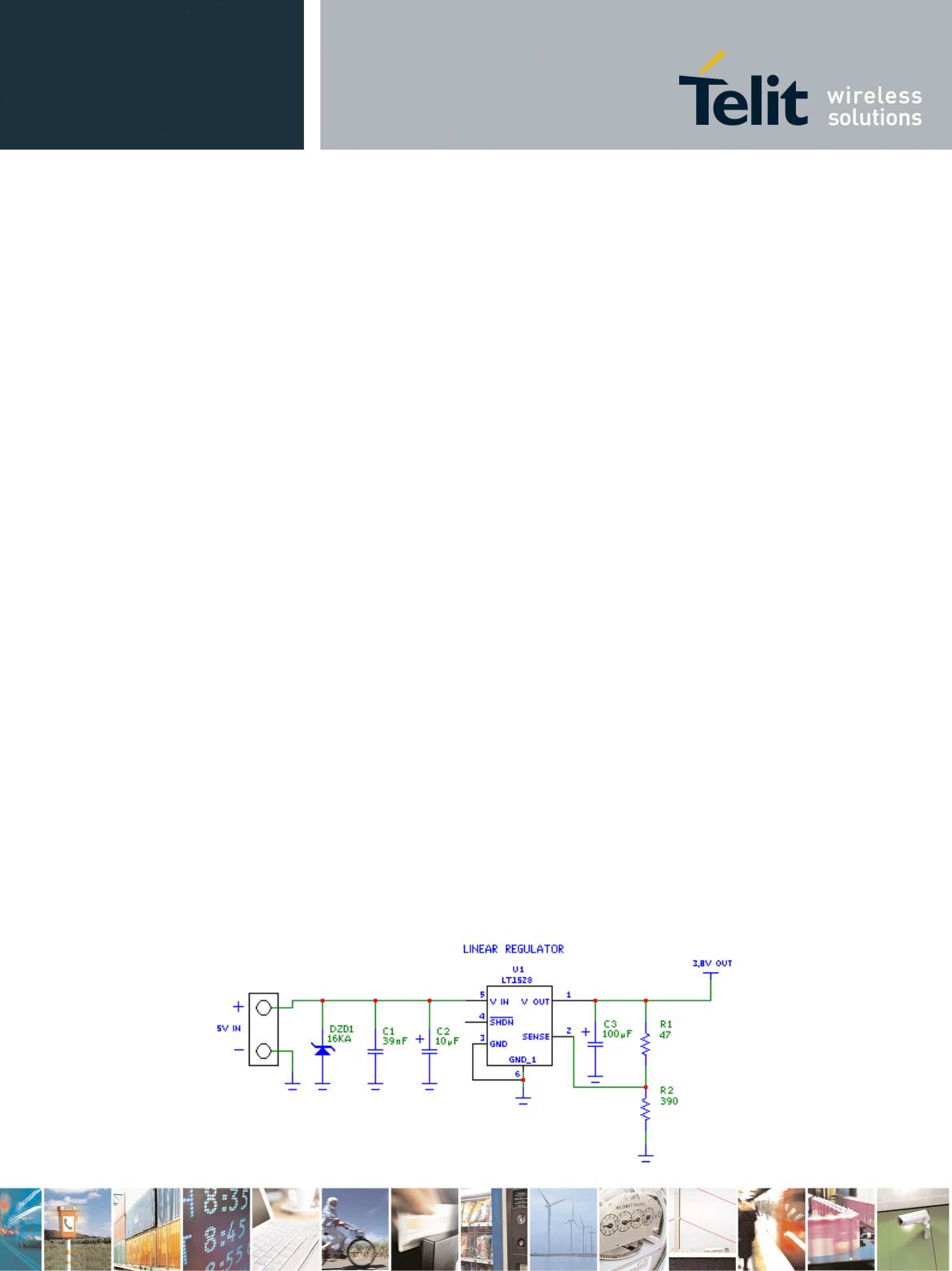
GE910 Hardware User Guide
1vv0300962 Rev.12 2013-10-22
Reproduction forbidden without Telit Communications S.p.A. written authorization - All Rights Reserved
page 31 of 83
Mod. 0805 2011-07 Rev.2
5.3. General Design Rules
The principal guidelines for the Power Supply Design embrace three different design steps:
• the electrical design
• the thermal design
• the PCB layout
5.3.1. Electrical Design Guidelines
The electrical design of the power supply depends strongly from the power source where this
power is drained. We will distinguish them into three categories:
• +5V input (typically PC internal regulator output)
• +12V input (typically automotive)
• Battery
5.3.1.1. + 5V input Source Power Supply Design Guidelines
• The desired output for the power supply is 3.8V, hence there's not a big difference
between the input source and the desired output and a linear regulator can be used. A
switching power supply will not be suited because of the low drop out requirements.
• When using a linear regulator, a proper heat sink shall be provided in order to dissipate
the power generated.
• A Bypass low ESR capacitor of adequate capacity must be provided in order to cut the
current absorption peaks close to the GE910, a 100F tantalum capacitor is usually suited.
• Make sure the low ESR capacitor on the power supply output (usually a tantalum one) is
rated at least 10V.
• A protection diode should be inserted close to the power input, in order to save the
GE910 from power polarity inversion.
An example of linear regulator with 5V input is:

GE910 Hardware User Guide
1vv0300962 Rev.12 2013-10-22
Reproduction forbidden without Telit Communications S.p.A. written authorization - All Rights Reserved
page 32 of 83
Mod. 0805 2011-07 Rev.2
5.3.1.2. + 12V input Source Power Supply Design Guidelines
• The desired output for the power supply is 3.8V, hence due to the big difference between
the input source and the desired output, a linear regulator is not suited and shall not be
used. A switching power supply will be preferable because of its better efficiency
especially with the 2A peak current load represented by the GE910.
• When using a switching regulator, a 500kHz or more switching frequency regulator is
preferable because of its smaller inductor size and its faster transient response. This
allows the regulator to respond quickly to the current peaks absorption.
• In any case the frequency and Switching design selection is related to the application to
be developed due to the fact the switching frequency could also generate EMC
interferences.
• For car PB battery the input voltage can rise up to 15,8V and this should be kept in mind
when choosing components: all components in the power supply must withstand this
voltage.
• A Bypass low ESR capacitor of adequate capacity must be provided in order to cut the
current absorption peaks, a 100F tantalum capacitor is usually suited.
• Make sure the low ESR capacitor on the power supply output (usually a tantalum one) is
rated at least 10V.
• For Car applications a spike protection diode should be inserted close to the power input,
in order to clean the supply from spikes.
• A protection diode should be inserted close to the power input, in order to save the
GE910 from power polarity inversion. This can be the same diode as for spike protection.
An example of switching regulator with 12V input is in the below schematic:
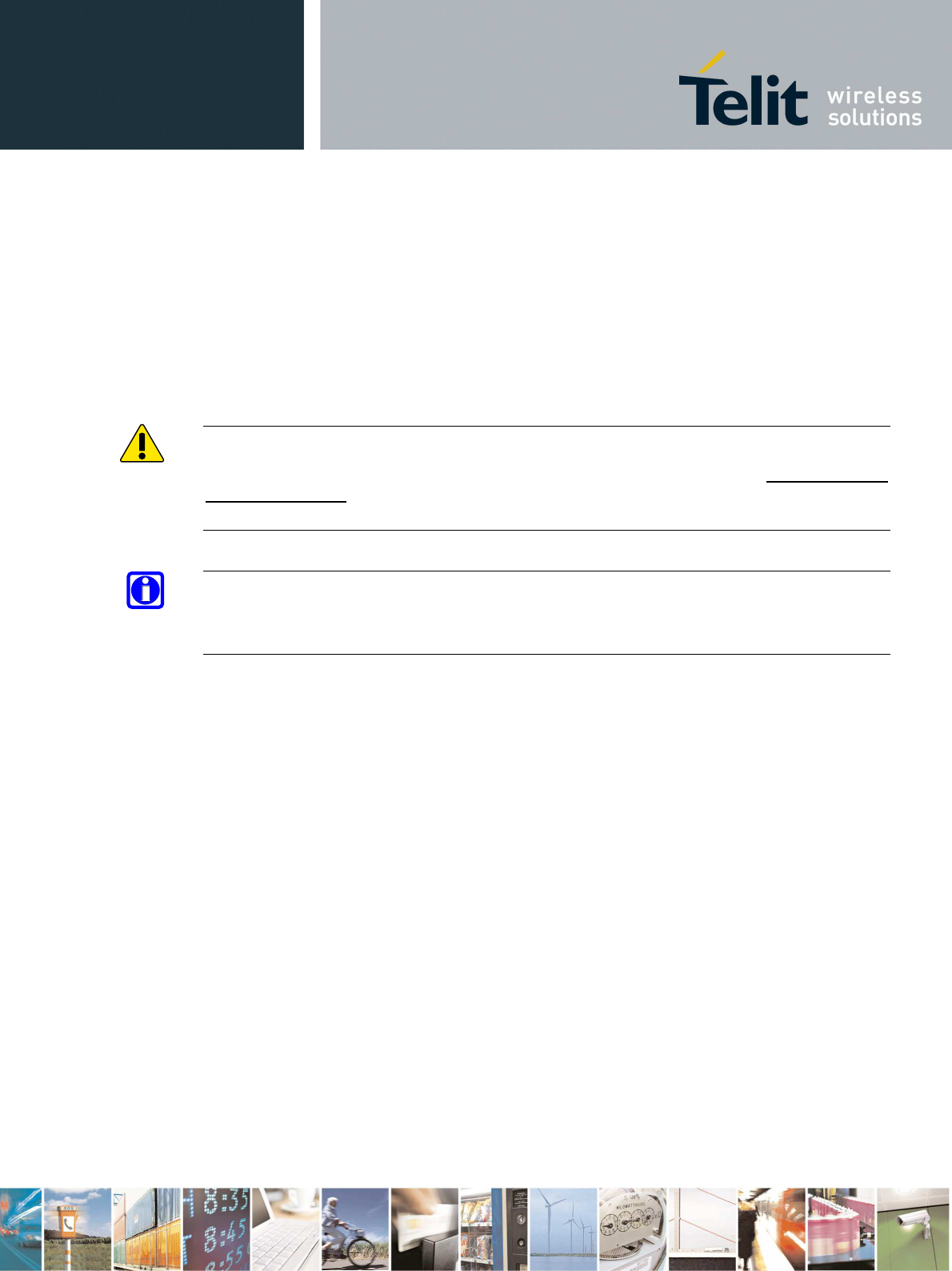
GE910 Hardware User Guide
1vv0300962 Rev.12 2013-10-22
Reproduction forbidden without Telit Communications S.p.A. written authorization - All Rights Reserved
page 33 of 83
Mod. 0805 2011-07 Rev.2
5.3.1.3. Battery Source Power Supply Design Guidelines
• The desired nominal output for the power supply is 3.8V and the maximum voltage
allowed is 4.2V, hence a single 3.7V Li-Ion cell battery type is suited for supplying the
power to the Telit GE910 module.
WARNING:
The three cells Ni/Cd or Ni/MH 3,6 V Nom. battery types or 4V PB types MUST NOT BE
USED DIRECTLY since their maximum voltage can rise over the absolute maximum voltage
for the GE910 and damage it.
NOTE:
DON'T USE any Ni-Cd, Ni-MH, and Pb battery types directly connected with GE910. Their use
can lead to overvoltage on the GE910 and damage it. USE ONLY Li-Ion battery types.
• A Bypass low ESR capacitor of adequate capacity must be provided in order to cut the
current absorption peaks, a 100F tantalum capacitor is usually suited.
• Make sure the low ESR capacitor (usually a tantalum one) is rated at least 10V.
• A protection diode should be inserted close to the power input, in order to save the
GE910 from power polarity inversion. Otherwise the battery connector should be done in
a way to avoid polarity inversions when connecting the battery.
• The battery capacity must be at least 500mAh in order to withstand the current peaks of
2A; the suggested capacity is from 500mAh to 1000mAh.

GE910 Hardware User Guide
1vv0300962 Rev.12 2013-10-22
Reproduction forbidden without Telit Communications S.p.A. written authorization - All Rights Reserved
page 34 of 83
Mod. 0805 2011-07 Rev.2
5.3.2. Thermal Design Guidelines
The thermal design for the power supply heat sink should be done with the following
specifications:
See section 6.2 Power Consumption
Considering the very low current during idle, especially if Power Saving function is enabled, it
is possible to consider from the thermal point of view that the device absorbs current
significantly only during calls.
For the heat generated by the GE910, you can consider it to be during transmission 1W max
during VOICE calls and 2W max during class10 GPRS upload.
This generated heat will be mostly conducted to the ground plane under the GE910; you must
ensure that your application can dissipate it.
NOTE:
The average consumption during transmissions depends on the power level at which the device
is requested to transmit by the network. The average current consumption hence varies
significantly.

GE910 Hardware User Guide
1vv0300962 Rev.12 2013-10-22
Reproduction forbidden without Telit Communications S.p.A. written authorization - All Rights Reserved
page 35 of 83
Mod. 0805 2011-07 Rev.2
5.3.3. Power Supply PCB layout Guidelines
As seen on the electrical design guidelines the power supply shall have a low ESR capacitor on
the output to cut the current peaks and a protection diode on the input to protect the supply from
spikes and polarity inversion. The placement of these components is crucial for the correct
working of the circuitry. A misplaced component can be useless or can even decrease the power
supply performances.
• The Bypass low ESR capacitor must be placed close to the Telit GE910 power input pads
or in the case the power supply is a switching type it can be placed close to the inductor
to cut the ripple provided the PCB trace from the capacitor to the GE910 is wide enough
to ensure a drop less connection even during the 2A current peaks.
• The protection diode must be placed close to the input connector where the power source
is drained.
• The PCB traces from the input connector to the power regulator IC must be wide enough
to ensure no voltage drops occur when the 2A current peaks are absorbed. Note that this
is not made in order to save power loss but especially to avoid the voltage drops on the
power line at the current peaks frequency of 216 Hz that will reflect on all the
components connected to that supply, introducing the noise floor at the burst base
frequency. For this reason while a voltage drop of 300-400 mV may be acceptable from
the power loss point of view, the same voltage drop may not be acceptable from the noise
point of view. If your application doesn't have audio interface but only uses the data
feature of the Telit GE910, then this noise is not so disturbing and power supply layout
design can be more forgiving.
• The PCB traces to the GE910 and the Bypass capacitor must be wide enough to ensure
no significant voltage drops occur when the 2A current peaks are absorbed. This is for
the same reason as previous point. Try to keep this trace as short as possible.
• The PCB traces connecting the Switching output to the inductor and the switching diode
must be kept as short as possible by placing the inductor and the diode very close to the
power switching IC (only for switching power supply). This is done in order to reduce
the radiated field (noise) at the switching frequency (100-500 kHz usually).
• The use of a good common ground plane is suggested.
• The placement of the power supply on the board should be done in such a way to
guarantee that the high current return paths in the ground plane are not overlapped to any
noise sensitive circuitry as the microphone amplifier/buffer or earphone amplifier.
• The power supply input cables should be kept separate from noise sensitive lines such as
microphone/earphone cables.
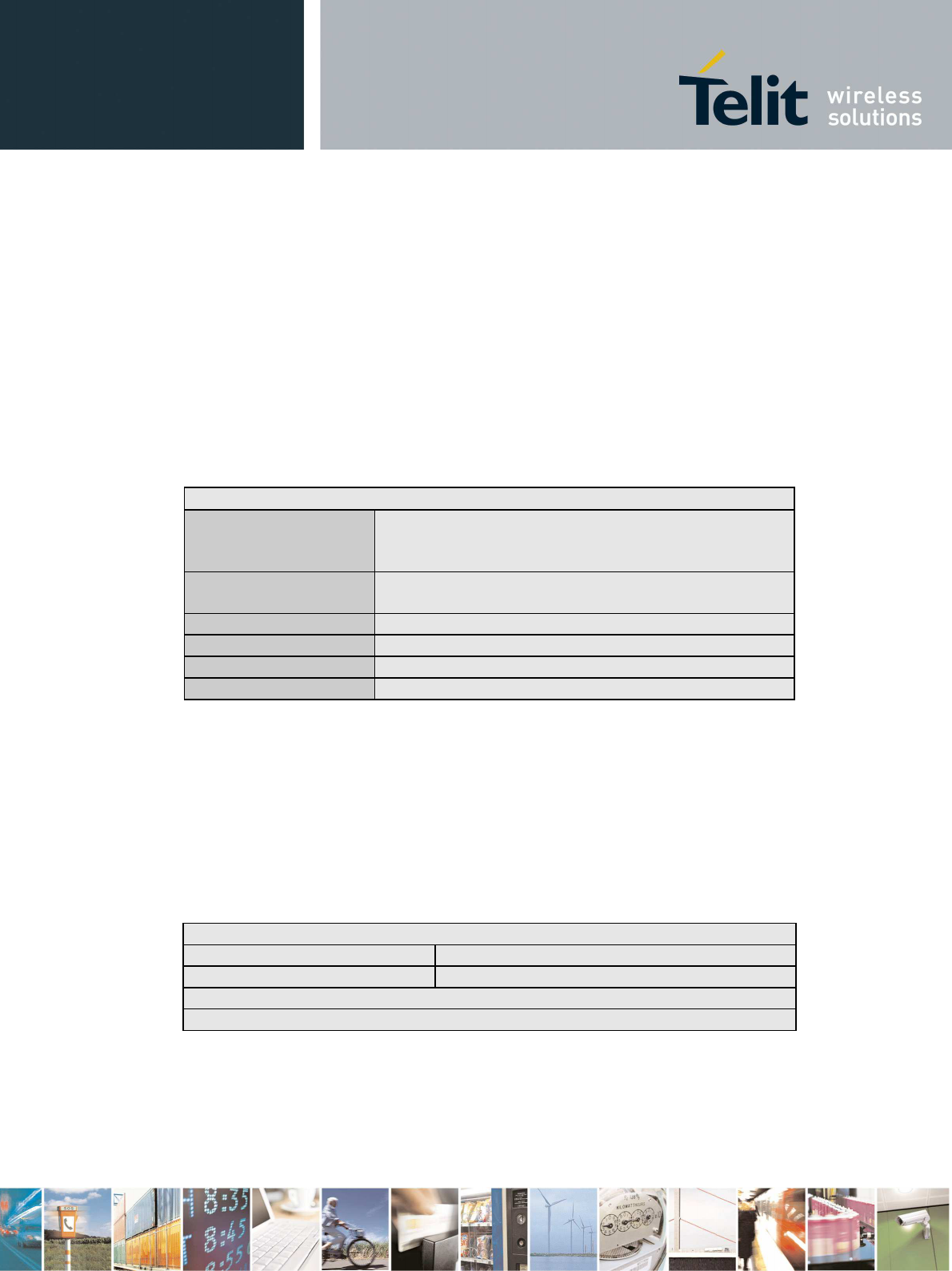
GE910 Hardware User Guide
1vv0300962 Rev.12 2013-10-22
Reproduction forbidden without Telit Communications S.p.A. written authorization - All Rights Reserved
page 36 of 83
Mod. 0805 2011-07 Rev.2
6. GSM Radio Section
The antenna connection and board layout design are the most important aspect in the full
product design as they strongly affect the product overall performances, hence read carefully
and follow the requirements and the guidelines for a proper design.
6.1. GSM Antenna Requirements
As suggested on the Product Description the antenna and antenna transmission line on PCB for a
Telit GE910 device shall fulfill the following requirements:
ANTENNA REQUIREMENTS
Frequency range Depending by frequency band(s) provided by the network
operator, the customer shall use the most suitable antenna
for that/those band(s)
Bandwidth 70 MHz in GSM850, 80 MHz in GSM900, 170 MHz in
DCS & 140 MHz PCS band
Impedance 50
Input power > 2 W
VSWR absolute max 10:1 (limit to avoid permanent damage)
VSWR recommended 2:1 (limit to fulfill all regulatory requirements)
When using the GE910, since there's no antenna connector on the module, the antenna must be
connected to the GE910 antenna pad (LGA pad K1) by means of a transmission line
implemented on the PCB.
In the case the antenna is not directly connected at the antenna pad of the GE910, then a PCB
line is needed in order to connect with it or with its connector.
This transmission line shall fulfill the following requirements:
ANTENNA LINE ON PCB REQUIREMENTS
Characteristic Impedance 50
Max Attenuation 0,3 dB
Coupling with other signals shall be avoided
Cold End (Ground Plane) of antenna shall be equipotential to the GE910 ground pins

GE910 Hardware User Guide
1vv0300962 Rev.12 2013-10-22
Reproduction forbidden without Telit Communications S.p.A. written authorization - All Rights Reserved
page 37 of 83
Mod. 0805 2011-07 Rev.2
Furthermore if the device is developed for the US market and/or Canada market, it shall comply
with the FCC and/or IC approval requirements.
This device is to be used only for mobile and fixed application. In order to re-use the Telit
FCC/IC approvals the antenna(s) used for this transmitter must be installed to provide a
separation distance of at least 20 cm from all persons and must not be co-located or operating in
conjunction with any other antenna or transmitter. See chapter 15.Conformity Assessment Issues
6.2. GSM Antenna - PCB line Guidelines
• Make sure that the transmission line’s characteristic impedance is 50 ;
• Keep line on the PCB as short as possible, since the antenna line loss shall be less than
around 0,3 dB;
• Line geometry should have uniform characteristics, constant cross section, avoid
meanders and abrupt curves;
• Any kind of suitable geometry / structure (Microstrip, Stripline, Coplanar, Grounded
Coplanar Waveguide...) can be used for implementing the printed transmission line
afferent the antenna;
• If a Ground plane is required in line geometry, that plane has to be continuous and
sufficiently extended, so the geometry can be as similar as possible to the related
canonical model;
• Keep, if possible, at least one layer of the PCB used only for the Ground plane; If
possible, use this layer as reference Ground plane for the transmission line;
• It is wise to surround (on both sides) the PCB transmission line with Ground, avoid
having other signal tracks facing directly the antenna line track.
• Avoid crossing any un-shielded transmission line footprint with other signal tracks on
different layers;
• The ground surrounding the antenna line on PCB has to be strictly connected to the main
Ground Plane by means of via holes (once per 2mm at least), placed close to the ground
edges facing line track;
• Place EM noisy devices as far as possible from GE910 antenna line;
• Keep the antenna line far away from the GE910 power supply lines;
• If EM noisy devices are present on the PCB hosting the GE910, such as fast switching
ICs, take care of the shielding of the antenna line by burying it inside the layers of PCB
and surround it with Ground planes, or shield it with a metal frame cover.
• If EM noisy devices are not present around the line, the use of geometries like Microstrip
or Grounded Coplanar Waveguide has to be preferred, since they typically ensure less
attenuation if compared to a Stripline having same length;
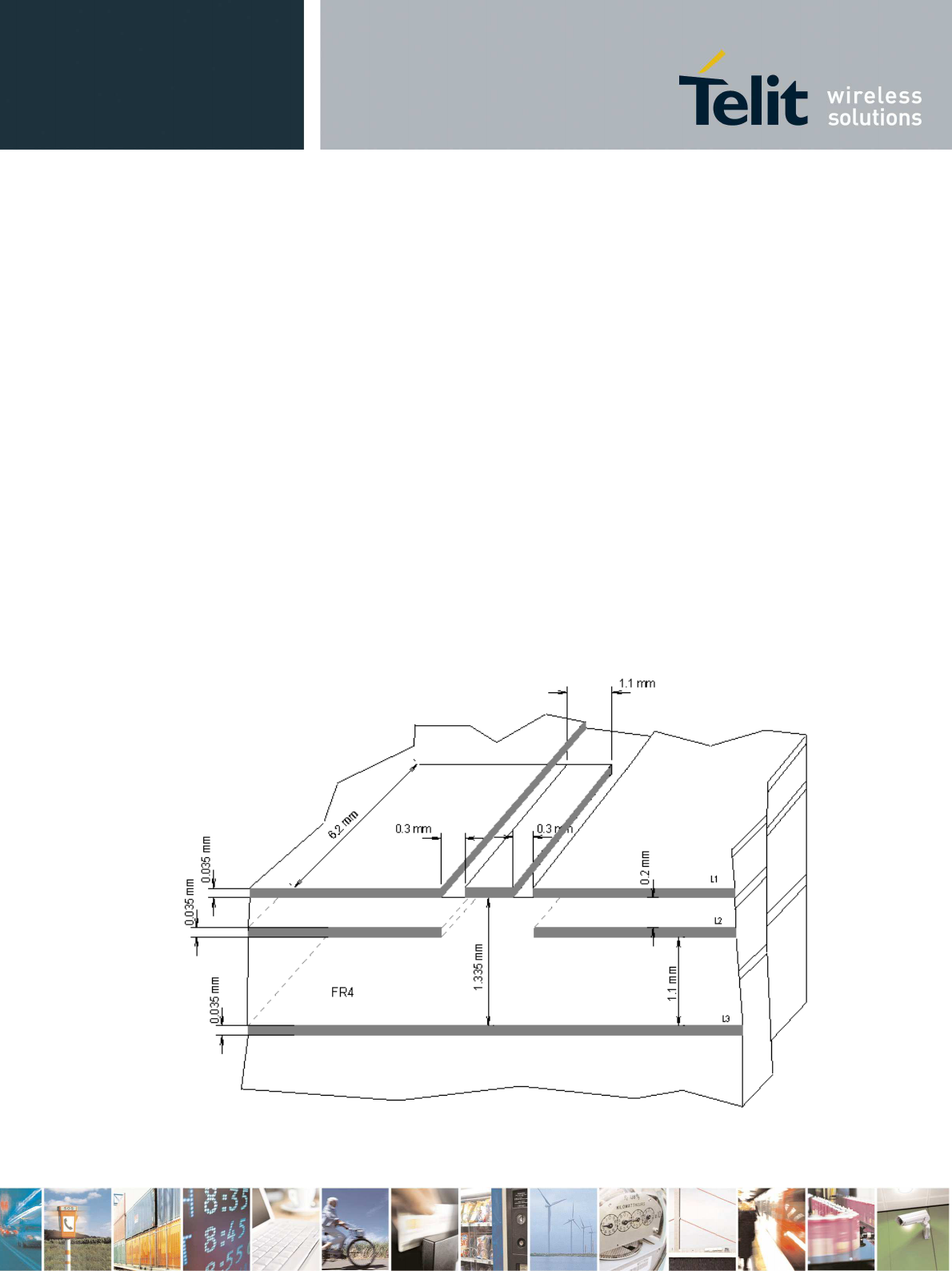
GE910 Hardware User Guide
1vv0300962 Rev.12 2013-10-22
Reproduction forbidden without Telit Communications S.p.A. written authorization - All Rights Reserved
page 38 of 83
Mod. 0805 2011-07 Rev.2
6.3. PCB Guidelines in case of FCC certification
In the case FCC certification is required for an application using GE910, according to FCC KDB
996369 for modular approval requirements, the transmission line has to be similar to that
implemented on GE910 interface board and described in the following chapter.
6.3.1. Transmission line design
During the design of the GE910 interface board, the placement of components has been chosen
properly, in order to keep the line length as short as possible, thus leading to lowest power losses
possible. A Grounded Coplanar Waveguide (G-CPW) line has been chosen, since this kind of
transmission line ensures good impedance control and can be implemented in an outer PCB layer
as needed in this case. A SMA female connector has been used to feed the line.
The interface board is realized on a FR4, 4-layers PCB. Substrate material is characterized by
relative permittivity
r
= 4.6 ± 0.4 @ 1 GHz, TanD= 0.019 ÷ 0.026 @ 1 GHz.
A characteristic impedance of nearly 50 is achieved using trace width = 1.1 mm, clearance
from coplanar ground plane = 0.3 mm each side. The line uses reference ground plane on layer 3,
while copper is removed from layer 2 underneath the line. Height of trace above ground plane is
1.335 mm. Calculated characteristic impedance is 51.6 , estimated line loss is less than 0.1 dB.
The line geometry is shown below:
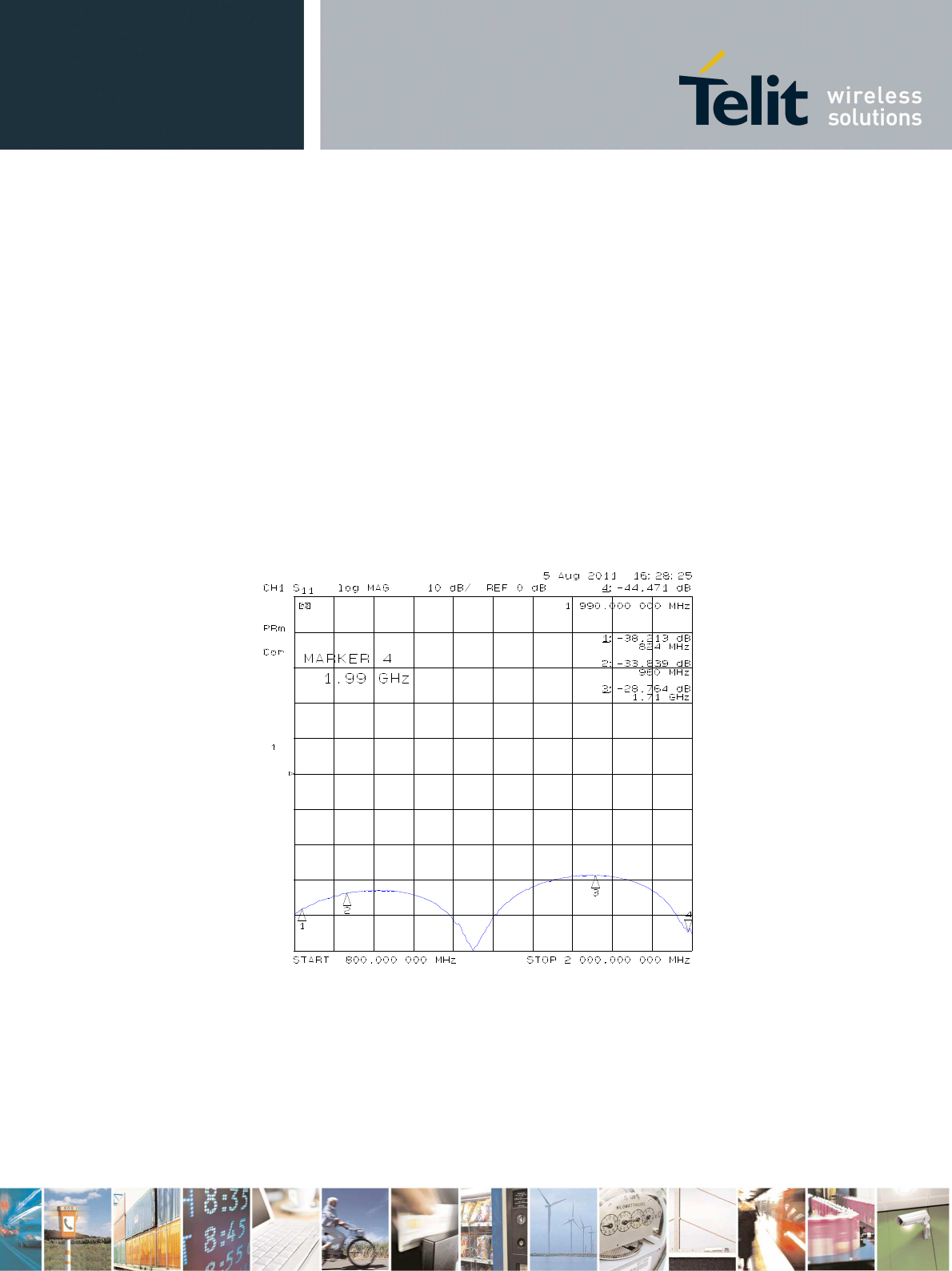
GE910 Hardware User Guide
1vv0300962 Rev.12 2013-10-22
Reproduction forbidden without Telit Communications S.p.A. written authorization - All Rights Reserved
page 39 of 83
Mod. 0805 2011-07 Rev.2
6.3.2. Transmission line measurements
HP8753E VNA (Full-2-port calibration) has been used in this measurement session. A calibrated
coaxial cable has been soldered at the pad corresponding to GE910 RF output; a SMA connector
has been soldered to the board in order to characterize the losses of the transmission line
including the connector itself. During Return Loss / impedance measurements, the transmission
line has been terminated to 50 load.
Return Loss plot of line under test is shown below:
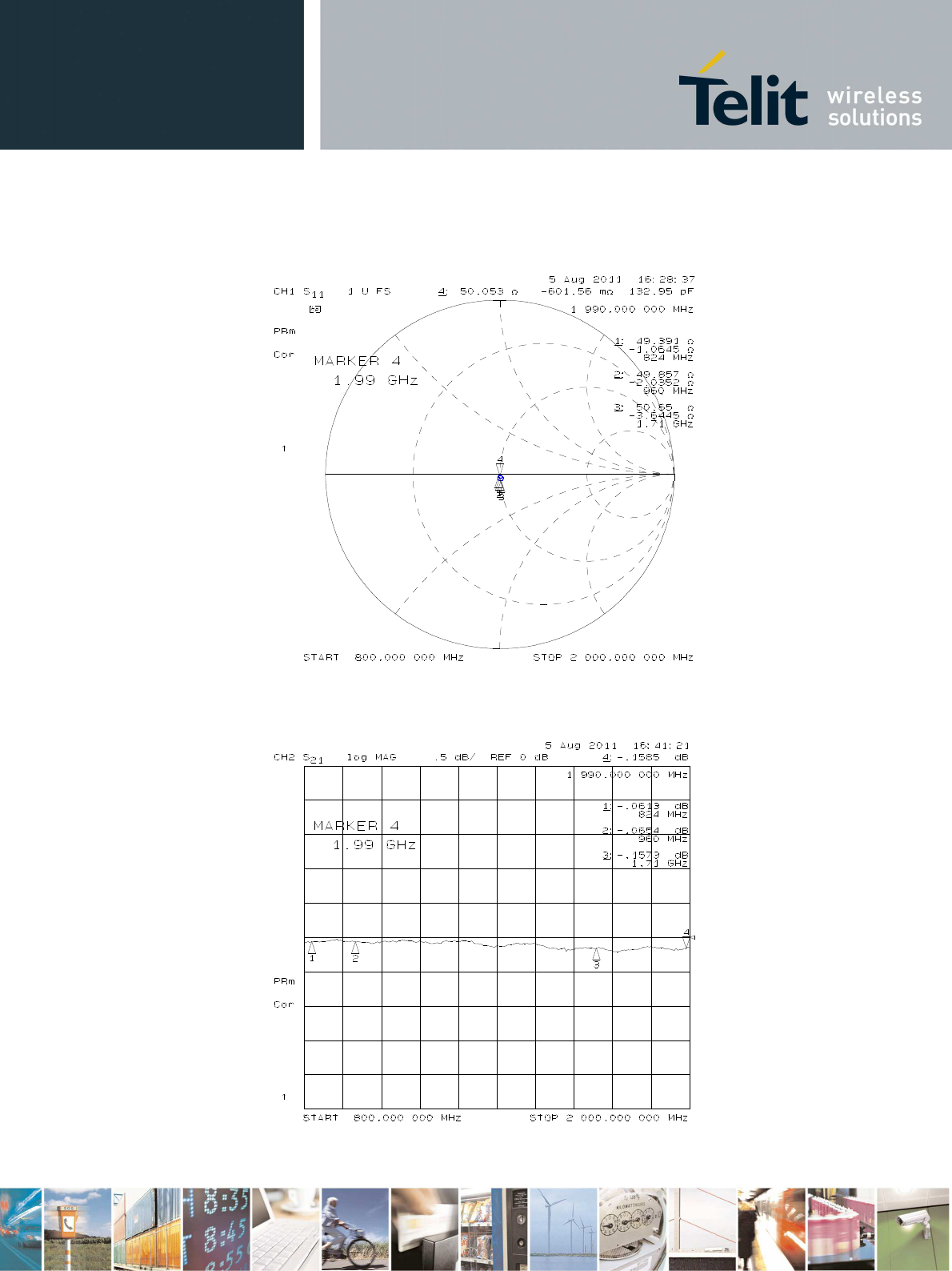
GE910 Hardware User Guide
1vv0300962 Rev.12 2013-10-22
Reproduction forbidden without Telit Communications S.p.A. written authorization - All Rights Reserved
page 40 of 83
Mod. 0805 2011-07 Rev.2
Line input impedance (in Smith Chart format, once the line has been terminated to 50 load) is
shown in the following figure:
Insertion Loss of G-CPW line plus SMA connector is shown below:

GE910 Hardware User Guide
1vv0300962 Rev.12 2013-10-22
Reproduction forbidden without Telit Communications S.p.A. written authorization - All Rights Reserved
page 41 of 83
Mod. 0805 2011-07 Rev.2
6.4. GSM Antenna - Installation Guidelines
• Install the antenna in a place covered by the GSM signal.
• If the device antenna is located greater then 20cm from the human body and there are no
co-located transmitter then the Telit FCC/IC approvals can be re-used by the end product
• If the device antenna is located less then 20cm from the human body or there are no co-
located transmitter then the additional FCC/IC testing may be required for the end
product (Telit FCC/IC approvals cannot be reused)
• Antenna shall not be installed inside metal cases
• Antenna shall be installed also according Antenna manufacturer instructions.
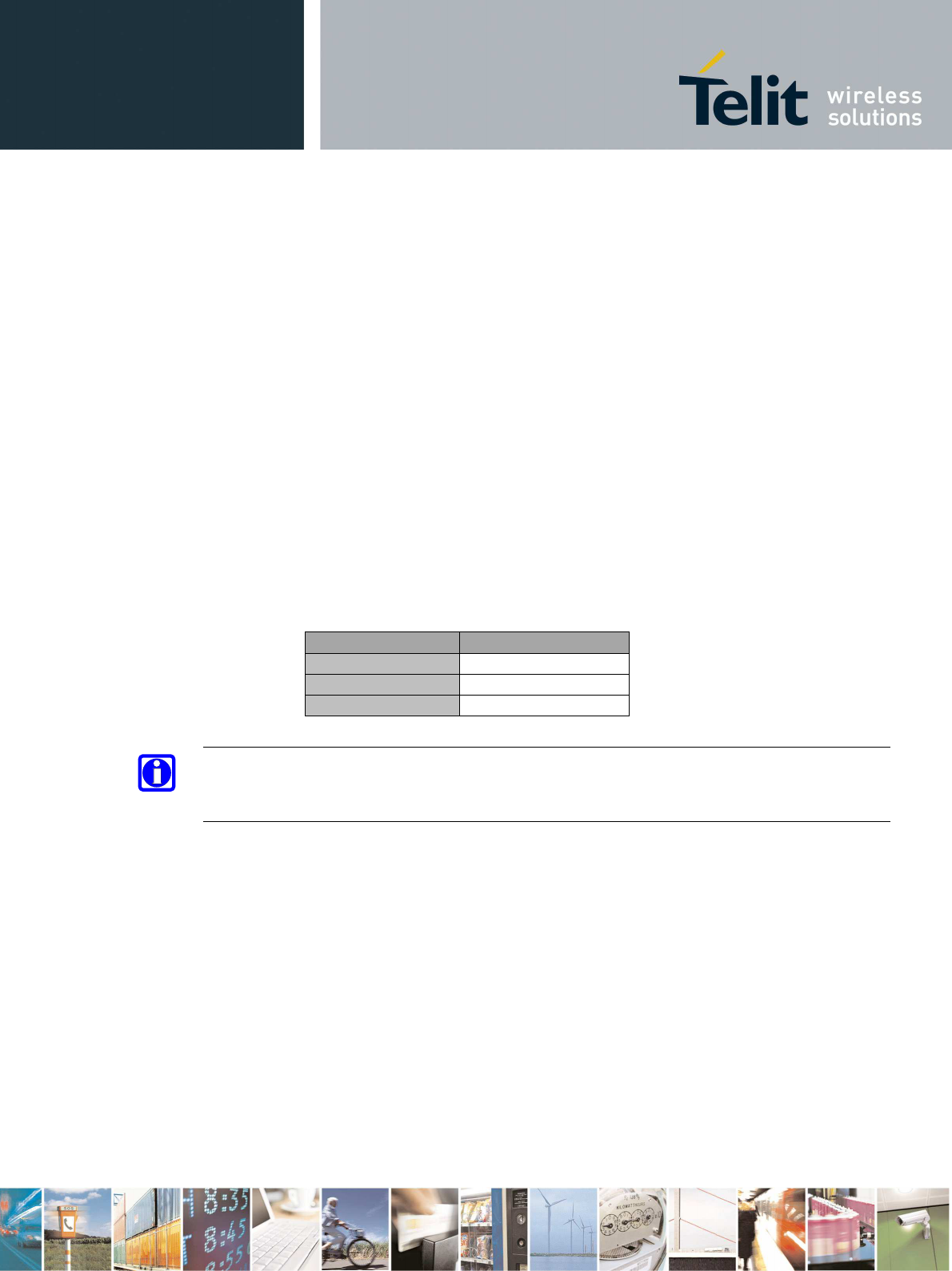
GE910 Hardware User Guide
1vv0300962 Rev.12 2013-10-22
Reproduction forbidden without Telit Communications S.p.A. written authorization - All Rights Reserved
page 42 of 83
Mod. 0805 2011-07 Rev.2
7. Global Navigation Satellite System (GE910-GNSS)
The GNSS part of GE910-GNSS module is a new age of receiver that can simultaneously search
and track satellite signals from multiple satellite constellations. This multi-GNSS receiver uses
the entire spectrum of GNSS systems available: GPS, Glonass, Galileo and QZSS.
It features advanced real time hardware correlation engine for enhanced sensitivity navigation
engine (PVT), Fast Acquisition giving rapid Time-to-First-Fix (TTFF), low power consumption
and fast time to first fix, 32 track verification channels, stand Alone and Assisted mode and
Satellite Based Augmentation Systems (SBAS): WAAS, EGNOS, and MSAS. It also offers an
accurate timing pulse and jamming immunity.
Operation in a high interference signal environment is common practice in today’s electronic
age. By incorporating 3-stage rejection architecture, it is able to remove interfering signals pre-
and post-correlation.
With the help of advanced digital signal processing algorithms and the use of A-GPS data, the
receiver is capable to achieve higher sensitivity values required for indoor applications.
The following table is listing the GE910 variants that support the GNSS receiver:
Product GNSS Receiver
GE910-GNSS YES
GE910-QUAD NO
GE910-QUAD V3 NO
NOTE: The GNSS part of GE910-GNSS module has the same electrical and performance
specifications as referred in Telit “SL869 Product Description”. Please refer to that document
for more detail information.
7.1. Principles of operation
The GSM and GNSS part of the module can be used in two ways: standalone or hosted.
In the standalone mode the GE910-GNSS module has independent Power ON-OFF and UART.
In the hosted mode the GNSS is controlled by GSM at start-up, left GNSS_EN* pad
unconnected. In this mode the GNSS commands and NMEA strings can be either through the
dedicated GNSS UART3 or via GSM UARTs, leaving UART3 for different use.
The GNSS firmware is upgradable as standalone or host, in host operation, leave GNSS_BOOT
(GNSS_NMEA_TX) pin floating. In Standalone mode of operation place into BOOT mode by
tying GNSS_BOOT pin to Ground through a 1K pull-up resistor.
The host serial I/O port of the receiver’s serial data interface supports full duplex
communication between the receiver and the user.
The default serial configuration on UART3 (GNSS_NMEA_UART) is as follows:
NMEA, 115200 bps, 8 data bits, no parity, and 1stop bit.
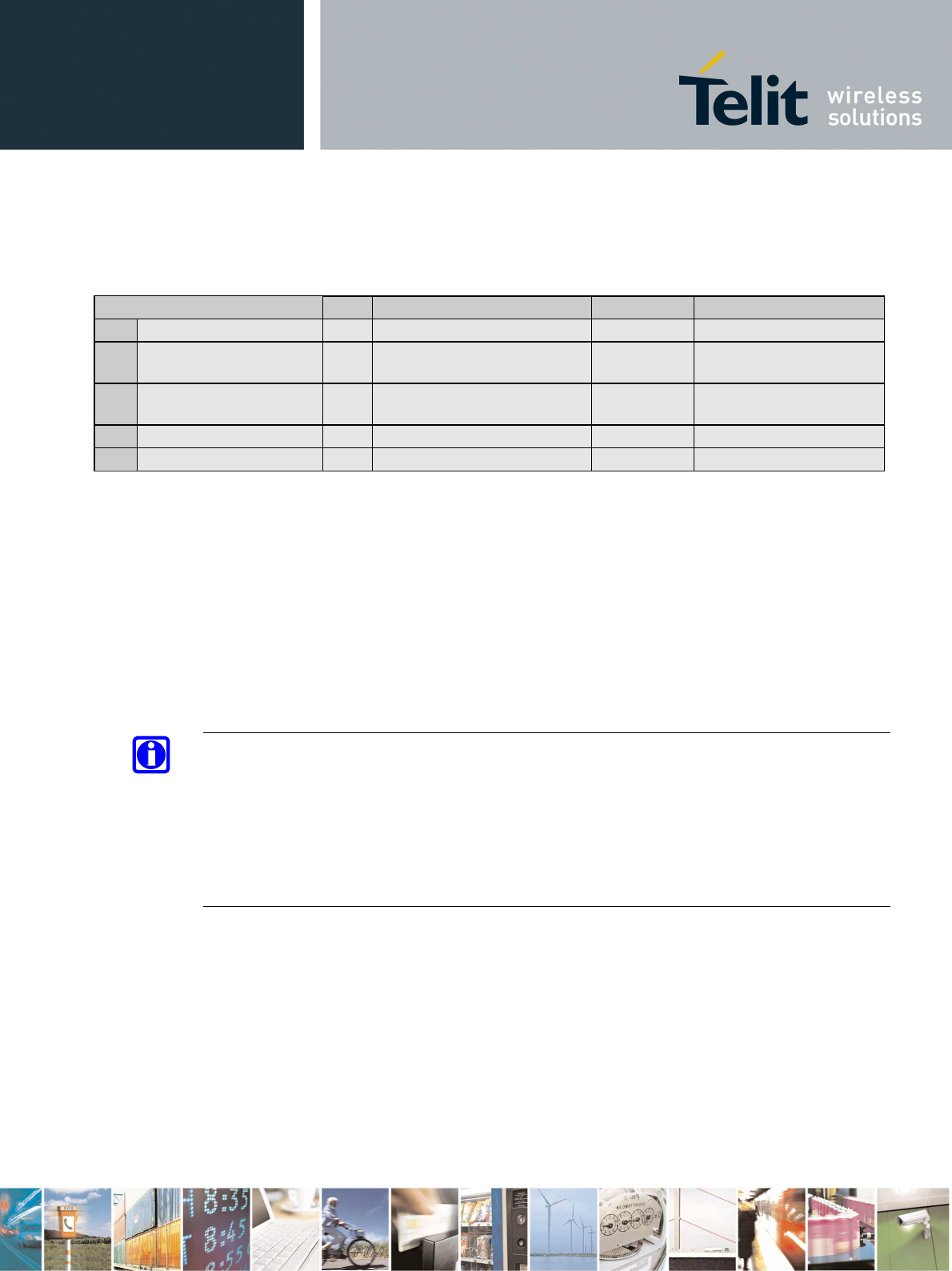
GE910 Hardware User Guide
1vv0300962 Rev.12 2013-10-22
Reproduction forbidden without Telit Communications S.p.A. written authorization - All Rights Reserved
page 43 of 83
Mod. 0805 2011-07 Rev.2
7.2. GNSS Signals Pinout
GNSS SECTION
R9 ANTENNA GNSS - GNSS Antenna (50 ohm) RF
G14
GNSS_EN* I External GNSS ON-OFF VBATT ref.
Open Colector active
low
J14 GNSS_NMEA_TX O UART NMEA Output 1.8V UART3 or
GNSS_BOOT
K14
GNSS_NMEA_RX I UART NMEA Input 1.8V UART3
R7 GNSS_LNA_EN O GNSS External LNA Enable
1.8V Active Antenna Control
7.3. Turning ON/OFF the GNSS module only in standalone mode
Turning ON/OFF the GNSS device can be done in two ways:
• via AT command (see GE910 Software User Guide, AT$GPSP)
• Keeping low the external pad GNSS_EN* to Power On or releasing it to Power OFF.
NOTE:
Connect GNSS_EN* pad in an open collector configuration, since it is pulled-up to VBATT.
TIP:
To check if the GNSS device has powered on, you can use the GNSS_LNA_EN, it goes high on
power-on until first fix, and only then, it may pulse for power saving requirements.
7.4. RF Front End Design
The GE910 Module contains an integrated LNA and pre-select SAW filter. This allows the
module to work properly with a passive GPS antenna. If the antenna cannot be located near the
GE910, then an active antenna (i.e. an antenna with a built-in low noise amplifier) can be used.

GE910 Hardware User Guide
1vv0300962 Rev.12 2013-10-22
Reproduction forbidden without Telit Communications S.p.A. written authorization - All Rights Reserved
page 44 of 83
Mod. 0805 2011-07 Rev.2
7.4.1. RF Signal Requirements
Thanks to the internal LNA it amplifies the GNSS signals and provides enough gain for the
receiver to use a passive antenna. A very low noise design is utilized to provide maximum
sensitivity. For better performance the system requires an external BIAS-T and antenna voltage
supply for active antenna.
7.4.2. GNSS Antenna – PCB Line Guidelines
• Ensure that the antenna line impedance is 50ohm.
• Keep the antenna line on the PCB as short as possible to reduce the loss.
• Antenna line must have uniform characteristics, constant cross section, avoid meanders and
abrupt curves.
• Keep one layer of the PCB used only for the Ground plane, if possible.
• Surround (on both the sides, over and under) the antenna line on PCB with Ground, avoid
having other signal tracks facing directly the antenna line of track.
• The ground around the antenna line on PCB has to be strictly connected to the Ground Plane
by placing vias once per 2mm at least.
• Place EM noisy devices as far as possible from antenna line.
• Keep the antenna line far away from power supply lines.
• Keep the antenna line far away from GSM RF lines.
• If you have EM noisy devices around the PCB hosting the module, such as fast switching
ICs, take care of the shielding of the antenna line by burying it inside the layers of PCB and
surround it with Ground planes, or shield it with a metal frame cover.
• If you do not have EM noisy devices around the PCB hosting the module, use a strip-line on
the superficial copper layer for the antenna line. The line attenuation will be lower than a
buried one.
7.4.3. GNSS Antenna Polarization
The GNSS signal as broadcast is a right hand circularly polarized signal. The best antenna to
receive these signals is a right hand circularly (RHCP) polarized antenna.
Remember that IS-GPS-200E specifies the received power level with a linearly polarized
antenna. A linearly polarized antenna will have 3 dB losses as compared to an RHCP antenna
assuming the same antenna gain (specified in dBi and dBic respectively).
An RHCP antenna is better at rejecting multipath than a linearly polarized antenna.
This is because the reflected signal changes polarization to LHCP, which would be rejected by
the RHCP antenna by typically 20 dB or so. If the multipath signal is attenuating the line of
sight signal, then the RHCP antenna would show a higher signal level than a linearly polarized
antenna because the interfering signal is rejected.
However, in the case where the multipath signal is replacing the line of sight signal, such as in
an urban canyon environment, then the number of satellites in view could drop below the needed
number to determine a 3D solution. This is a case where a bad signal may be better than no
signal. The system designer needs to make tradeoffs in his application to choose the better
solution.

GE910 Hardware User Guide
1vv0300962 Rev.12 2013-10-22
Reproduction forbidden without Telit Communications S.p.A. written authorization - All Rights Reserved
page 45 of 83
Mod. 0805 2011-07 Rev.2
7.4.4. GNSS Antenna Gain
Antenna gain is defined as the extra signal power from the antenna as compared to a theoretical
isotropic antenna (equally sensitive in all directions).
For example, a 25x25mm
2
patch antenna on a reference ground plane (usually 70x70mm
2
) will
give an antenna gain at zenith of 5 dBic. A smaller 18mm by 18mm square patch on a reference
ground plane (usually 50x50mm
2
) will give an antenna gain at zenith of 2 dBic.
While an antenna vendor will specify a nominal antenna gain (usually at zenith, or directly
overhead) antenna pattern curves should be supplied, specifying gain as a function of elevation
and gain at a fixed elevation as a function of azimuth. Pay careful attention to the requirement to
meet these specifications, such as required ground plane and any external matching components.
Failure to follow these requirements could result in very poor antenna performance.
It is important to note that GPS antenna gain is not the same thing as external LNA gain. Most
antenna vendors will specify these numbers separately, but some combine them into a single
number. It is important to know both numbers when designing and evaluating the front end of a
GPS receiver.
For example, antenna X has an antenna gain of 5 dBiC at azimuth and an LNA gain of 20 dB for
a combined total of 25 dB. Antenna Y has an antenna gain of -5 dBiC at azimuth and an LNA
gain of 30 dB for a combined total of 25 dB. However, in the system, antenna X will outperform
antenna Y by about 10 dB (refer to next chapter for more details on system noise floor).
An antenna with higher gain will generally outperform an antenna with lower gain. Once the
signals are above about -130 dBm for a particular satellite, no improvement in performance
would be gained. However, for those satellites that are below about -125 dBm, a higher gain
antenna would improve the gain and improve the performance of the GPS receiver. In the case
of really weak signals, a good antenna could make the difference between being able to use a
particular satellite signal or not.
7.4.5. Active versus Passive Antenna
If the GPS antenna is placed near the GE910 and the RF traces losses are not excessive
(nominally 1 dB), then a passive antenna can be used. This would normally be the lowest cost
option and most of the time the simplest to use. However, if the antenna needs to be located
away from the GE910 then an active antenna may be required to obtain the best system
performance. The active antenna has its own built-in low noise amplifier to overcome RF trace
or cable losses after the active antenna.
However, an active antenna has a low noise amplifier (LNA) with associated gain and noise
figure. In addition, many active antennas have a pre-select filter, a post-select filter, or both.

GE910 Hardware User Guide
1vv0300962 Rev.12 2013-10-22
Reproduction forbidden without Telit Communications S.p.A. written authorization - All Rights Reserved
page 46 of 83
Mod. 0805 2011-07 Rev.2
7.4.6. RF Trace Losses
RF Trace losses are difficult to estimate on a PCB without having the appropriate tables or RF
simulation software to estimate what the losses would be. A good rule of thumb would be to
keep the RF traces as short as possible, make sure they are 50 ohms impedance and don’t
contain any sharp bends.
7.4.7. Implications of the Pre-select SAW Filter
The module GE910-GNSS contains a SAW filter used in a pre-select configuration with the
built-in LNA, that is, the RF input of the module ties directly into the SAW filter. Any circuit
connected to the input of the module would see complex impedance presented by the SAW
filter, particularly out of band, rather than the relatively broad and flat return loss presented by
the LNA. Filter devices pass the desired in band signal to the output, resulting in low reflected
energy (good return loss), and reject the out of band signal by reflecting it back to the input,
resulting in high reflected energy (bad return loss).
If an external amplifier is used with the module, the overall design should be checked for RF
stability to prevent the external amplifier from oscillating. Amplifiers that are unconditionally
stable at the output will be fine to use with the module.
7.4.8. External LNA Gain and Noise Figure
The module GE910-GNSS can be used with an external LNA such as what might be found in an
active antenna. Because of the internal LNA, the overall gain (including signal losses past the
external LNA) should not exceed 14 dB. Higher levels can affect the jamming detection
capability of the module. If a higher gain LNA is used, either a resistive Pi or T attenuator can
be inserted after the LNA to bring the gain down to 14 dB.
The external LNA should have a noise figure better than 1 dB. This will give an overall system
noise figure of around 2 dB assuming the LNA gain is 14 dB, or if higher the low gain mode is
automatically managed with its internal AGC.
The external LNA, if having no pre-select filter, needs to be able to handle signals other than the
GNSS signal. These signals are typically at much higher levels. The amplifier needs to stay in
the linear region when presented with these other signals. Again, the system designer needs to
determine all of the unintended signals and their possible levels that can be presented and make
sure the external LNA will not be driven into compression. If this were to happen, the GNSS
signal itself would start to be attenuated and the performance would suffer.
7.4.9. Powering the External LNA (active antenna)
The external LNA needs a source of power. Many of the active antennas accept a 3 volt or 5 volt
DC voltage that is impressed upon the RF signal line. This voltage is not supplied by the
GE910-GNSS module, but can be easily supplied by the host design.
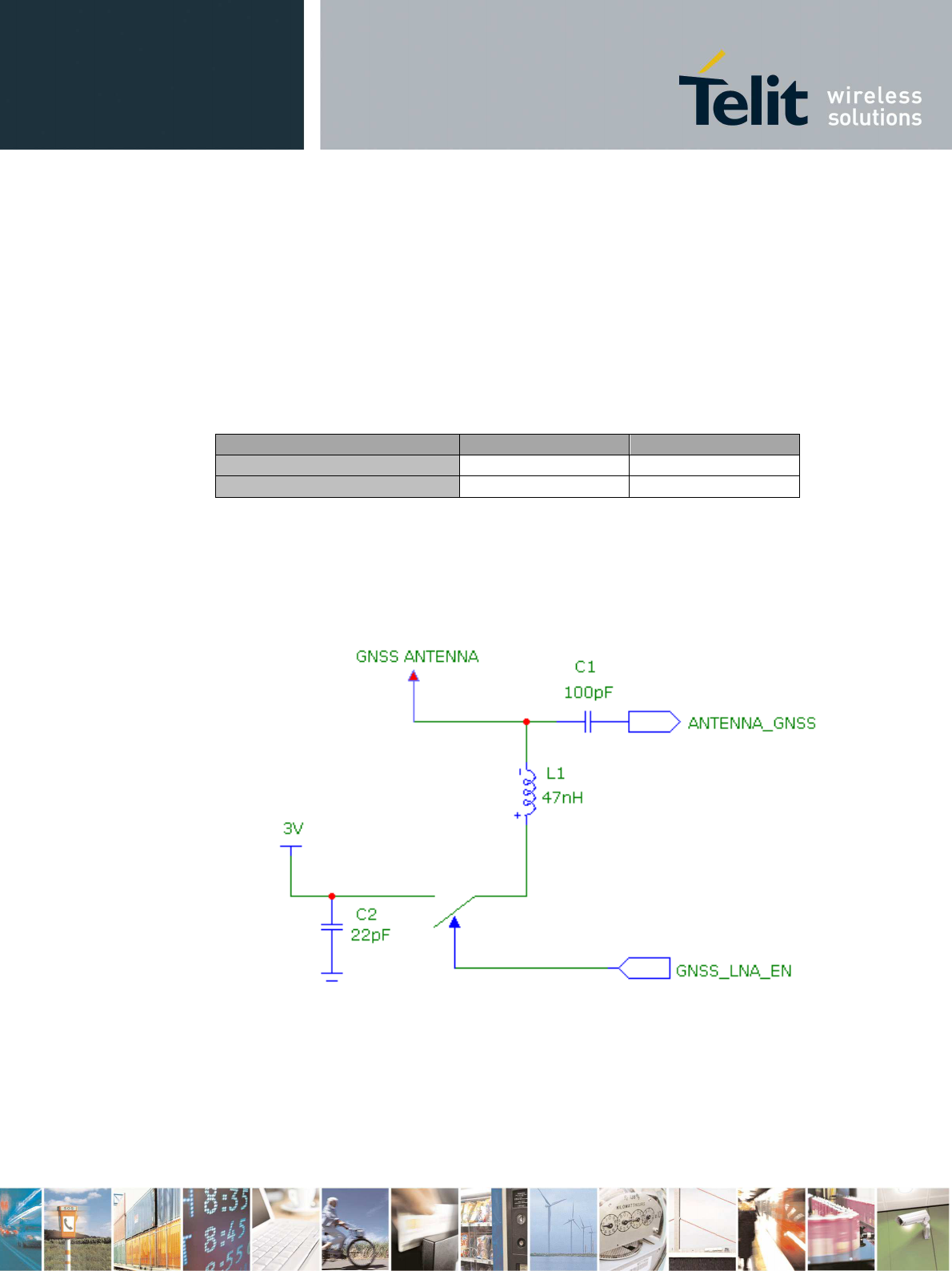
GE910 Hardware User Guide
1vv0300962 Rev.12 2013-10-22
Reproduction forbidden without Telit Communications S.p.A. written authorization - All Rights Reserved
page 47 of 83
Mod. 0805 2011-07 Rev.2
7.4.10. External LNA Enable
The GE910 is already provided by an internal LNA. In case the Application needs to include an
additional LNA stage, the module is provided by a digital signal usable to enable the power
supply of the external amplifier. The signal is set to High only when the GPS receiver is active.
The electrical characteristics of the GPS_LNA_EN signal are:
Level Min [V] Max [V]
Output High Level 1.6 1.9
Output Low Level 0V 0.2
Example of external antenna bias circuitry:
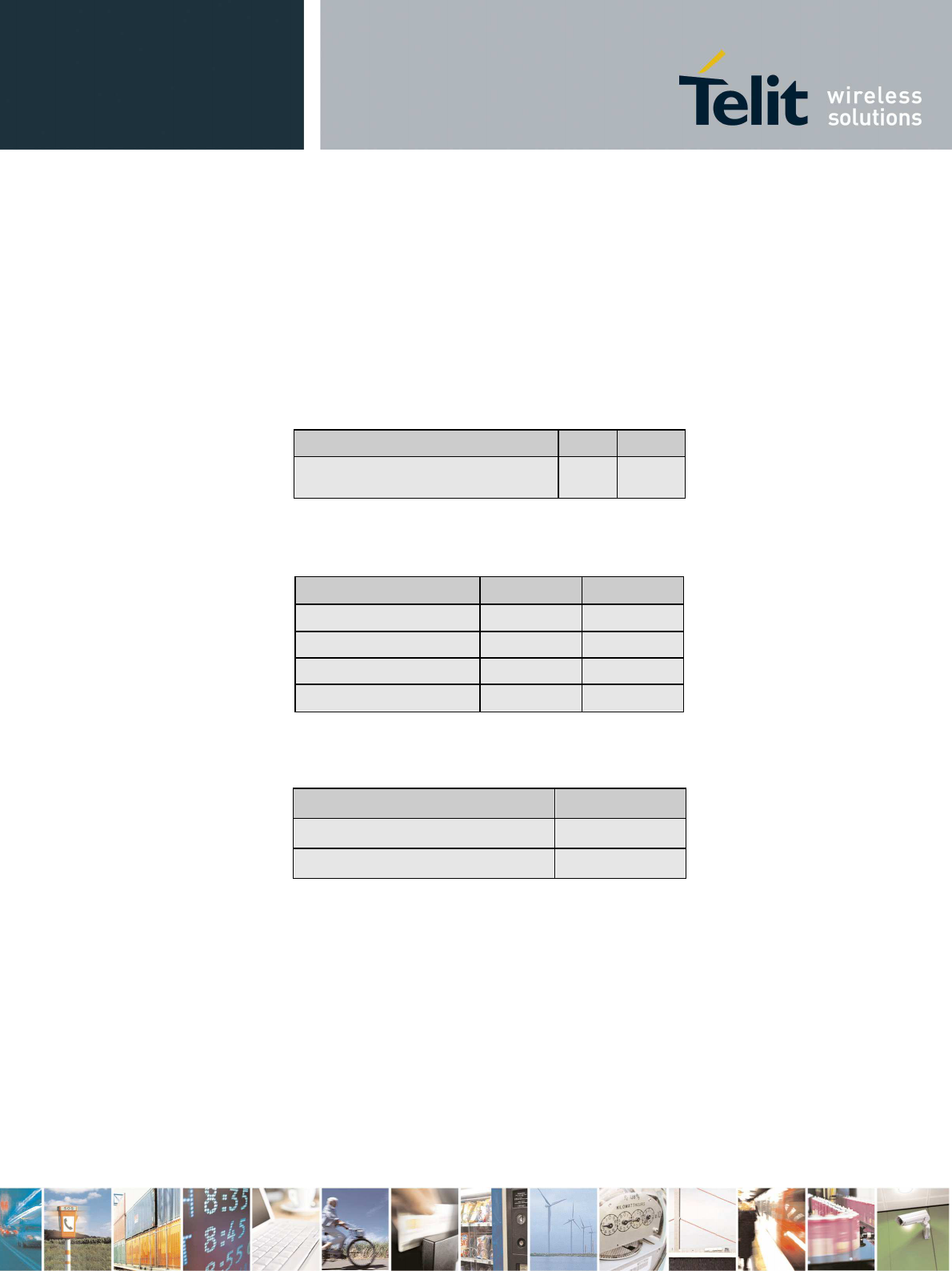
GE910 Hardware User Guide
1vv0300962 Rev.12 2013-10-22
Reproduction forbidden without Telit Communications S.p.A. written authorization - All Rights Reserved
page 48 of 83
Mod. 0805 2011-07 Rev.2
8. Logic Level Specifications
Where not specifically stated, all digital interface circuits work at 1.8V CMOS logic levels. The
following table shows the logic level specifications used in the GE910 interface circuits:
Absolute Maximum Ratings -Not Functional
Parameter Min Max
Input level on any digital pin
(CMOS 1.8) when ON -0.3V
+2.1V
Operating Range - Interface levels (1.8V CMOS)
Level Min Max
Input high level 1.5V 1.9V
Input low level 0V 0.35V
Output high level 1.6V 1.9V
Output low level 0V 0.2V
Current characteristics
Level Typical
Output Current 1mA
Input Current 1uA
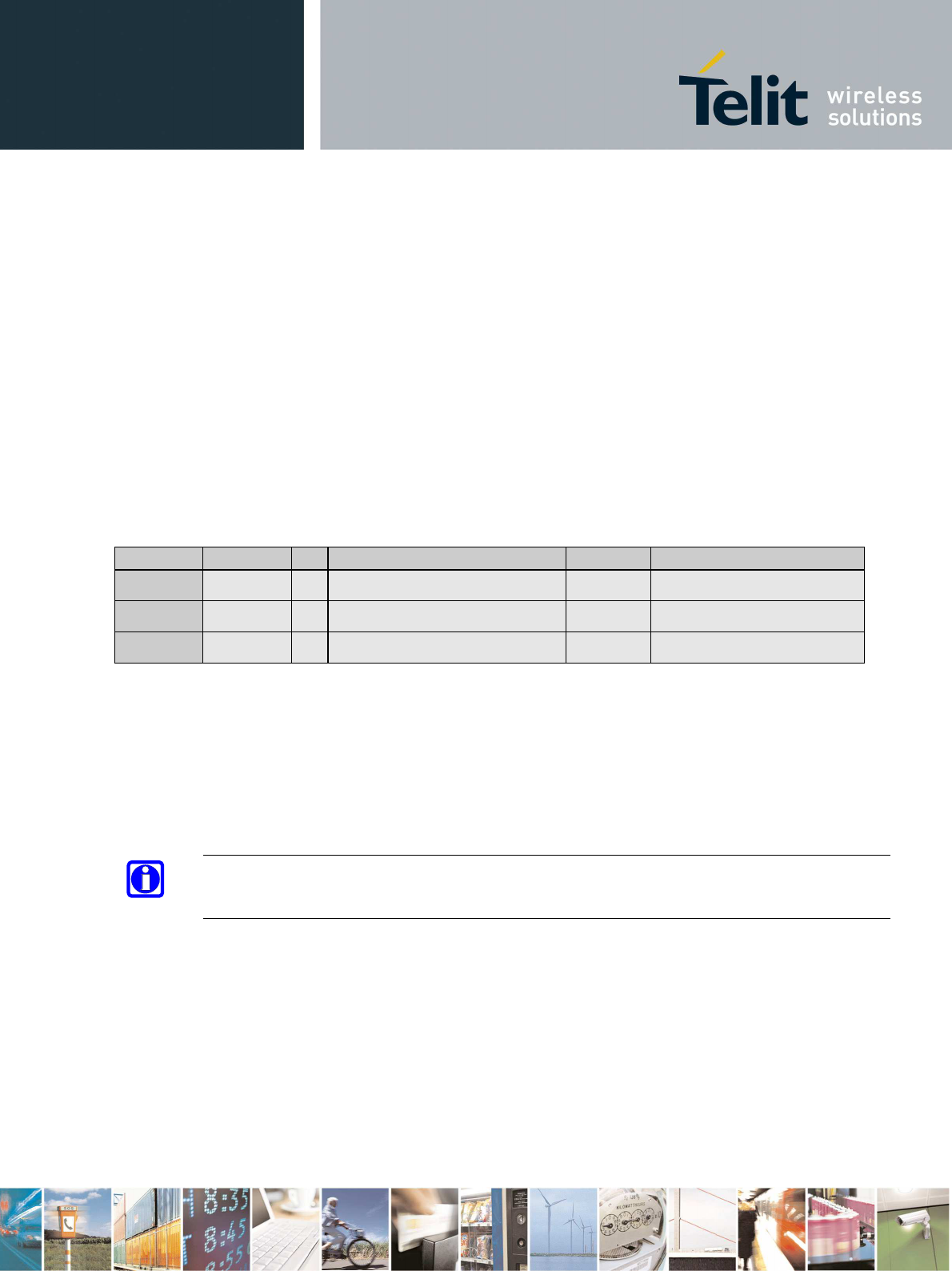
GE910 Hardware User Guide
1vv0300962 Rev.12 2013-10-22
Reproduction forbidden without Telit Communications S.p.A. written authorization - All Rights Reserved
page 49 of 83
Mod. 0805 2011-07 Rev.2
9. USB Port
The GE910 includes one integrated universal serial bus (USB) transceiver
USB 2.0 FS.
Note: NOT supported on GE910-QUAD V3.
9.1. USB 2.0 FS
This port is compliant with the USB 2.0 FS (Full Speed) specifications.
The following table is listing the available signals:
PAD Signal I/O
Function Type COMMENT
B15 USB_D+ I/O
USB differential Data (+) 3.3V
C15 USB_D- I/O
USB differential Data (-) 3.3V
A13 VUSB AI
Power sense for USB presence 5V Accepted range 1.8V to 5V
The USB_DPLUS and USB_DMINUS signals have a clock rate of 12 MHz.
The signal traces should be routed carefully. Trace lengths, number of vias and capacitive
loading should be minimized. The impedance value should be as close as possible to 90 Ohms
differential.
NOTE:
VUSB pin should be disconnected before activating the Power Saving Mode.
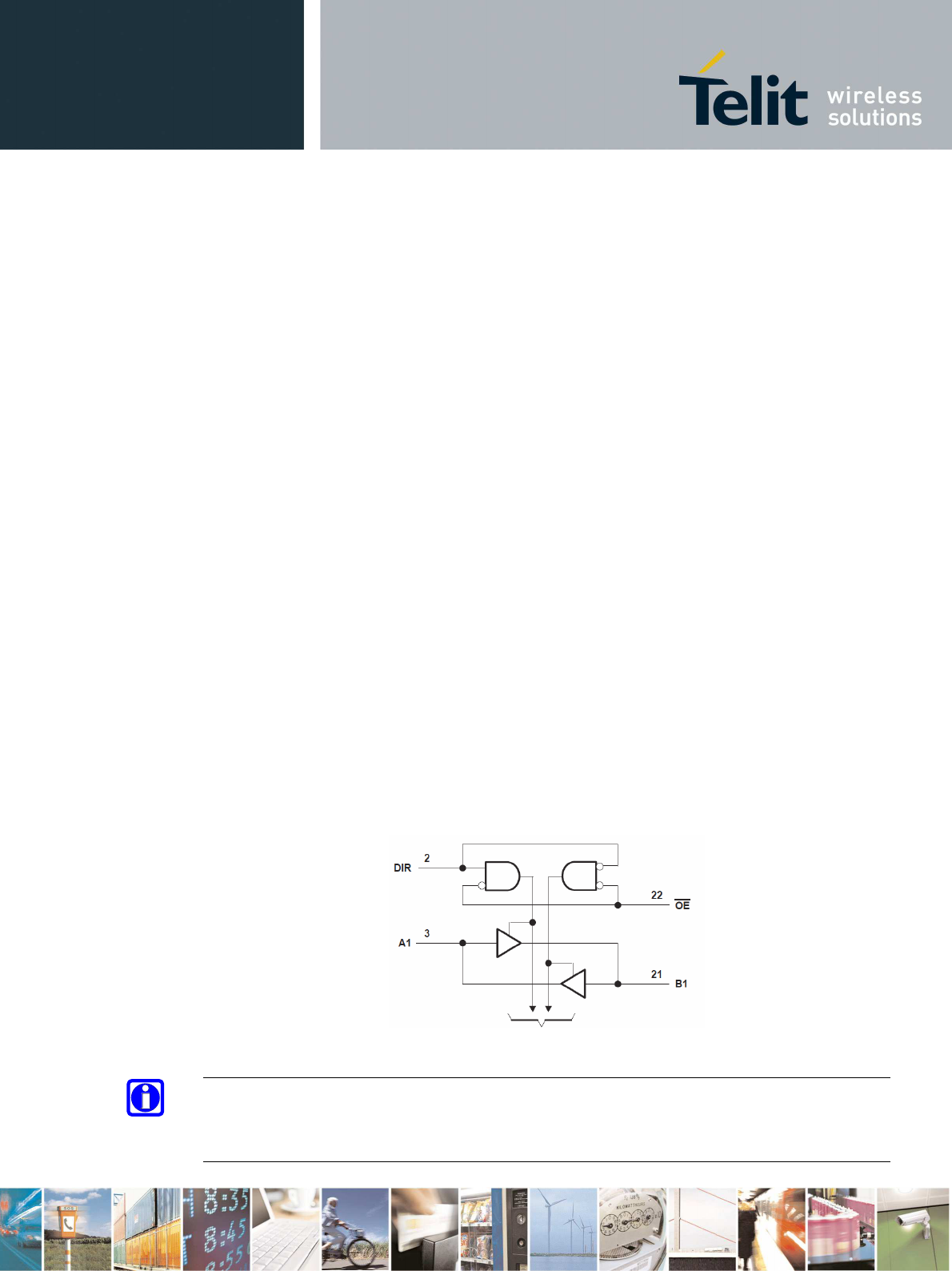
GE910 Hardware User Guide
1vv0300962 Rev.12 2013-10-22
Reproduction forbidden without Telit Communications S.p.A. written authorization - All Rights Reserved
page 50 of 83
Mod. 0805 2011-07 Rev.2
10. Serial Ports
The serial port on the GE910 is the core of the interface between the module and OEM hardware.
3 serial ports are available on the module:
• MODEM SERIAL PORT 1 (Main)
• MODEM SERIAL PORT 2 (Auxiliary)
• MODEM SERIAL PORT 3 (NMEA on GE910-GNSS products).
10.1. Modem Serial Port
Several configurations can be designed for the serial port on the OEM hardware, but the most
common are:
• RS232 PC com port
• microcontroller UART
@
1.8V (Universal Asynchronous Receive Transmit)
• microcontroller UART
@
3V or other voltages different from 1.8V
• microcontroller UART
@
5V or other voltages different from 1.8V
The serial port on the GE910 is a +1.8V CMOS UART with all the 8 RS232 signals. It differs
from the PC-RS232 in the signal polarity (RS232 is reversed) and levels.
For system working on different digital supply standard, a level translator circuit may be needed
to make the system work properly.
An Example of level translation implementation could be the use of a standard 74LVC245, a
Dual-Supply Bus Transceiver, which Logic Diagram is shown here:
To other Channels
NOTE:
OE connected to VAUX pin may be a useful solution to avoid Back-Powering by means of
disabling the bus, not to supply a voltage level, while modem is OFF.
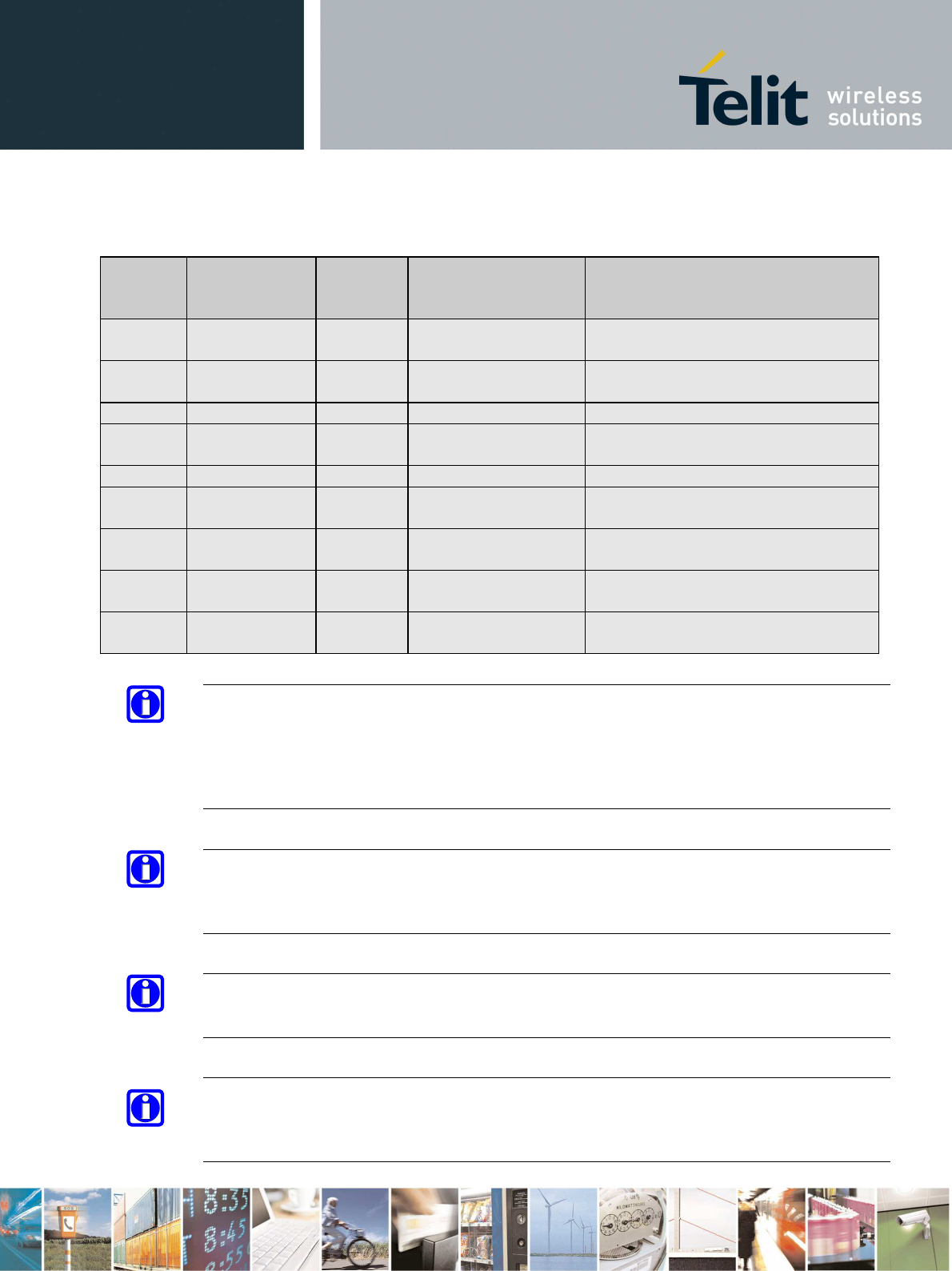
GE910 Hardware User Guide
1vv0300962 Rev.12 2013-10-22
Reproduction forbidden without Telit Communications S.p.A. written authorization - All Rights Reserved
page 51 of 83
Mod. 0805 2011-07 Rev.2
The signals of the GE910 Serial Port are:
RS232
Pin
Number
Signal GE910
Pad
Number
Name Usage
1 DCD - dcd_uart N14 Data Carrier Detect Output from the GE910 that indicates
the carrier presence
2 RXD - tx_uart M15 Transmit line *see
Note Output transmit line of GE910 UART
3 TXD -rx_uart N15 Receive line *see Note
Input receive of the GE910 UART
4 DTR - dtr_uart M14 Data Terminal Ready Input to the GE910 that controls the
DTE READY condition
5 GND P13 Ground Ground
6 DSR - dsr_uart P14 Data Set Ready Output from the GE910 that indicates
the module is ready
7 RTS -rts_uart L14 Request to Send Input to the GE910 that controls the
Hardware flow control
8 CTS - cts_uart P15 Clear to Send Output from the GE910 that controls
the Hardware flow control
9 RI - ri_uart R14 Ring Indicator Output from the GE910 that indicates
the incoming call condition
NOTE:
According to V.24, RX/TX signal names are referred to the application side, therefore on the
GE910 side these signal are on the opposite direction: TXD on the application side will be
connected to the receive line (here named TXD/ rx_uart ) of the GE910 serial port and vice
versa for RX.
NOTE:
For a minimum implementation, only the TXD and RXD lines can be connected, the other lines
can be left open provided a software flow control is implemented.
NOTE:
DTR pin should be disconnected before activating the Power Saving Mode.
NOTE:
In order to avoid a back powering effect it is recommended to avoid having HIGH logic level
signal applied to digital pins of the module when powered off or during an ON/OFF transition.

GE910 Hardware User Guide
1vv0300962 Rev.12 2013-10-22
Reproduction forbidden without Telit Communications S.p.A. written authorization - All Rights Reserved
page 52 of 83
Mod. 0805 2011-07 Rev.2
10.2. RS232 level translation
In order to interface the GE910 with a PC com port or a RS232 (EIA/TIA-232) application a
level translator is required. This level translator must:
• invert the electrical signal in both directions;
• change the level from 0/1.8V to +15/-15V
Actually, the RS232 UART 16450, 16550, 16650 & 16750 chipsets accept signals with lower
levels on the RS232 side (EIA/TIA-562), allowing a lower voltage-multiplying ratio on the level
translator. Note that the negative signal voltage must be less than 0V and hence some sort of
level translation is always required.
The simplest way to translate the levels and invert the signal is by using a single chip level
translator. There are a multitude of them, differing in the number of drivers and receivers and in
the levels (be sure to get a true RS232 level translator not a RS485 or other standards).
By convention the driver is the level translator from the 0-1.8V UART to the RS232 level. The
receiver is the translator from the RS232 level to 0-1.8V UART.
In order to translate the whole set of control lines of the UART you will need:
• 5 drivers
• 3 receivers
NOTE:
The digital input lines working at 1.8V CMOS have an absolute maximum input voltage of
2.1V; therefore the level translator IC shall not be powered by the +3.8V supply of the module.
Instead, it must be powered from a +1.8V (dedicated) power supply.
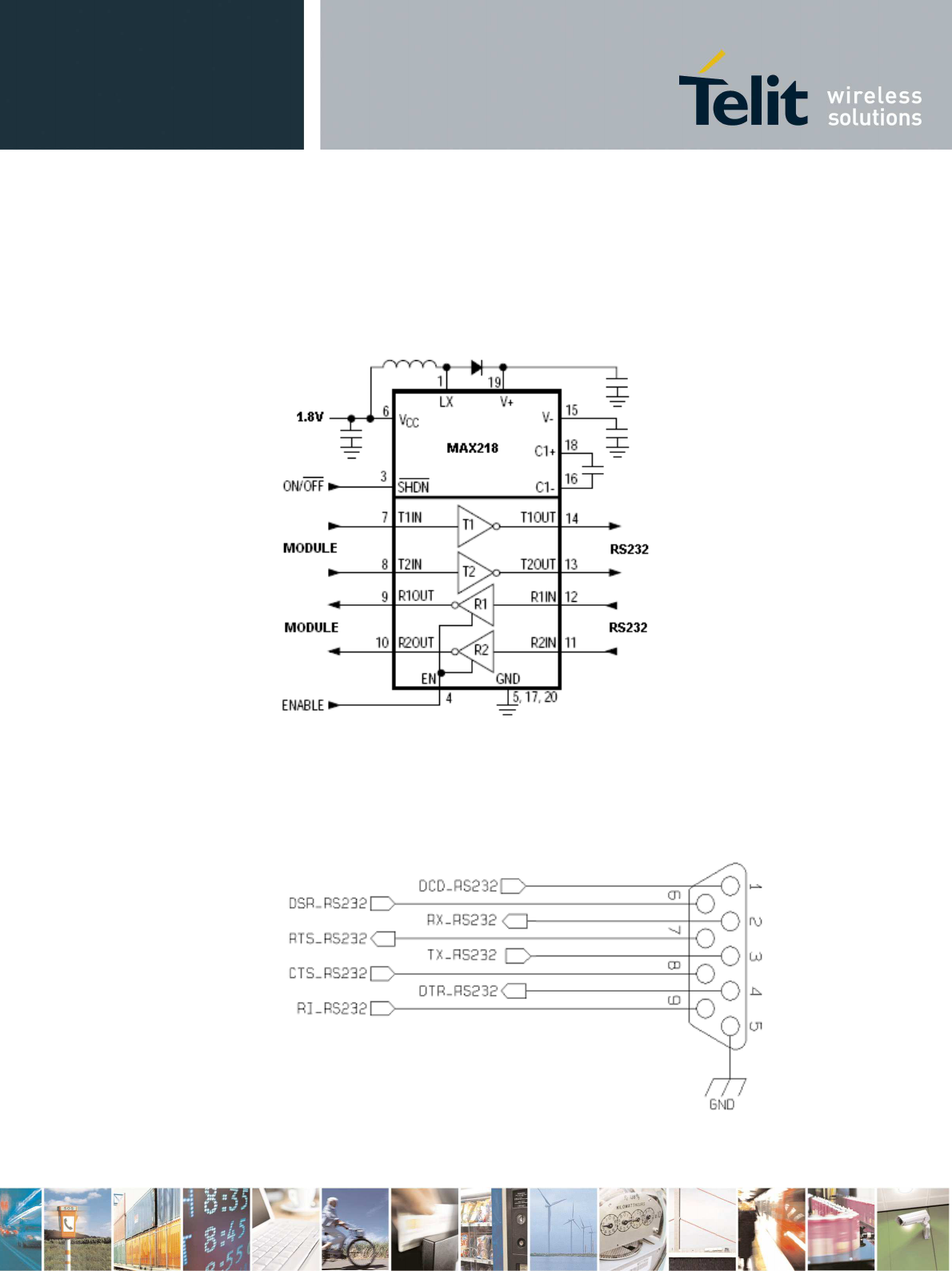
GE910 Hardware User Guide
1vv0300962 Rev.12 2013-10-22
Reproduction forbidden without Telit Communications S.p.A. written authorization - All Rights Reserved
page 53 of 83
Mod. 0805 2011-07 Rev.2
An example of RS232 level adaptation circuitry could be done using a MAXIM transceiver
(MAX218).
In this case the chipset is capable to translate directly from 0/1.8V to the RS232 levels (Example
done on 4 signals only).
The RS232 serial port lines are usually connected to a DB9 connector with the following layout:
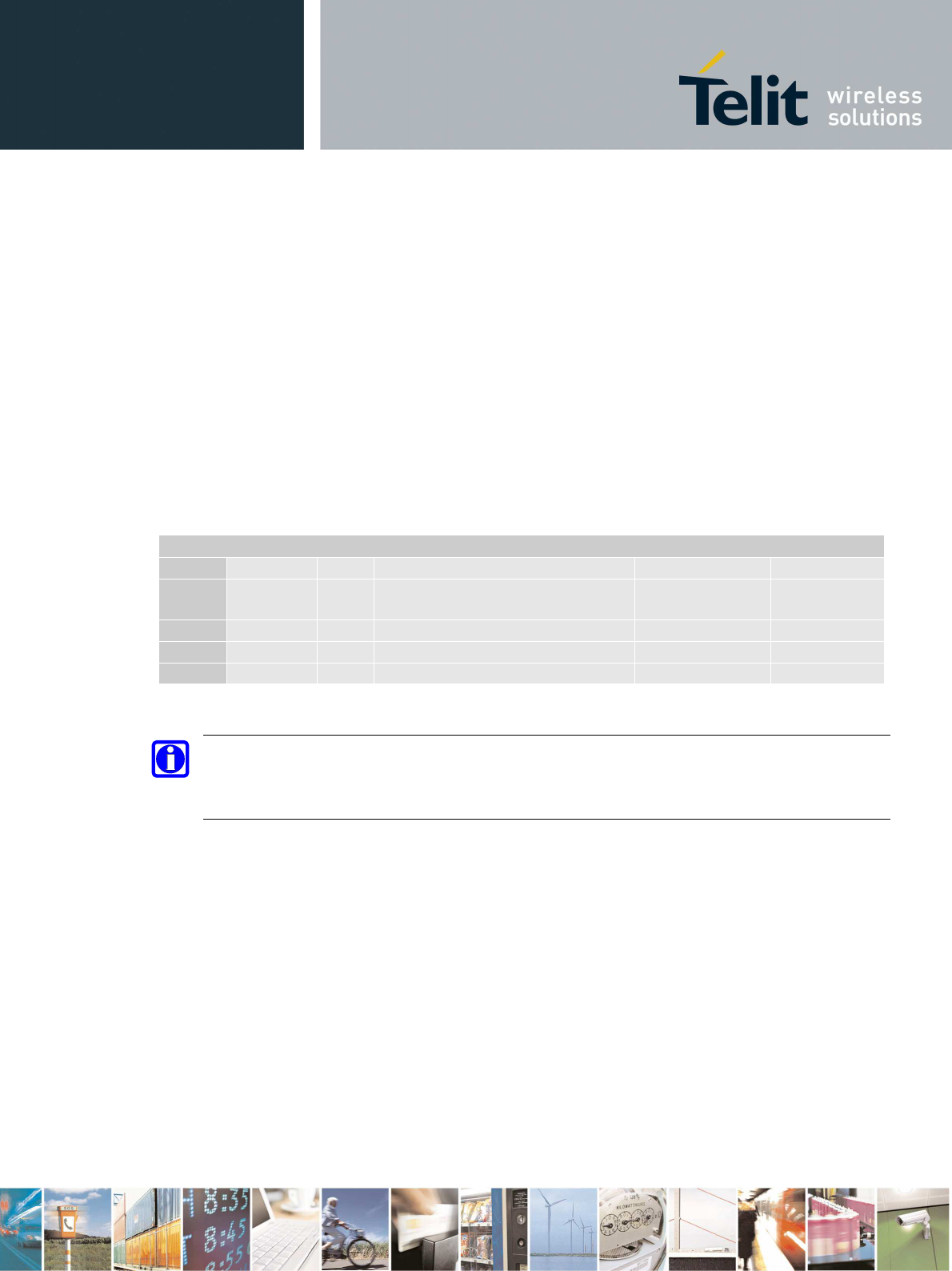
GE910 Hardware User Guide
1vv0300962 Rev.12 2013-10-22
Reproduction forbidden without Telit Communications S.p.A. written authorization - All Rights Reserved
page 54 of 83
Mod. 0805 2011-07 Rev.2
11. Audio Section Overview
The audio paths are:
• Digital Voice Interface (DVI).
• Analog Front-End.
11.1. Digital Voice Interface (DVI)
11.1.1. DVI Electrical Connections
The product is providing the Digital Audio Interface (DVI) on the following Pins:
Digital Voice Interface (DVI)
PAD Signal I/O Function Note Type
B9 DVI_WA0
I/O Digital Audio Interface (Word
Alignment / LRCLK) CMOS 1.8V
B6 DVI_RX I Digital Audio Interface (RX) CMOS 1.8V
B7 DVI_TX O Digital Audio Interface (TX) CMOS 1.8V
B8 DVI_CLK
I/O Digital Audio Interface (BCLK) CMOS 1.8V
NOTE:
For more information refer to Telit document: "80000NT10004a Digital Voice Interface
Application Note".
11.2. Analog Front-End
11.2.1. MIC connection
The bias for the microphone has to be as clean as possible; the first connection (single ended) is
preferable since the Vmic noise and ground noise are fed into the input as common mode and
then rejected. This sounds strange; usually the connection to use in order to reject the common
mode is the balanced one. In this situation we have to recall that the microphone is a sound to
current transducer, so the resistor is the current to tension transducer, so finally the resistor feeds
the input in balanced way even if the configuration, from a microphone point of view, seems to
be un-balanced.
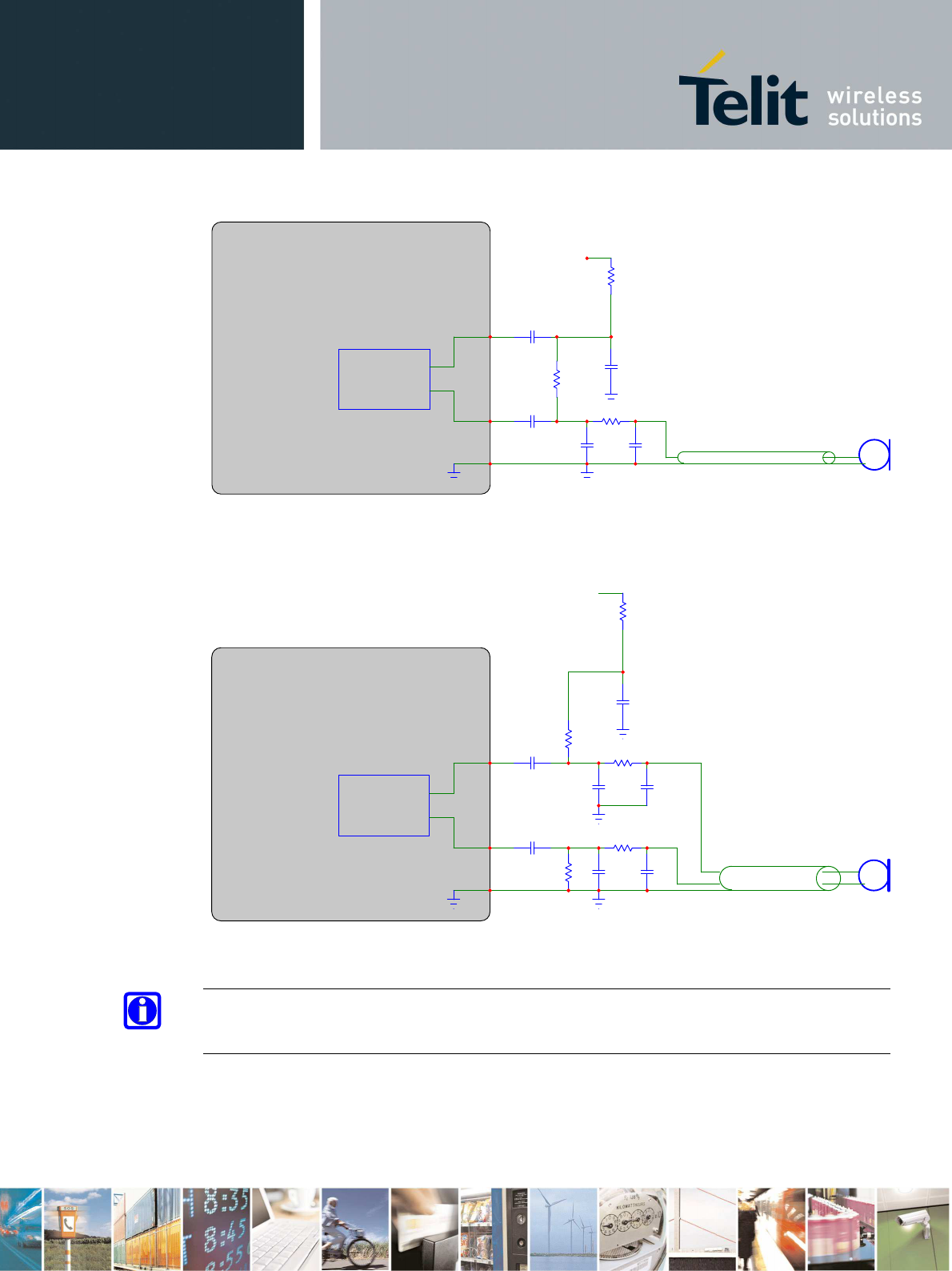
GE910 Hardware User Guide
1vv0300962 Rev.12 2013-10-22
Reproduction forbidden without Telit Communications S.p.A. written authorization - All Rights Reserved
page 55 of 83
Mod. 0805 2011-07 Rev.2
If a "balanced way" is anyway desired, much more care has to be taken to Vmic noise and
ground noise; also the 33pF-100Ohm-33pF -RF filter has to be doubled (one each wire).
100n 1K
1K
100
33pF 33pF
100n 100
33pF 33pF
1K
1u
MIC+
MIC-
GND
Vmic
÷10K
2÷5v
÷10u
TELIT MODULE
-
+
INPUTADC
TIP: Since the J-FET transistor inside the microphone acts as RF detector amplifier, ask vendor
for a microphone with anti-EMI capacitor (usually a 33pF or a 10pF capacitor placed across the
output terminals inside the case).
100n
100n
1K
2.2K
1u
100
33pF 33pF
÷10u
Vmic
MIC+
MIC-
GND
÷10K
2÷5v
TELIT MODULE
-
+
INPUTADC
+
-
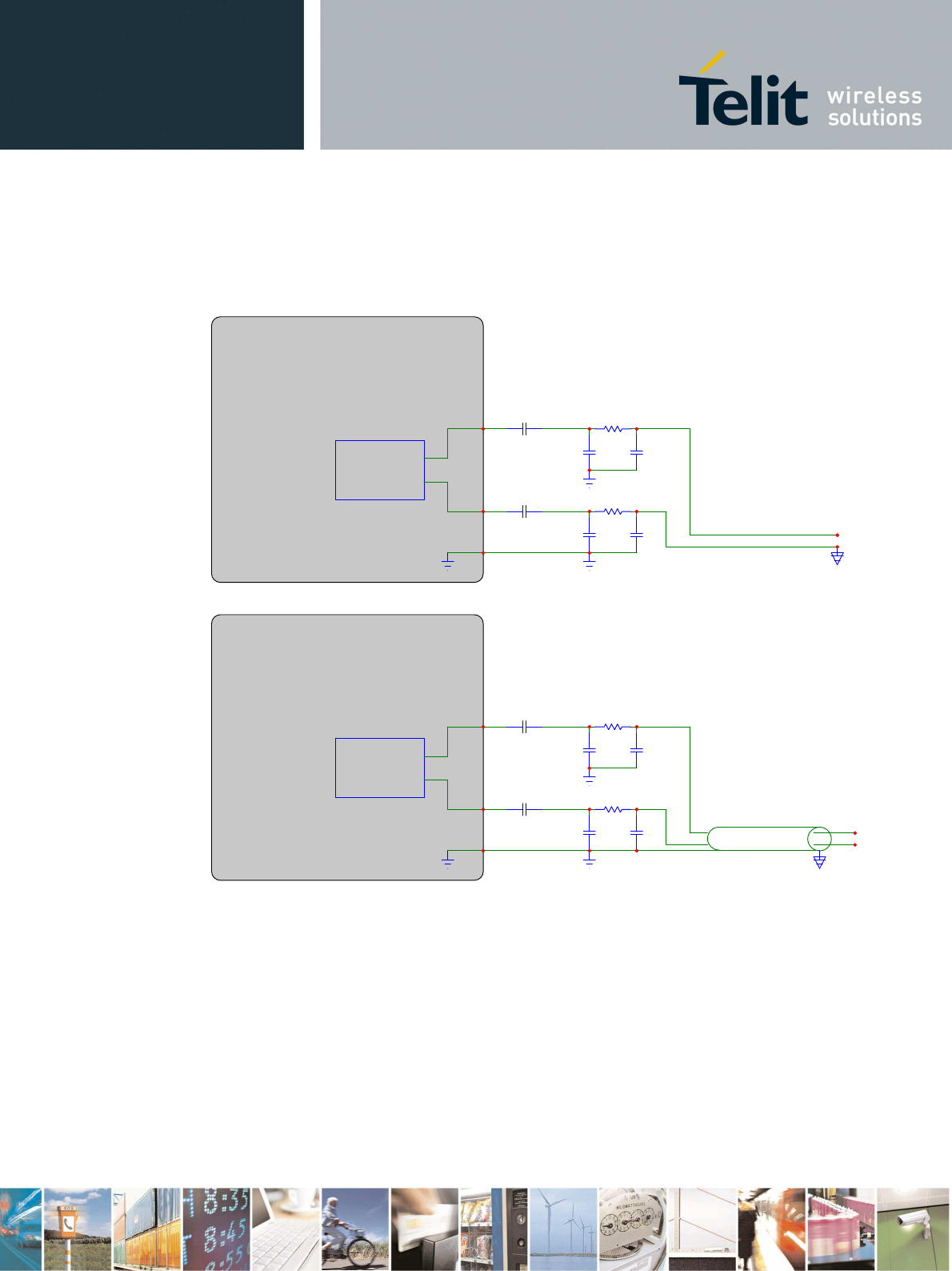
GE910 Hardware User Guide
1vv0300962 Rev.12 2013-10-22
Reproduction forbidden without Telit Communications S.p.A. written authorization - All Rights Reserved
page 56 of 83
Mod. 0805 2011-07 Rev.2
11.2.2. LINE-IN connection
100n 100
33pF 33pF
100n 100
33pF 33pF
MIC+
MIC-
GND
LINE_IN+1
Remote_GND
TELIT MODULE
-
+
INPUTADC
100n 100
33pF 33pF
100n 100
33pF 33pF
MIC+
MIC-
GND
TELIT MODULE
-
+
INPUTADC
LINE_IN+
LINE_IN-
If the audio source is not a mike but a different device, the following connections can be done.
Place 100nF capacitor in series with both inputs, so the DC current is blocked.
Place the 33pF-100Ohm-33pF -RF filter, in order to prevent some EMI field to get into the
high impedance high gain MIC inputs.
Since the input is differential, the common mode voltage noise between the two (different)
grounds is rejected, provided that both MIC+ & MIC- are connected directly onto the source.
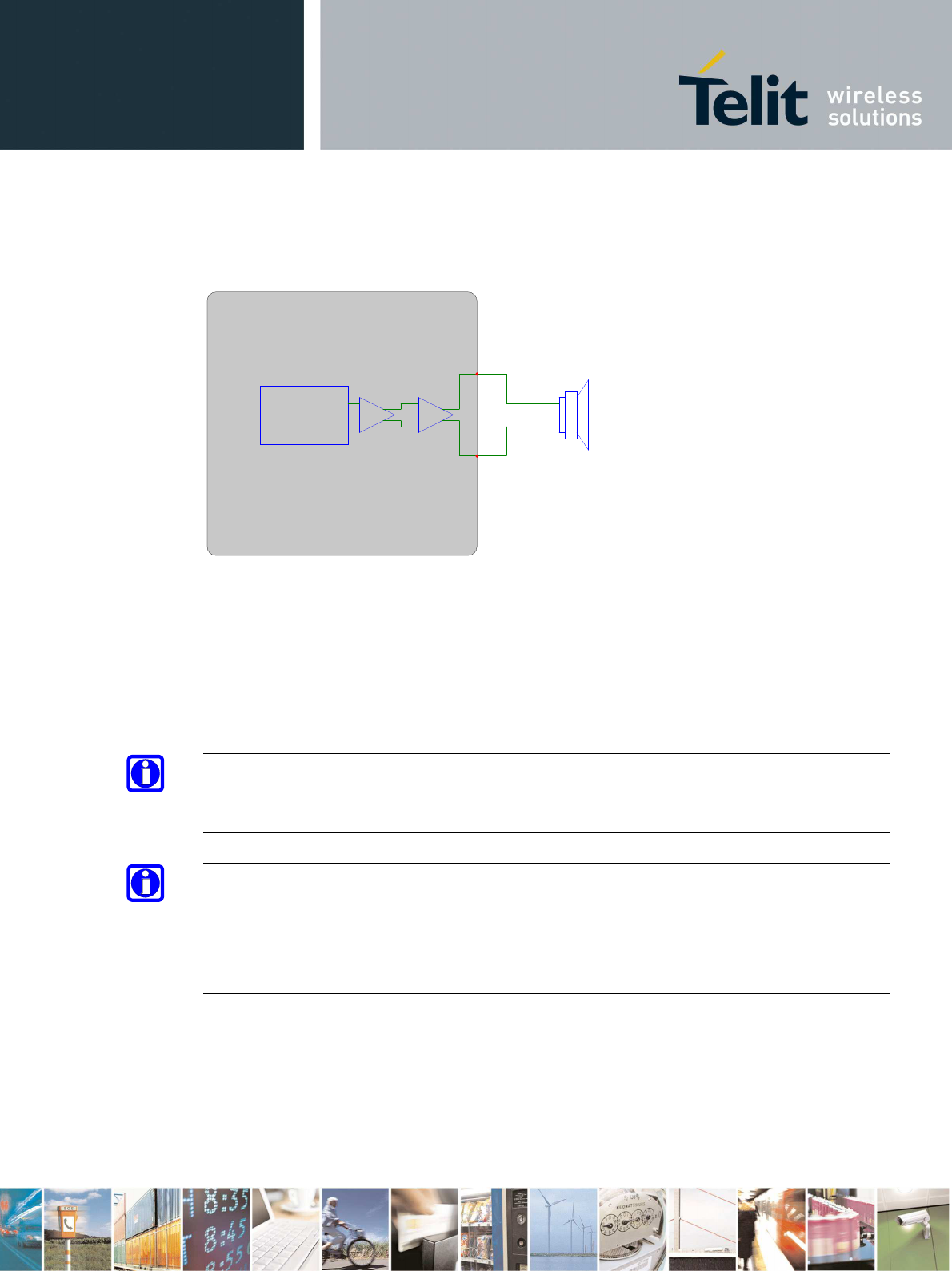
GE910 Hardware User Guide
1vv0300962 Rev.12 2013-10-22
Reproduction forbidden without Telit Communications S.p.A. written authorization - All Rights Reserved
page 57 of 83
Mod. 0805 2011-07 Rev.2
11.2.3. EAR connection
The audio output of the GE910 is balanced, this is helpful to double the level and to reject
common mode (click and pop are common mode and therefore rejected); furthermore the output
stage is class-D, so it can manage directly a loudspeaker with electrical impedance of at least
8Ohm. This stage is powered by switching from VBATT to GND at a frequency ranging from
0.6 to 2MHz, so it has a good efficiency and a power budget up to 0.7W; being a class-D
architecture, please use some caution (see the NOTE below).
NOTE:
When the loudspeaker is connected with a long cable, an L-C filter is recommended.
When the EAR+/- are feeding some electronic circuitry, an R-C filter is recommended.
TIP: in order to get the maximum audio level at a given output voltage level (dBspl/Vrms), the
following breaking through procedure can be used. Have the loudspeaker as close as you can to
the listener (this simplify also the echo cancelling); choose the loudspeaker with the higher
sensitivity (dBspl per W); choose loudspeakers with the impedance close to the limit (ex: 16 or 8
Ohm), in order to feed more power inside the transducer (it increases the W/Vrms ratio). If this
were not enough, an external amplifier should be used.
EAR+
EAR-
TELIT MODULE
-
+
OUTPUTDAC
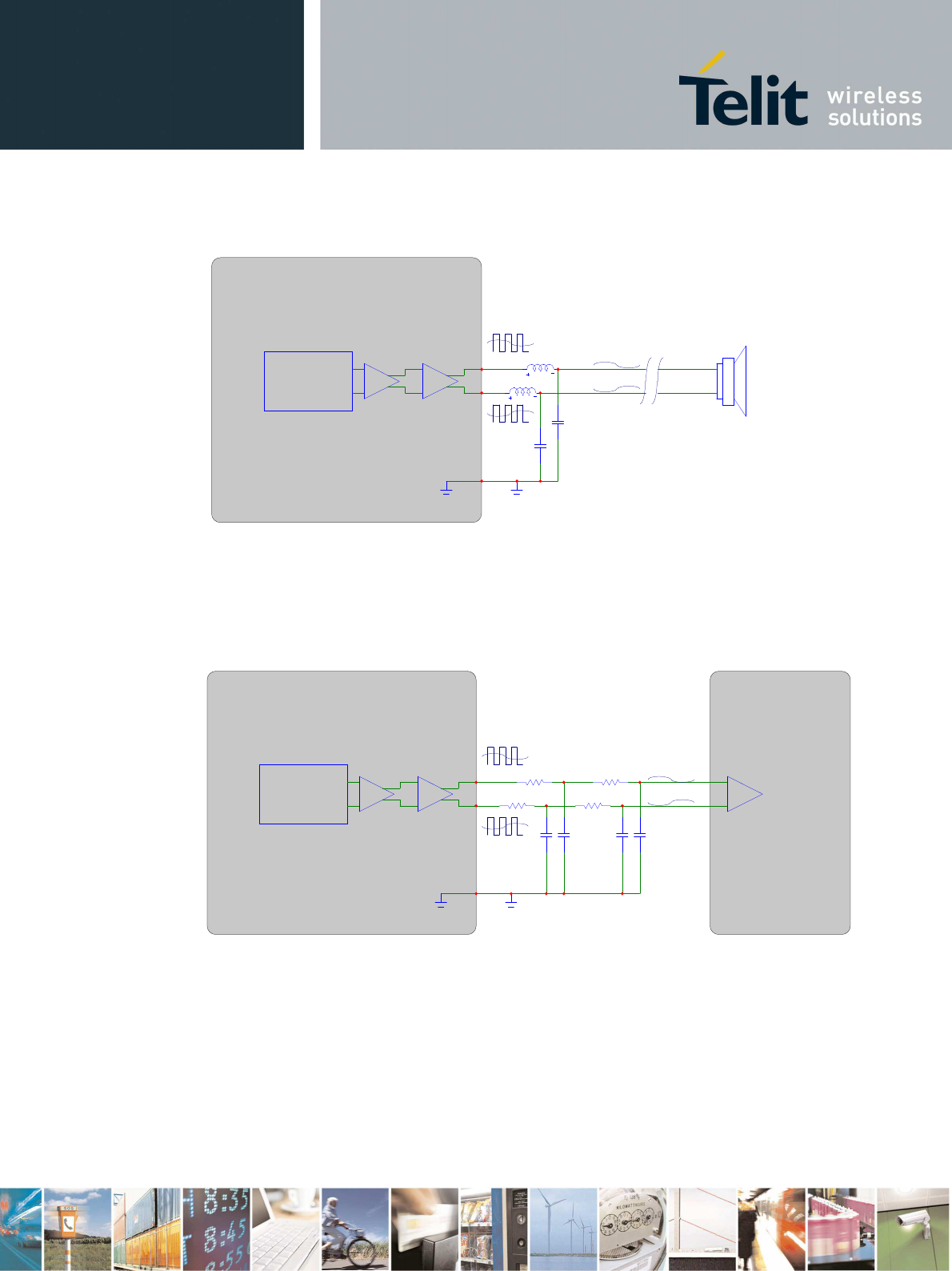
GE910 Hardware User Guide
1vv0300962 Rev.12 2013-10-22
Reproduction forbidden without Telit Communications S.p.A. written authorization - All Rights Reserved
page 58 of 83
Mod. 0805 2011-07 Rev.2
L-C filtering for LOW impedance load.
R-C filtering for HIGH impedance load.
EAR+
EAR-
TELIT MODULE
-
+
OUTPUTDAC
GND
EAR+
EAR-
TELIT MODULE
-
+
OUTPUT
DAC
GND
HiZ CIRCUITRY
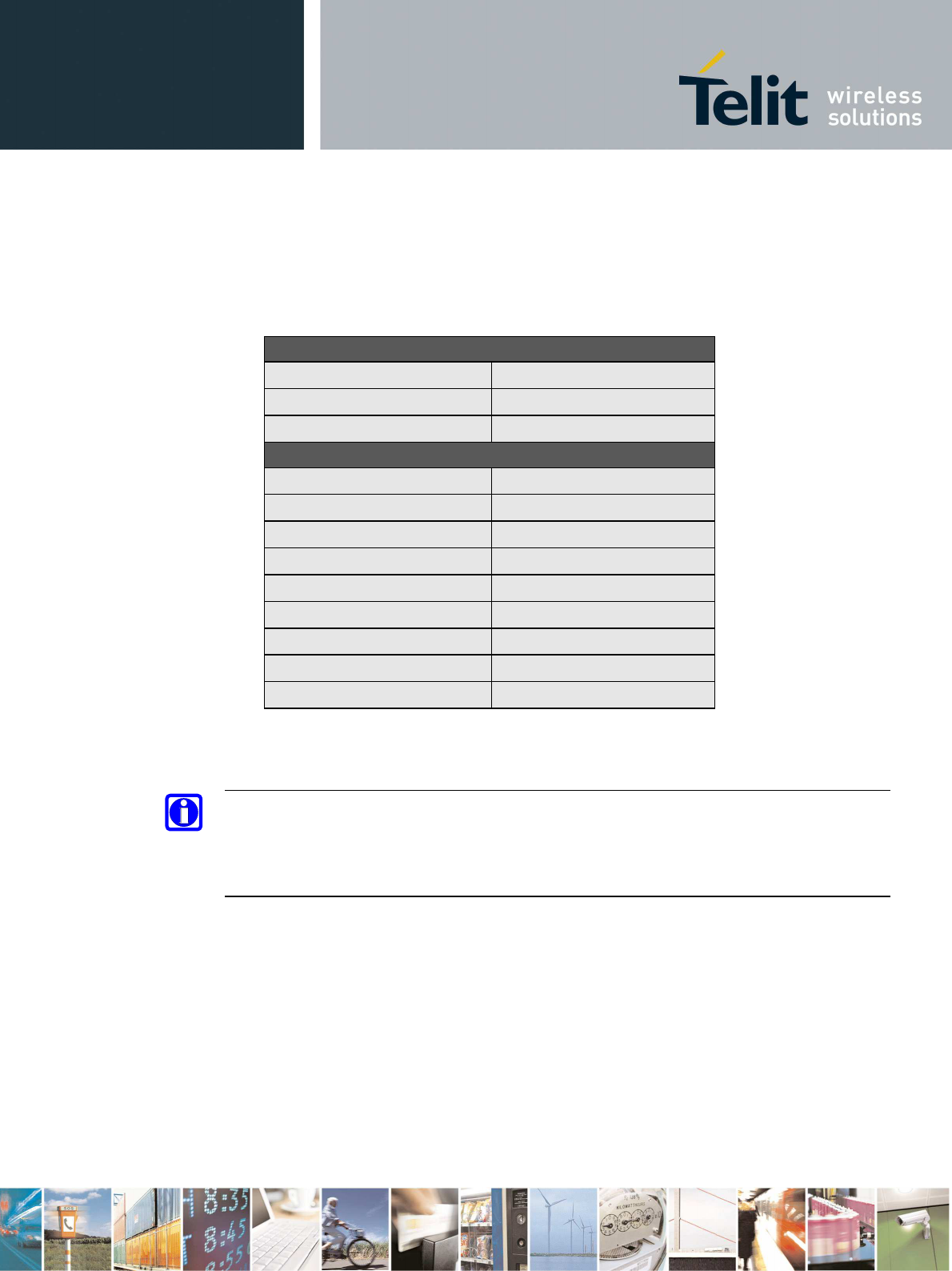
GE910 Hardware User Guide
1vv0300962 Rev.12 2013-10-22
Reproduction forbidden without Telit Communications S.p.A. written authorization - All Rights Reserved
page 59 of 83
Mod. 0805 2011-07 Rev.2
11.2.4. Electrical Characteristics
11.2.4.1. Input Lines
Microphone/Line-in path
Line Type Differential
Coupling capacitor 100nF
Differential input resistance 10k
Levels
To have 0dBm0 @1KHz (*)
Differential input voltage
AT#HFMICG=0 290mVrms
AT#HFMICG=1 (+6dB) 145mVrms
AT#HFMICG=2 (+12dB) 72mVrms
AT#HFMICG=3 (+18dB) 36mVrms
AT#HFMICG=4 (+24dB) 18mVrms
AT#HFMICG=5 (+30dB) 9mVrms
AT#HFMICG=6 (+36dB) 4.5mVrms
AT#HFMICG=7 (+42dB) 2.25mVrms
(*) 0 dBm0 in the network are -3.14 dBfs
TIP: The Electret microphone is internally amplified by a J-FET transistor, thus the sound is
carried out as saturation drain current; this means that the Norton equivalence has to be
considered. The signal is converted to voltage on the 2.2KOhm resistance, from there on
circuitry has to be routed in order to not pick up common mode noise; beware of the return
path (ground).
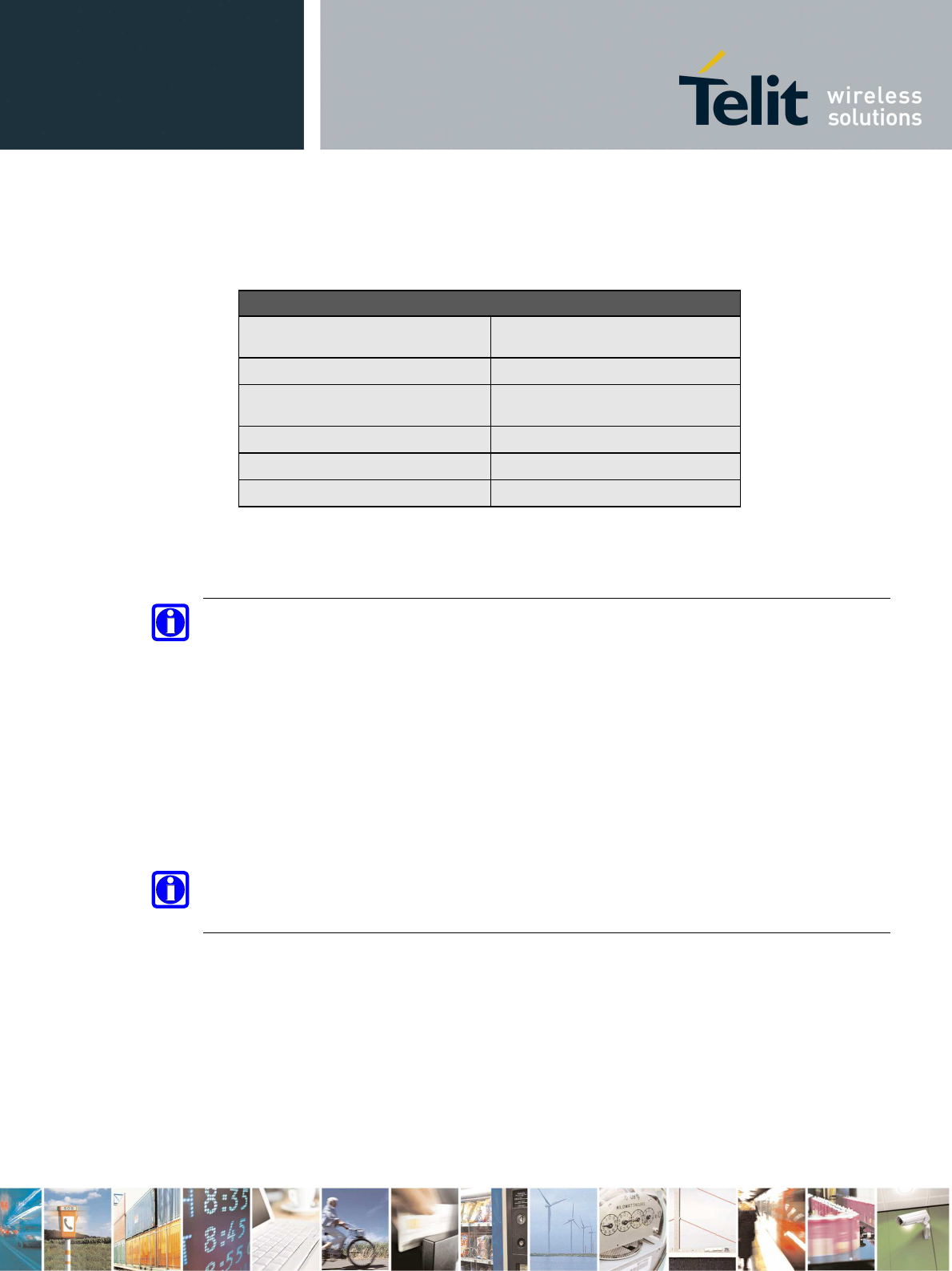
GE910 Hardware User Guide
1vv0300962 Rev.12 2013-10-22
Reproduction forbidden without Telit Communications S.p.A. written authorization - All Rights Reserved
page 60 of 83
Mod. 0805 2011-07 Rev.2
11.2.4.2. Output Lines
EAR/Line-out Output
Differential line coupling Direct connection
(V
DC
=1.3÷1.6V)
output load resistance 8
signal bandwidth 250÷3400Hz
(@ -3dB with default filter)
max. differential output voltage 1120mV
pp
@3.14dBm0 (*)
differential output voltage 550mV
rms
@0dBm0 (*)
volume -20÷0 dB step 2dB
(*) in default condition: AT+CLVL=10, AT#HFRECG=0
TIP:
We suggest driving the load differentially; this kills all the common mode noises (click and pop,
for example), the output swing will double (+6dB) and the big output coupling capacitor will be
avoided.
However if particular OEM application needs, also a Single Ended
(S.E)
circuitry can be
implemented. The OEM circuitry shall be designed to reduce the common mode noise typically
generated by the return path of the big currents.
In order to get the maximum power output from the device, the resistance of the tracks has to be
negligible in comparison to the load.
NOTES:
For more information refer to Telit document: "80000NT10007a Audio Settings Application
Note".
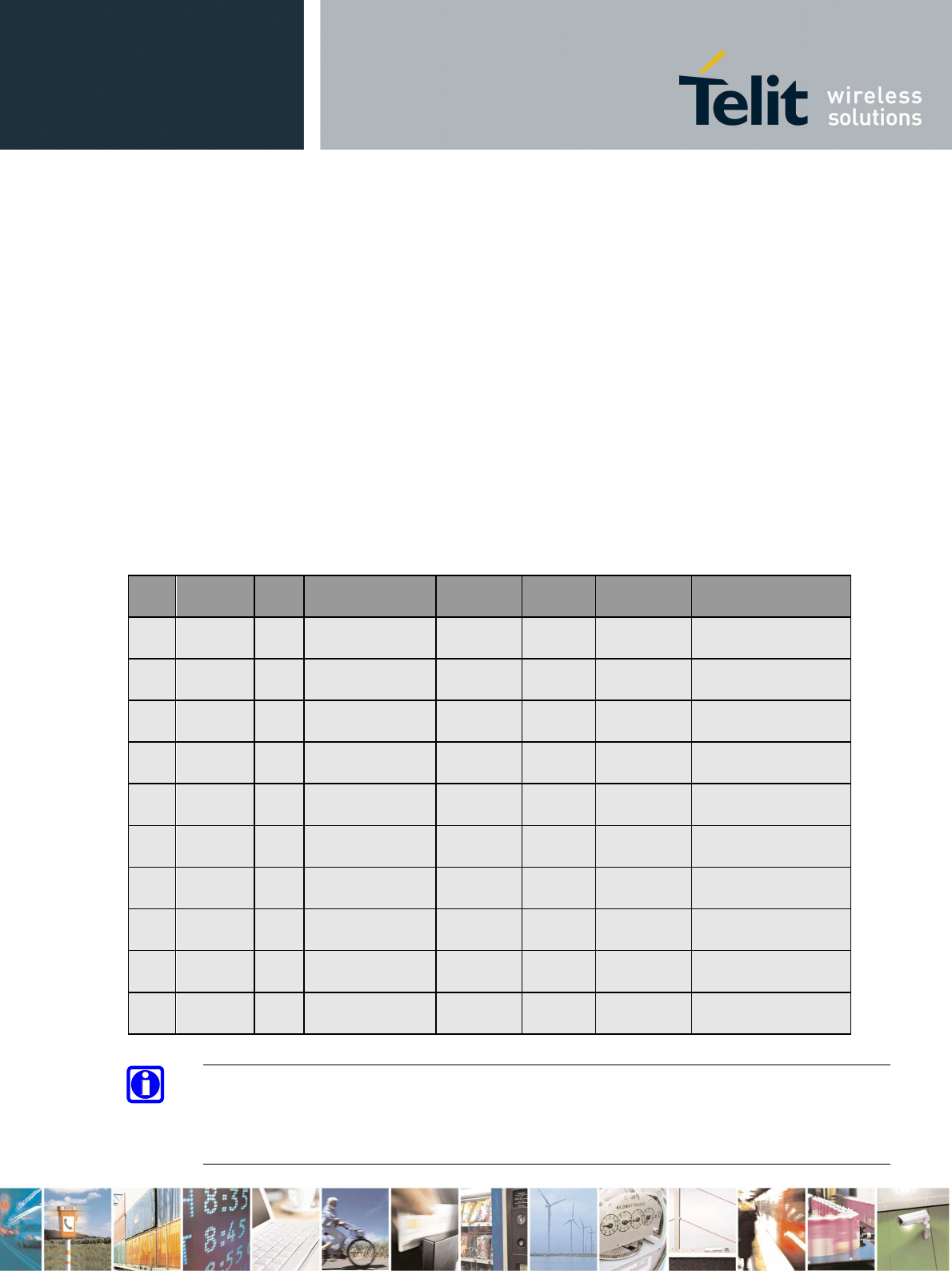
GE910 Hardware User Guide
1vv0300962 Rev.12 2013-10-22
Reproduction forbidden without Telit Communications S.p.A. written authorization - All Rights Reserved
page 61 of 83
Mod. 0805 2011-07 Rev.2
12. General Purpose I/O
The general purpose I/O pads can be configured to act in three different ways:
• input
• output
• alternate function (internally controlled)
Input pads: they report the digital value (high or low) present on the pad at the moment of
reading.
Output pads: can be written, set the output value of the pad, and read.
Alternate function pad: internally controlled by the GE910 firmware and acts depend on
implemented function.
The following table shows the available GPIO on the GE910.
PAD
Signal I/O Function Type Drive
strength
Default
State Note
C8 GPIO_01
I/O Configurable
GPIO CMOS
1.8V 1 mA INPUT PD
Alternate function
STAT LED
C9 GPIO_02
I/O Configurable
GPIO CMOS
1.8V 1 mA INPUT PD
C10
GPIO_03
I/O Configurable
GPIO CMOS
1.8V 1 mA INPUT PD
C11
GPIO_04
I/O Configurable
GPIO CMOS
1.8V 1 mA INPUT PD
B14
GPIO_05
I/O Configurable
GPIO CMOS
1.8V 1 mA INPUT PD
Alternate function
RFTXMON
C12
GPIO_06
I/O Configurable
GPIO CMOS
1.8V 1 mA INPUT PD
C13
GPIO_07
I/O Configurable
GPIO CMOS
1.8V 1 mA INPUT PD
K15
GPIO_08
I/O Configurable
GPIO CMOS
1.8V 1 mA INPUT PD
L15
GPIO_09
I/O Configurable
GPIO CMOS
1.8V 1 mA INPUT PD
G15
GPIO_10
I/O Configurable
GPIO CMOS
1.8V 1 mA INPUT PD
NOTE:
Pull-Up or Pull-Down can be set on every GPIO, see “AT Commands Reference Guide”.
By default at start time, if no previous set were saved, they are set as Input Pull-Down.

GE910 Hardware User Guide
1vv0300962 Rev.12 2013-10-22
Reproduction forbidden without Telit Communications S.p.A. written authorization - All Rights Reserved
page 62 of 83
Mod. 0805 2011-07 Rev.2
12.1. Using a GPIO Pad as INPUT
The GPIO pads, when used as inputs, can be connected to a digital output of another device and
report its status, provided this device has interface levels compatible with the 1.8V CMOS levels
of the GPIO.
If the digital output of the device to be connected with the GPIO input pad has interface levels
different from the 1.8V CMOS, then it can be buffered with an open collector transistor with a
47K pull up to 1.8V.
NOTE:
In order to avoid a back powering effect it is recommended to avoid having any HIGH logic
level signal applied to the digital pins of the GE910 when the module is powered off or during
an ON/OFF transition.
12.2. Using a GPIO Pad as OUTPUT
The GPIO pads, when used as outputs, can drive 1.8V CMOS digital devices or compatible
hardware. When set as outputs, the pads have a push-pull output and therefore the pull-up
resistor may be omitted.
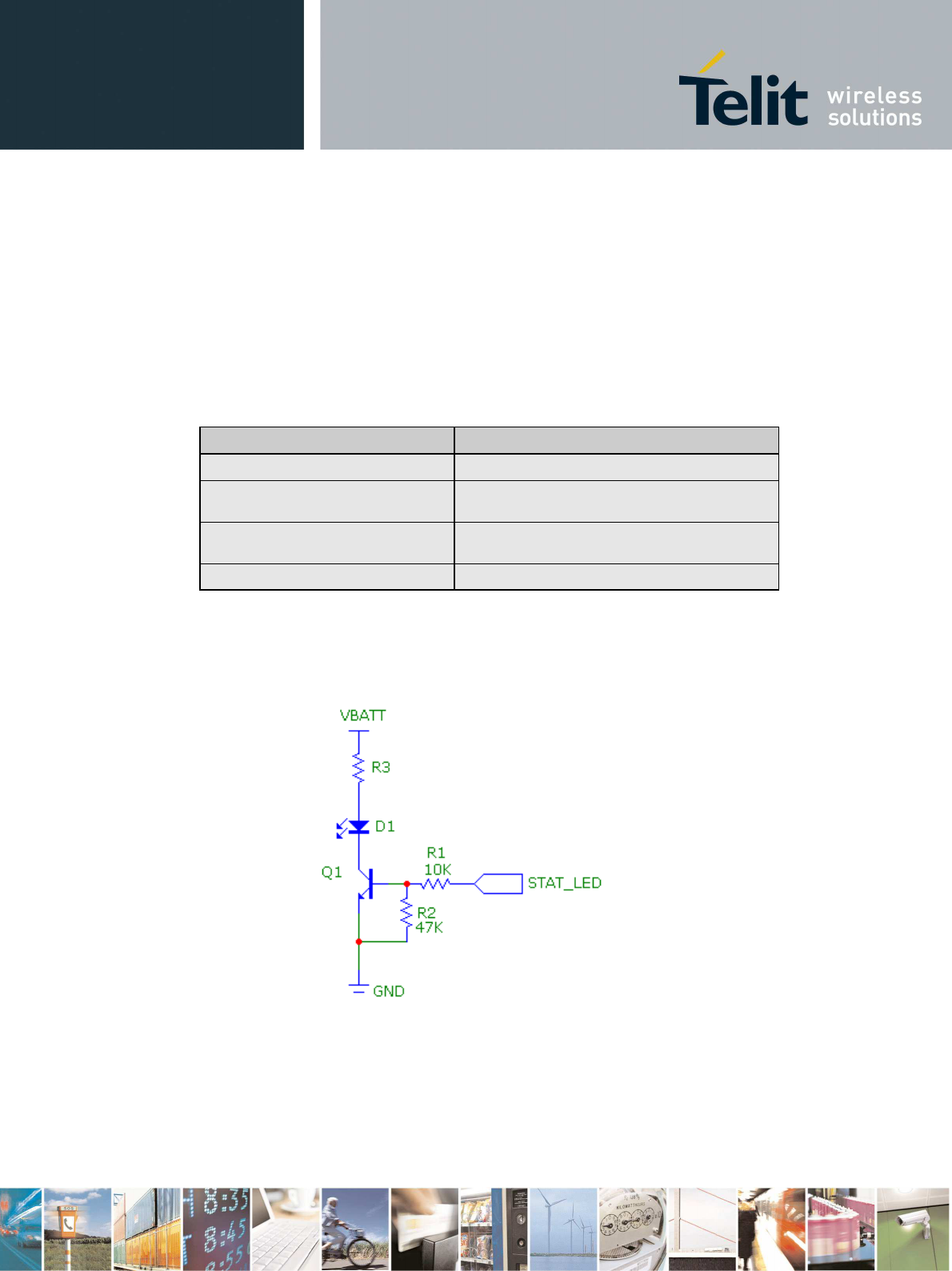
GE910 Hardware User Guide
1vv0300962 Rev.12 2013-10-22
Reproduction forbidden without Telit Communications S.p.A. written authorization - All Rights Reserved
page 63 of 83
Mod. 0805 2011-07 Rev.2
12.3. Indication of network service availability
The STAT_LED pin status shows information on the network service availability and Call status.
In the GE910 modules, the STAT_LED usually needs an external transistor to drive an external
LED.
Therefore, the status indicated in the following table is reversed with respect to the pin status.
LED status Device Status
Permanently off Device off
Fast blinking
(Period 1s, Ton 0,5s) Net search / Not registered / turning off
Slow blinking
(Period 3s, Ton 0,3s) Registered full service
Permanently on a call is active
A schematic example could be:
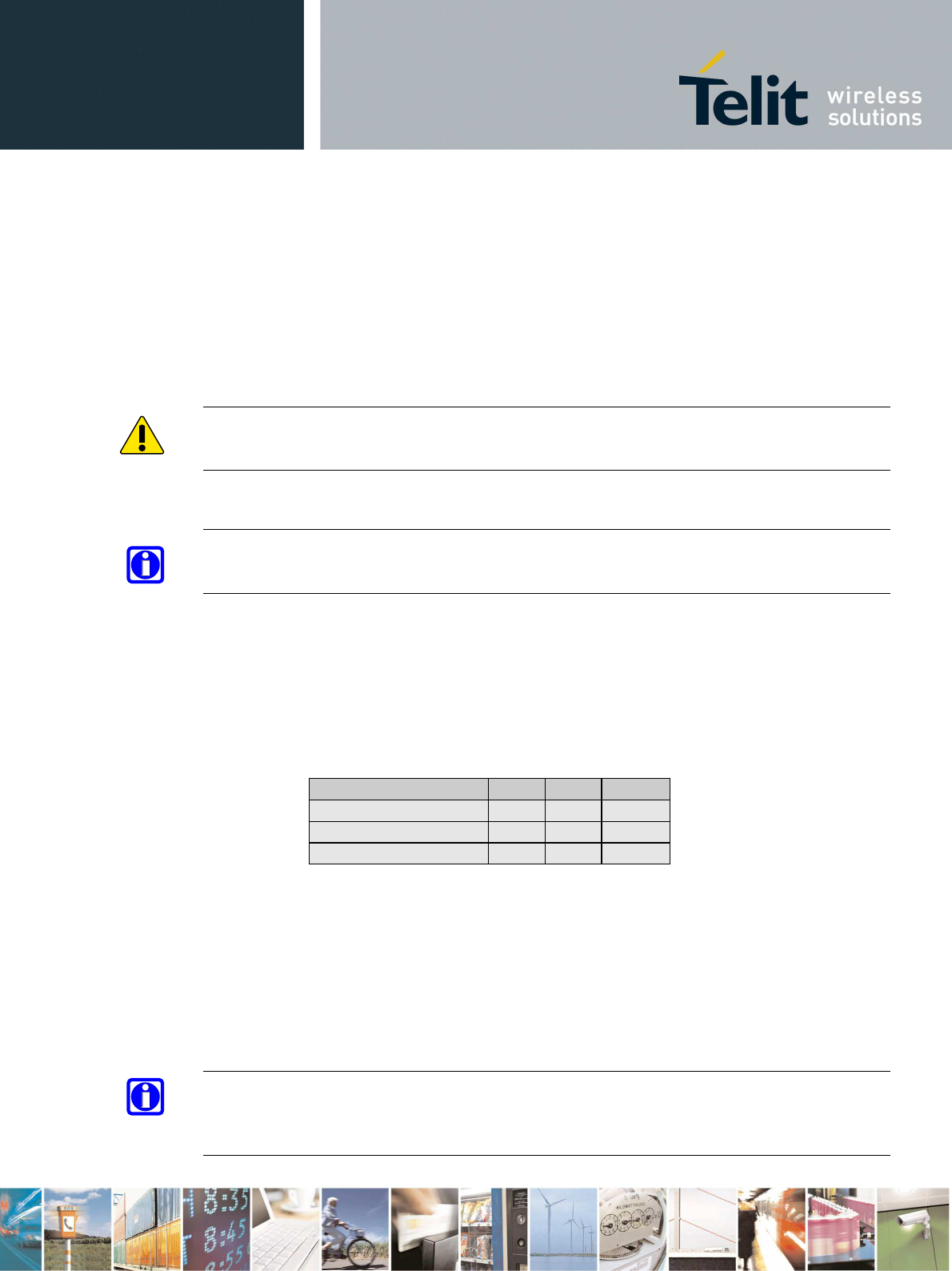
GE910 Hardware User Guide
1vv0300962 Rev.12 2013-10-22
Reproduction forbidden without Telit Communications S.p.A. written authorization - All Rights Reserved
page 64 of 83
Mod. 0805 2011-07 Rev.2
12.4. RTC Bypass out
The VRTC pin brings out the Real Time Clock supply, which is separate from the rest of the
digital part, allowing having only RTC going on when all the other parts of the device are off.
To this power output a backup capacitor can be added in order to increase the RTC autonomy
during power off of the battery. NO Devices must be powered from this pin.
If ON_OFF* signal is connected to GND, the RTC autonomy will decrease.
WARNING:
Never connect VRTC pin to VBATT.
12.5. External SIM Holder Implementation
NOTE:
Please refer to the related User Guide (SIM Holder Design Guides, 80000NT10001a).
12.6. ADC Converter
12.6.1. Description
The on board ADC has 10-bit resolution.
It is able to read a voltage level in the range of 0÷1.3 volts, to store and to convert into a 10 bits
word.
Min Max Units
Input Voltage range 0 1.3 Volt
AD conversion - 10 bits
Resolution - < 1.3 mV
The ADC input line is named as ADC_IN1 and it is available on PAD B1.
12.6.2. Using ADC Converter
AT command to manage the ADC is:
AT#ADC=1,2
The read value is expressed in mV
NOTE:
Refer to SW User Guide or AT Commands Reference Guide for the full description of this
function.
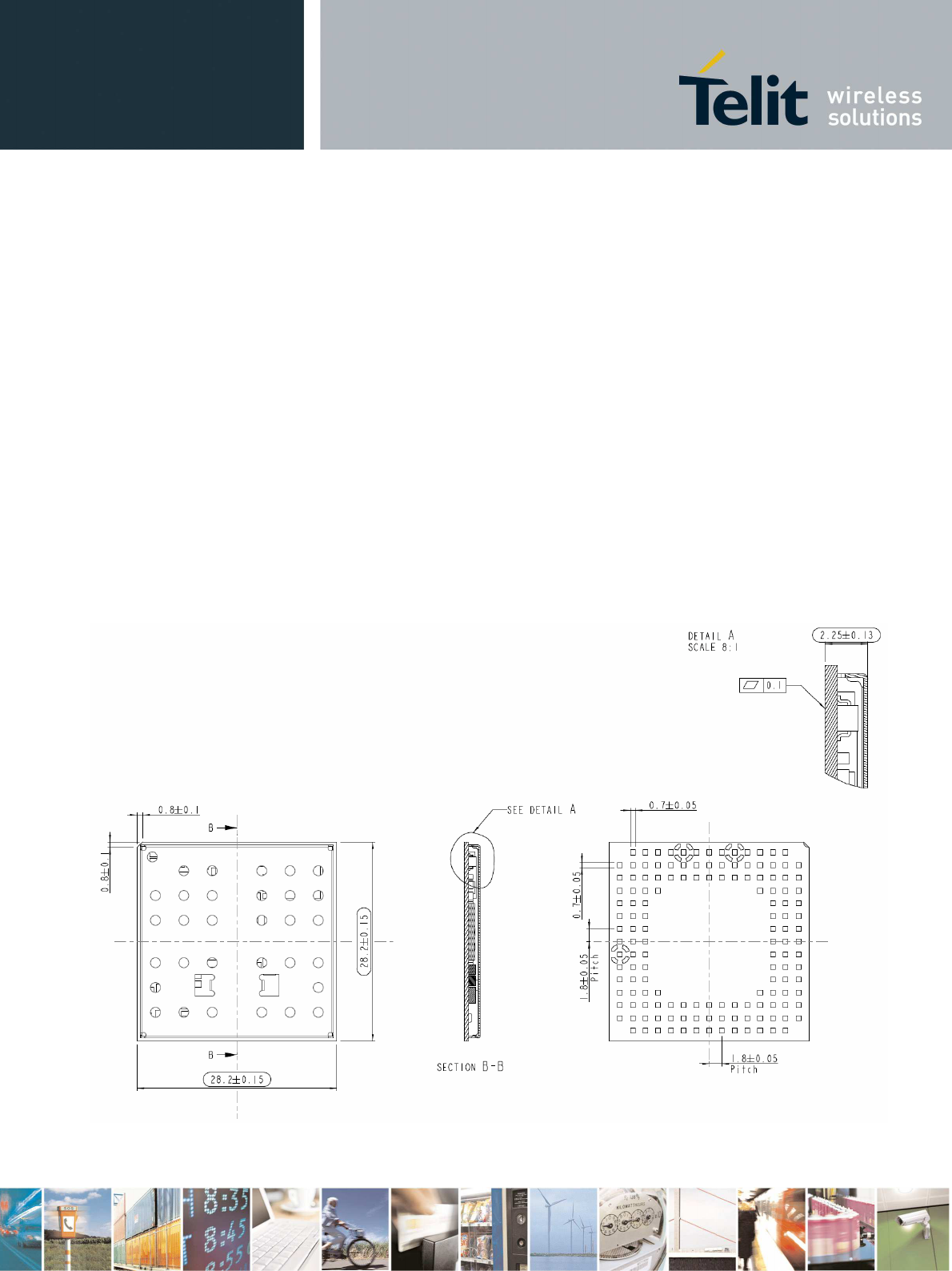
GE910 Hardware User Guide
1vv0300962 Rev.12 2013-10-22
Reproduction forbidden without Telit Communications S.p.A. written authorization - All Rights Reserved
page 65 of 83
Mod. 0805 2011-07 Rev.2
13. Mounting the GE910 on your Board
13.1. General
The GE910 modules have been designed in order to be compliant with a standard lead-free SMT
process.
13.2. Module finishing & dimensions
The GE910 overall dimensions are:
• Length: 28.2 mm
• Width: 28.2 mm
• Thickness: 2.25 mm
• Weight: 3.6 g
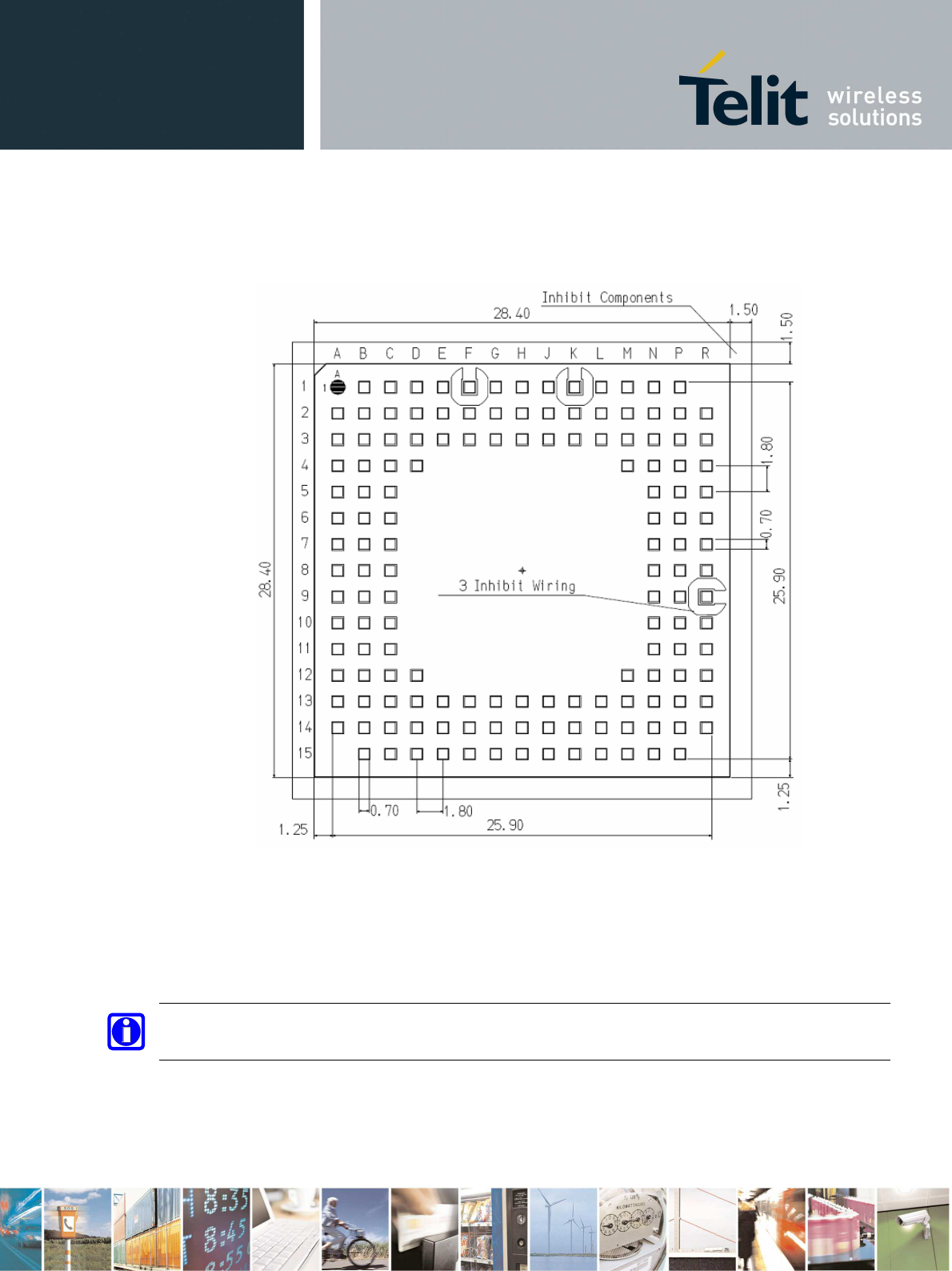
GE910 Hardware User Guide
1vv0300962 Rev.12 2013-10-22
Reproduction forbidden without Telit Communications S.p.A. written authorization - All Rights Reserved
page 66 of 83
Mod. 0805 2011-07 Rev.2
13.3. Recommended foot print for the application
In order to easily rework the GE910 is suggested to consider on the application a 1.5mm Inhibit
area around the module.
It is also suggested, as common rule for an SMT component, to avoid having a mechanical part
of the application in direct contact with the module.
NOTE:
In the customer application, the region under INHIBIT WIRING must be clear
from signal or ground paths.
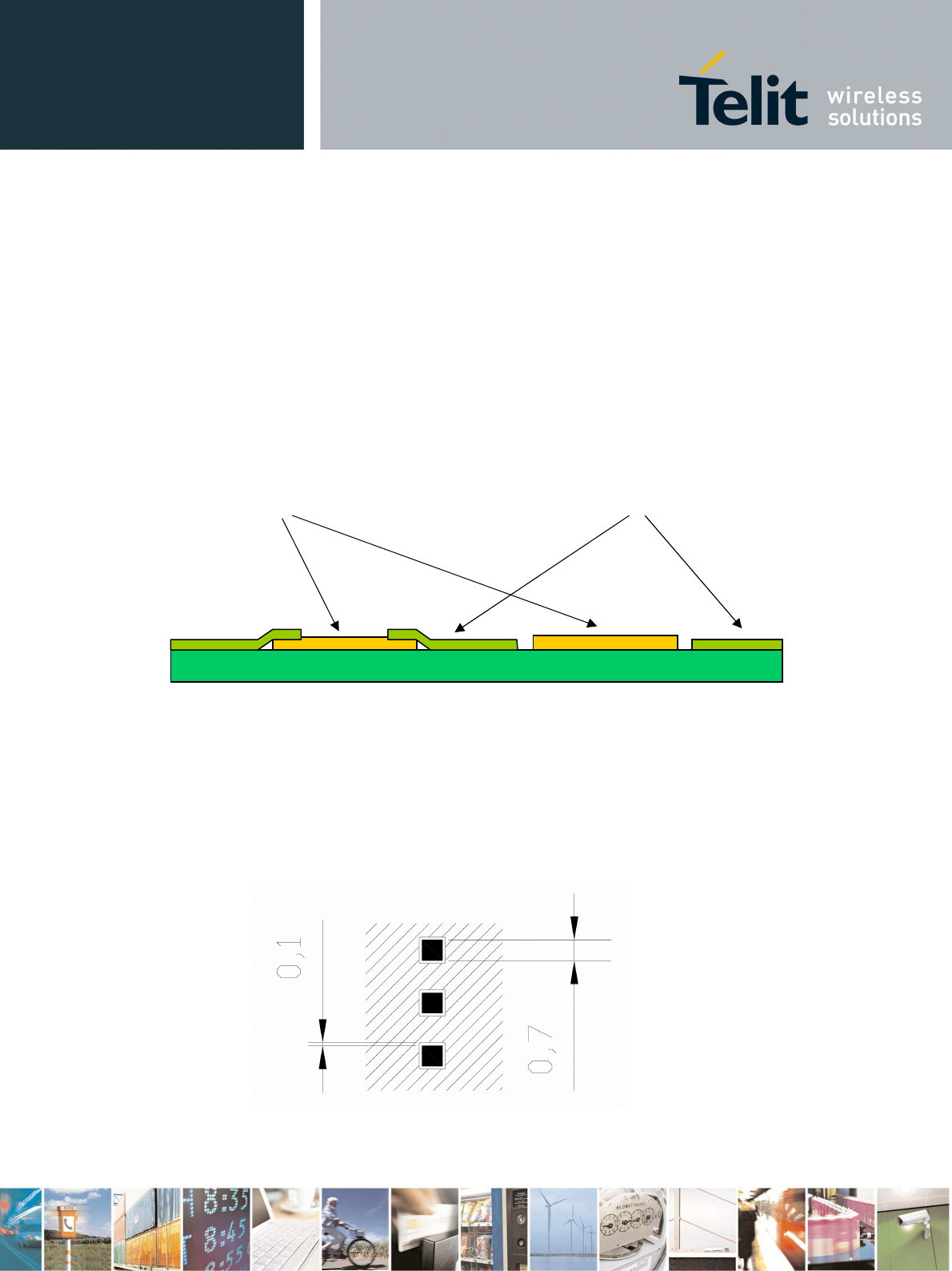
GE910 Hardware User Guide
1vv0300962 Rev.12 2013-10-22
Reproduction forbidden without Telit Communications S.p.A. written authorization - All Rights Reserved
page 67 of 83
Mod. 0805 2011-07 Rev.2
13.4. Stencil
Stencil’s apertures layout can be the same of the recommended footprint (1:1), we suggest a
thickness of stencil foil 120µm.
13.5. PCB pad design
Non solder mask defined (NSMD) type is recommended for the solder pads on the PCB.
13.6. Recommendations for PCB pad dimensions
Units are in mm.
PCB
Copper Pad
Pad
Solder Mask
SMD
(Solder Mask Defined)
NSMD
(Non Solder Mask Defined)
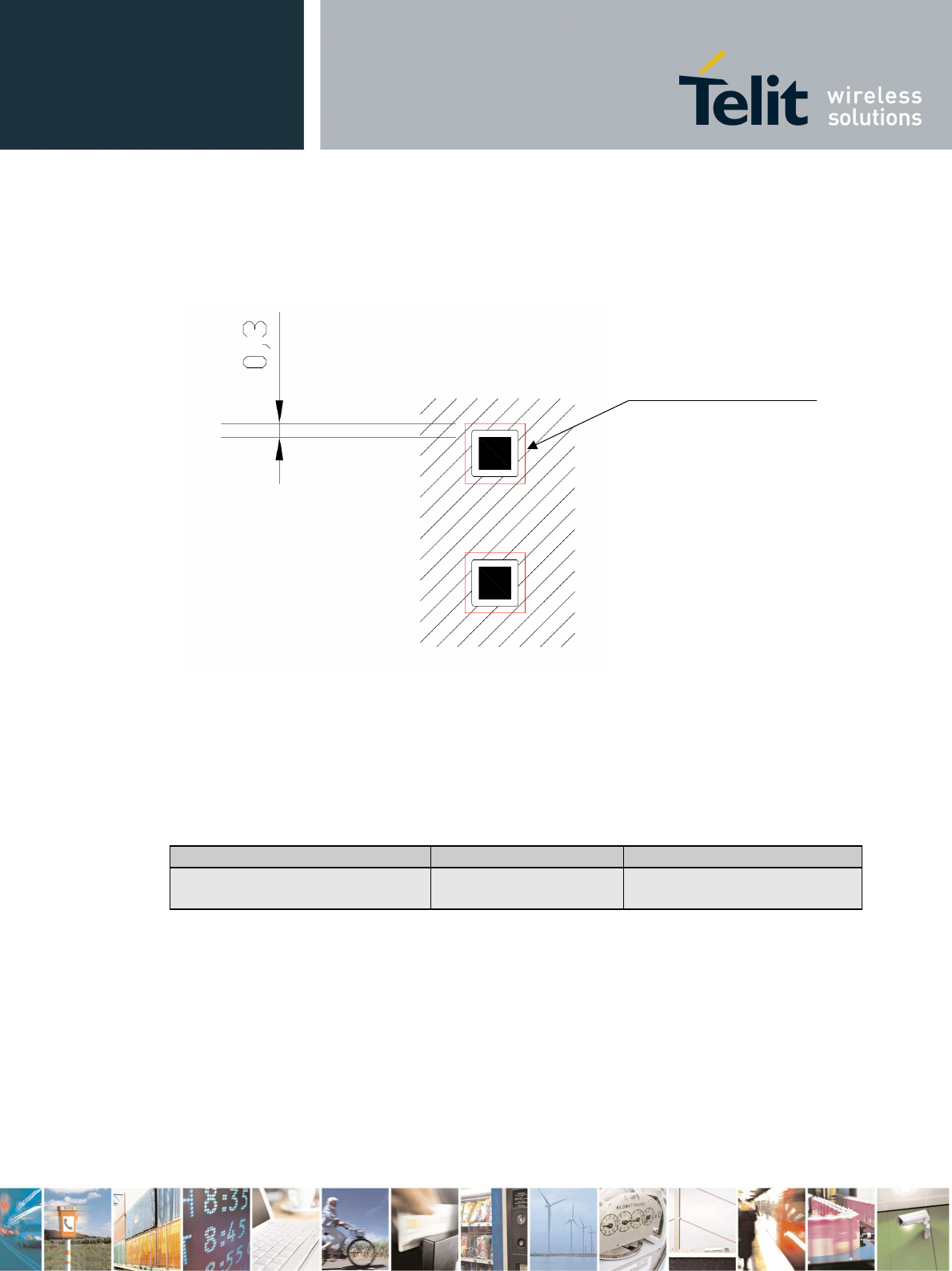
GE910 Hardware User Guide
1vv0300962 Rev.12 2013-10-22
Reproduction forbidden without Telit Communications S.p.A. written authorization - All Rights Reserved
page 68 of 83
Mod. 0805 2011-07 Rev.2
It is not recommended to place via or micro-via not covered by solder resist in an area of
0.3 mm around the pads unless it carries the same signal of the pad itself (see following
figure).
Holes in pad are allowed only for blind holes and not for through holes. When using the hole in
pad, we suggest the via filling.
Recommendations for PCB pad surfaces:
Finish Layer thickness [µm] Properties
Electro-less Ni / Immersion Au 3 –7 / 0.05 – 0.15 good solder ability protection,
high shear force values
The PCB must be able to resist the higher temperatures which are occurring at the lead-free
process. This issue should be discussed with the PCB-supplier. Generally, the wettability of tin-
lead solder paste on the described surface plating is better compared to lead-free solder paste.
Inhibit area for micro
-
via
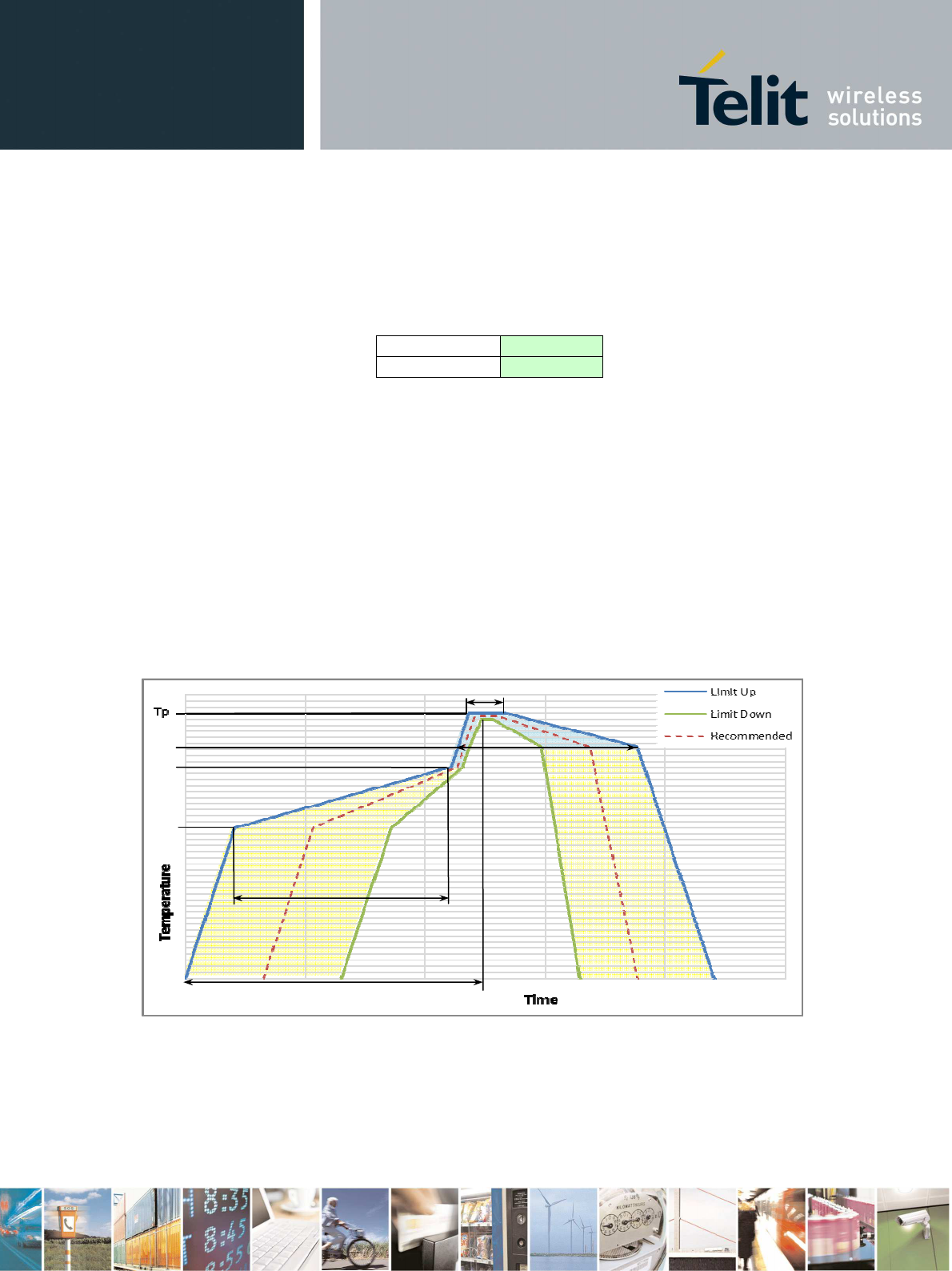
GE910 Hardware User Guide
1vv0300962 Rev.12 2013-10-22
Reproduction forbidden without Telit Communications S.p.A. written authorization - All Rights Reserved
page 69 of 83
Mod. 0805 2011-07 Rev.2
13.7. Solder paste
Lead free
Solder paste Sn/Ag/Cu
We recommend using only “no clean” solder paste in order to avoid the cleaning of the
modules after assembly.
13.7.1. GE910 Solder reflow
Recommended solder reflow profile
TL
Tsmin
Tsmax
ts
tL
tp
ttp

GE910 Hardware User Guide
1vv0300962 Rev.12 2013-10-22
Reproduction forbidden without Telit Communications S.p.A. written authorization - All Rights Reserved
page 70 of 83
Mod. 0805 2011-07 Rev.2
Profile Feature Pb-Free Assembly
Average ramp-up rate (TL to TP) 3°C/second max
Preheat
– Temperature Min (Tsmin)
– Temperature Max (Tsmax)
– Time (min to max) (ts)
150°C
200°C
60-180 seconds
Tsmax to TL
– Ramp-up Rate
3°C/second max
Time maintained above:
– Temperature (TL)
– Time (tL)
217°C
60-150 seconds
Peak Temperature (Tp) 245 +0/-5°C
Time within 5°C of actual Peak
Temperature (tp) 10-30 seconds
Ramp-down Rate 6°C/second max.
Time 25°C to Peak Temperature (ttp) 8 minutes max.
NOTE:
All temperatures refer to topside of the package, measured on the package body surface
WARNING:
The GE910 module withstands one reflow process only.
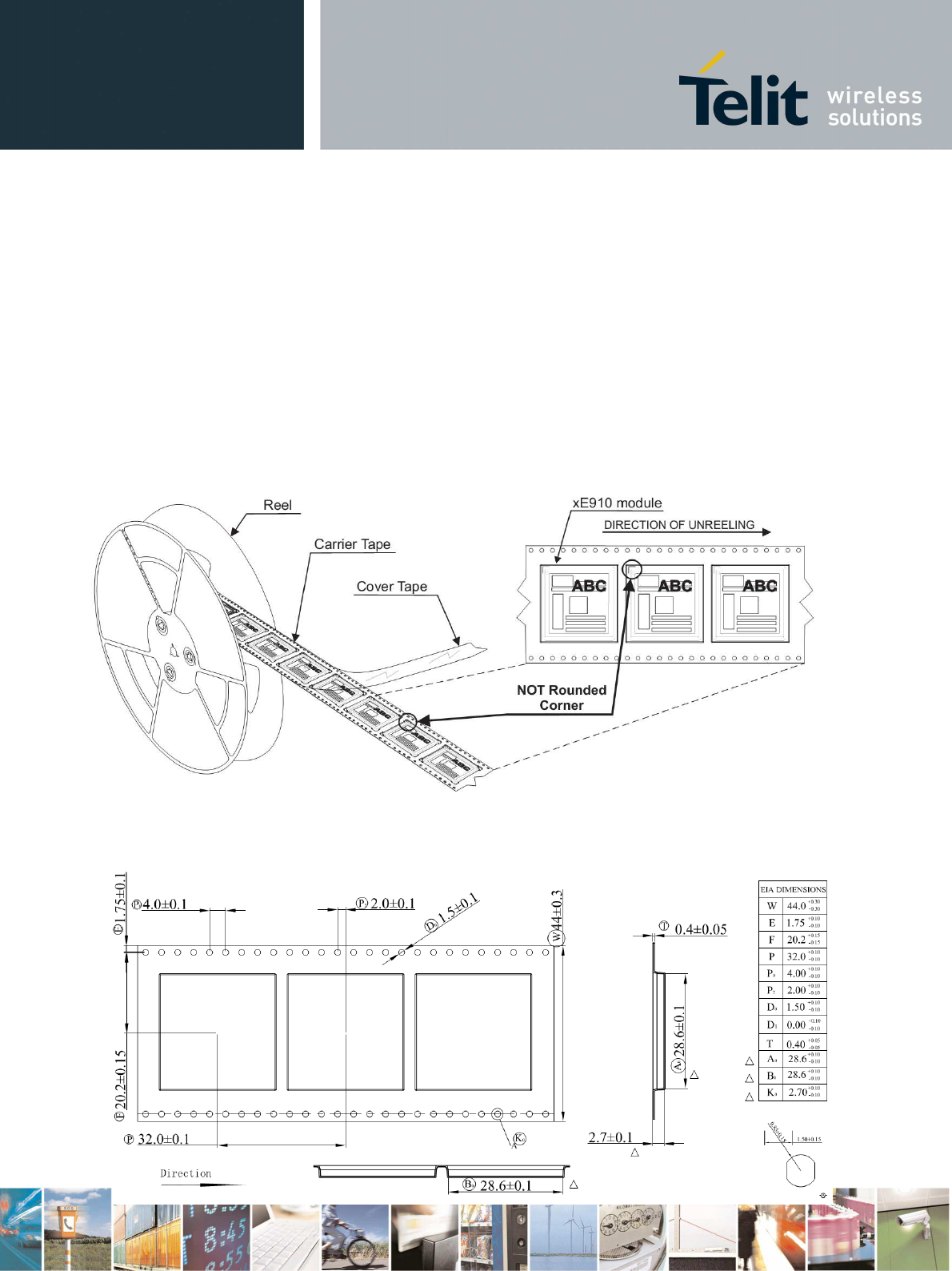
GE910 Hardware User Guide
1vv0300962 Rev.12 2013-10-22
Reproduction forbidden without Telit Communications S.p.A. written authorization - All Rights Reserved
page 71 of 83
Mod. 0805 2011-07 Rev.2
14. Packing system
Is possible to order in two packaging system:
• Package on reel
• Package on tray
14.1. Packing on Reel
The GE910 can be packaged on reels of 200 pieces each.
See figure for module positioning into the carrier.
14.1.1. Carrier Tape Detail
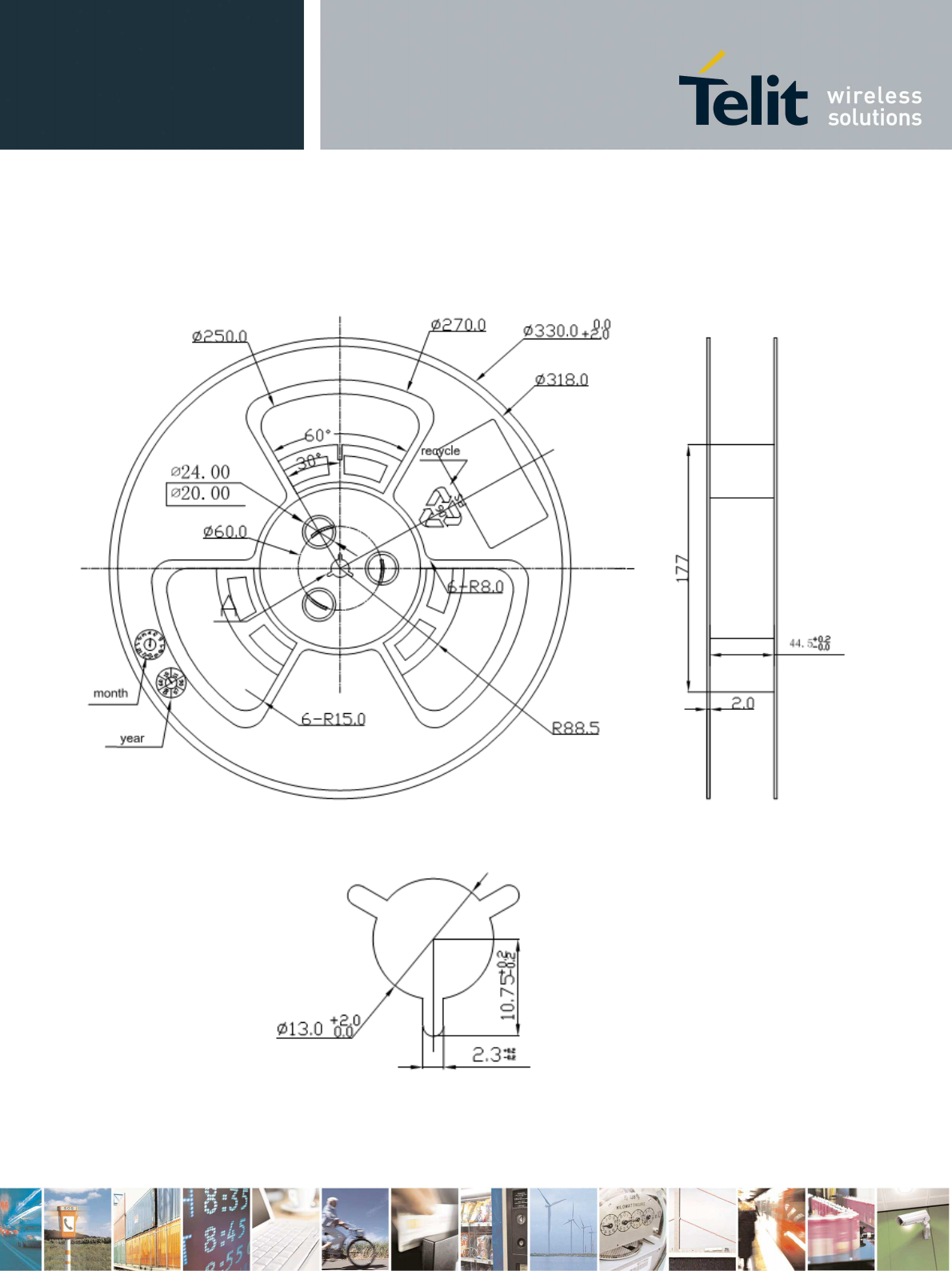
GE910 Hardware User Guide
1vv0300962 Rev.12 2013-10-22
Reproduction forbidden without Telit Communications S.p.A. written authorization - All Rights Reserved
page 72 of 83
Mod. 0805 2011-07 Rev.2
14.1.2. Reel Detail
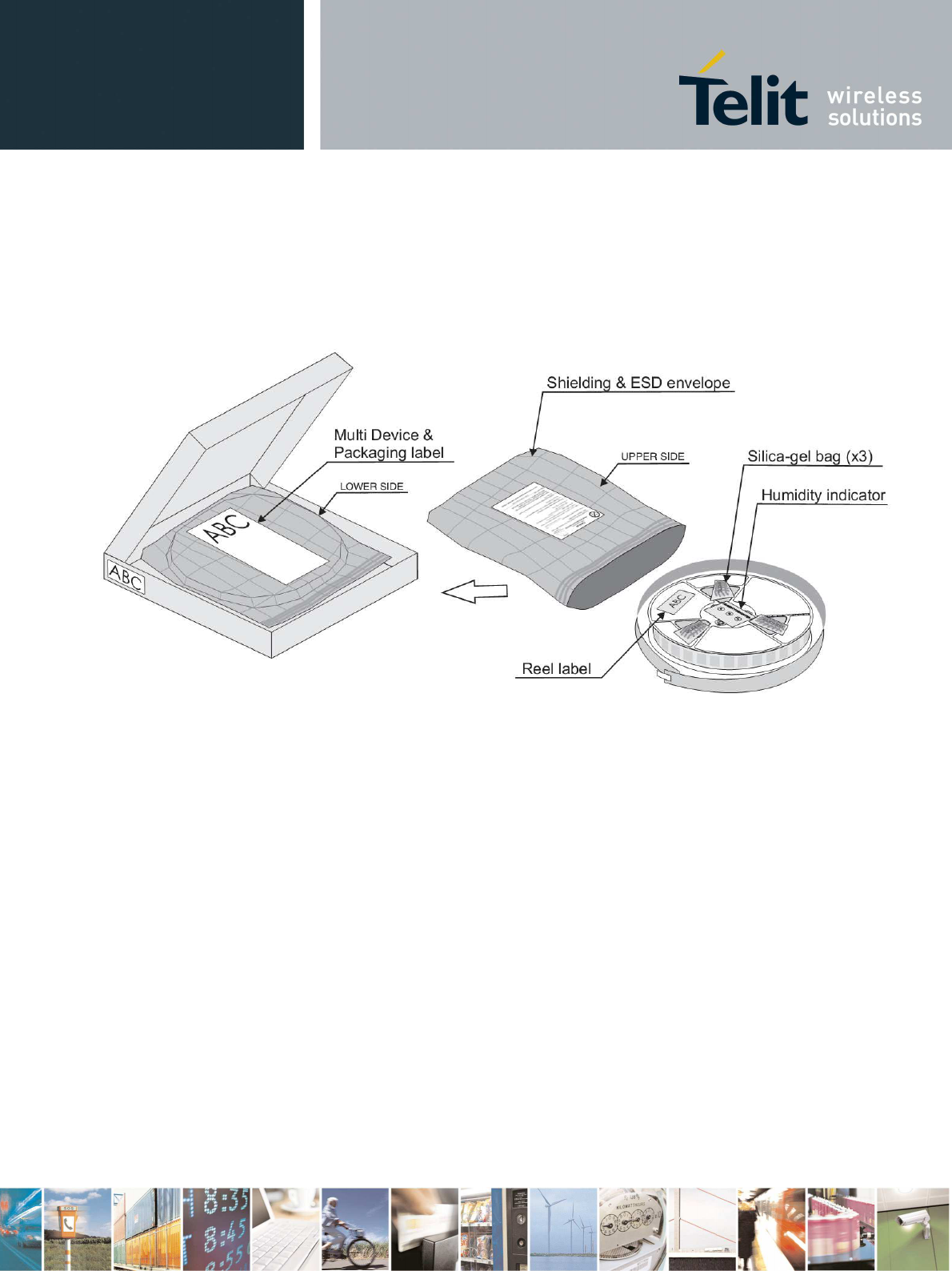
GE910 Hardware User Guide
1vv0300962 Rev.12 2013-10-22
Reproduction forbidden without Telit Communications S.p.A. written authorization - All Rights Reserved
page 73 of 83
Mod. 0805 2011-07 Rev.2
14.1.3. Packaging Detail
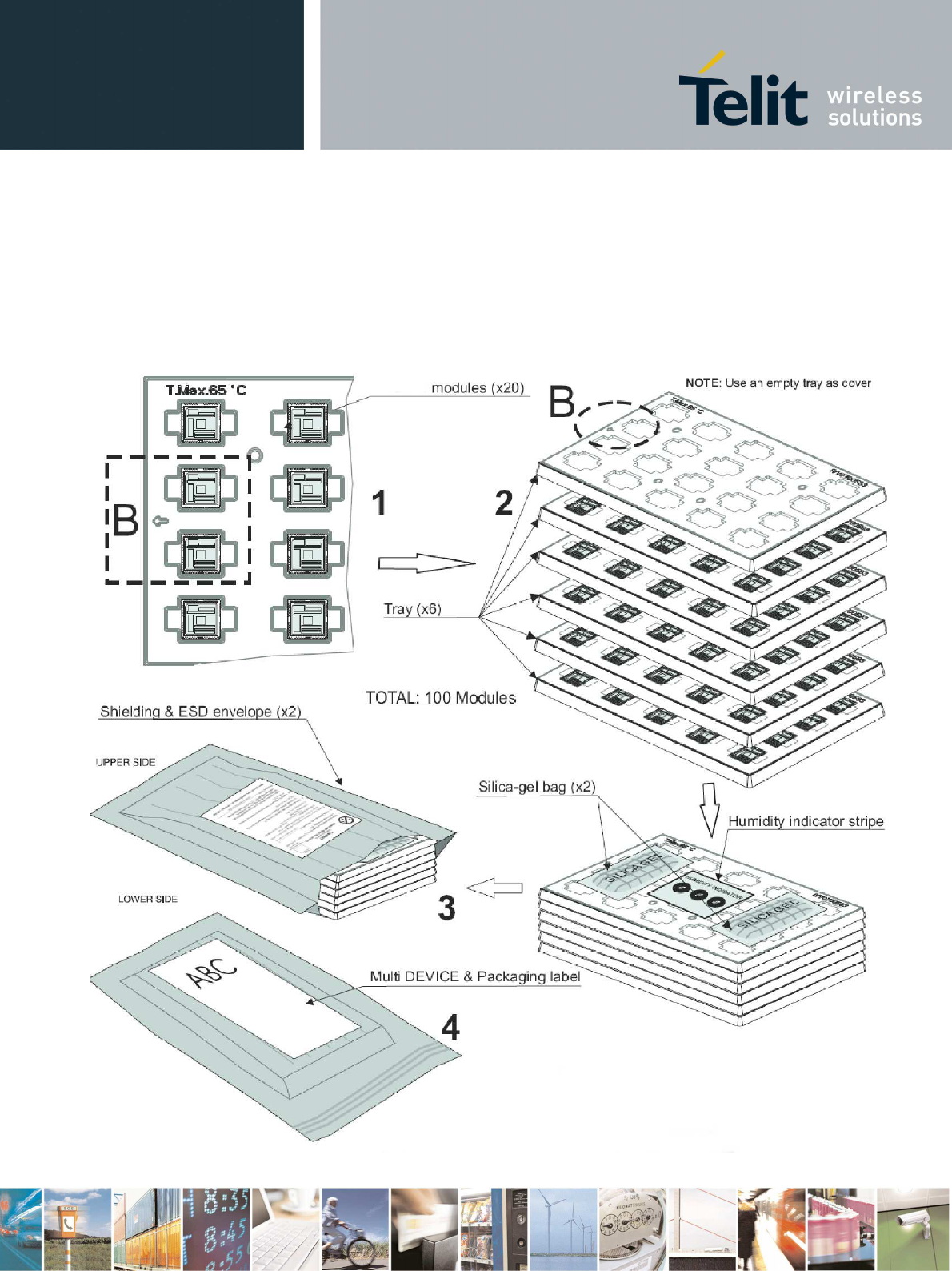
GE910 Hardware User Guide
1vv0300962 Rev.12 2013-10-22
Reproduction forbidden without Telit Communications S.p.A. written authorization - All Rights Reserved
page 74 of 83
Mod. 0805 2011-07 Rev.2
14.2. Packing on tray
The GE910 modules are packaged on trays of 20 pieces each. These trays can be used in SMT
processes for pick & place handling.
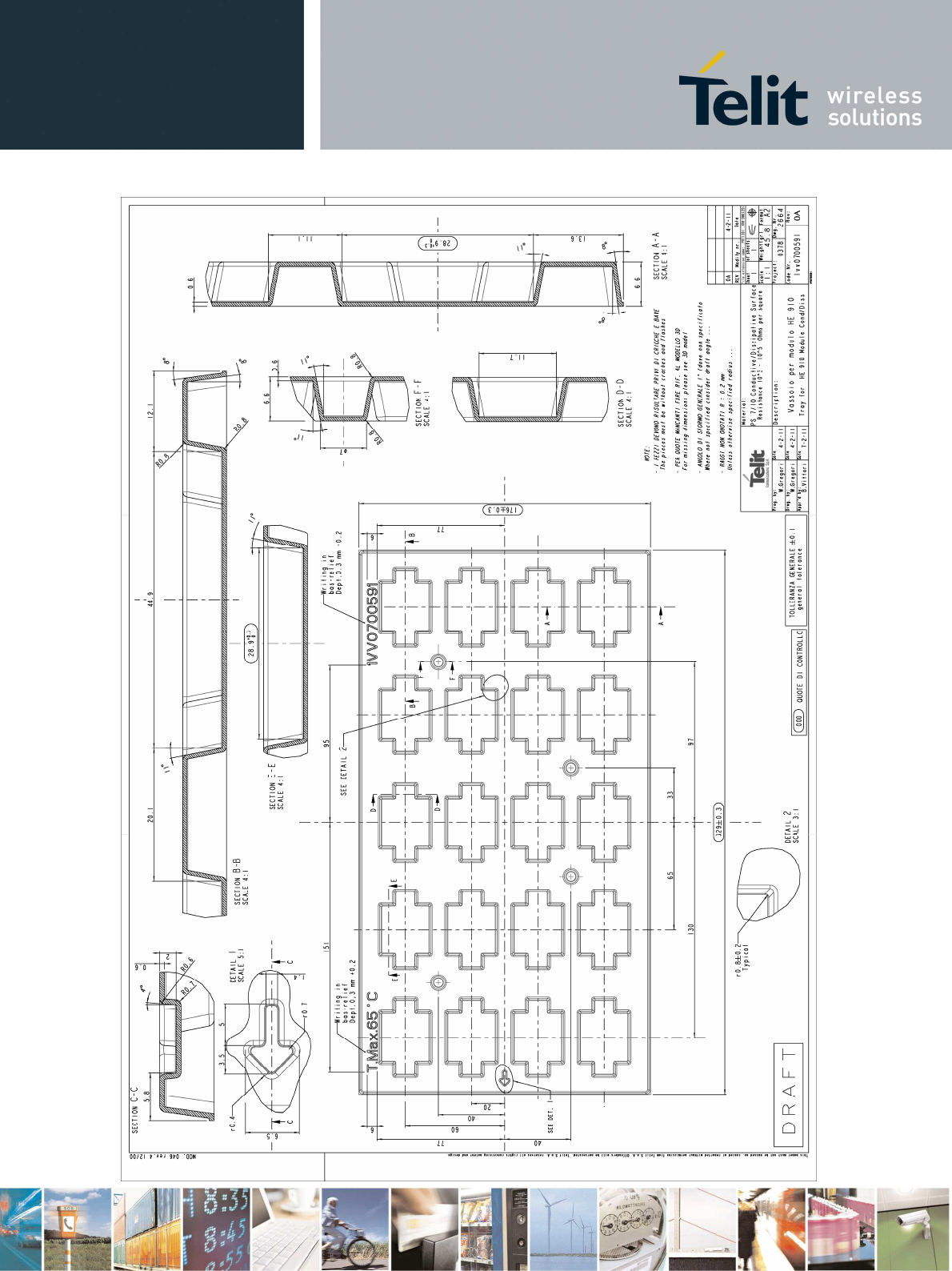
GE910 Hardware User Guide
1vv0300962 Rev.12 2013-10-22
Reproduction forbidden without Telit Communications S.p.A. written authorization - All Rights Reserved
page 75 of 83
Mod. 0805 2011-07 Rev.2

GE910 Hardware User Guide
1vv0300962 Rev.12 2013-10-22
Reproduction forbidden without Telit Communications S.p.A. written authorization - All Rights Reserved
page 76 of 83
Mod. 0805 2011-07 Rev.2
14.3. Moisture sensibility
The level of moisture sensibility of the Product is “3”, according with standard IPC/JEDEC J-
STD-020, take care of all the relative requirements for using this kind of components.
Moreover, the customer has to take care of the following conditions:
a) The shelf life of the Product inside of the dry bag must be 12 months from the bag seal date,
when stored in a non-condensing atmospheric environment of <40°C / 90% RH
b) Environmental condition during the production: <= 30°C / 60% RH according to IPC/JEDEC
J-STD-033A paragraph 5
c) The maximum time between the opening of the sealed bag and the reflow process must be
168 hours if condition b) “IPC/JEDEC J-STD-033A paragraph 5.2” is respected
d) Baking is required if conditions b) or c) are not respected
e) Baking is required if the humidity indicator inside the bag indicates 10% RH or more.

GE910 Hardware User Guide
1vv0300962 Rev.12 2013-10-22
Reproduction forbidden without Telit Communications S.p.A. written authorization - All Rights Reserved
page 77 of 83
Mod. 0805 2011-07 Rev.2
15. Conformity Assessment Issues
European Union - Directive 1999/5/EC
The GE910-QUAD module has been evaluated against the essential requirements of the
1999/5/EC Directive.
Bulgarian Telit Communications S.p.A. , Quad Band GSM/GPRS module
1999/5/ .
Czech Telit Communications S.p.A. tímto prohlašuje, že tento Quad Band GSM/GPRS module je
ve shod! se základními požadavky a dalšími p"íslušnými ustanoveními sm!rnice 1999/5/ES.
Danish Undertegnede Telit Communications S.p.A. erklærer herved, at følgende udstyr Quad Band
GSM/GPRS module overholder de væsentlige krav og øvrige relevante krav i direktiv
1999/5/EF.
Dutch Hierbij verklaart Telit Communications S.p.A. dat het toestel Quad Band GSM/GPRS
module in overeenstemming is met de essentiële eisen en de andere relevante bepalingen van
richtlijn 1999/5/EG.
English Hereby, Telit Communications S.p.A., declares that this Quad Band GSM/GPRS module is
in compliance with the essential requirements and other relevant provisions of Directive
1999/5/EC.
Estonian Käesolevaga kinnitab Telit Communications S.p.A. seadme Quad Band GSM/GPRS module
vastavust direktiivi 1999/5/EÜ põhinõuetele ja nimetatud direktiivist tulenevatele teistele
asjakohastele sätetele.
German Hiermit erklärt Telit Communications S.p.A., dass sich das Gerät Quad Band GSM/GPRS
module in Übereinstimmung mit den grundlegenden Anforderungen und den übrigen
einschlägigen Bestimmungen der Richtlinie 1999/5/EG befindet.
Greek #$ %&' ()*+,-) Telit Communications S.p.A. .&/'$0 +%0 Quad Band
GSM/GPRS module -,##+*1'$%)0 (*+- %0- +,-0.$0- )()0%&-$0- 2)0
%0- /+0($- -3$%02$- .0)%)4$0- %&- +.&50)- 1999/5/$2.
Hungarian Alulírott, Telit Communications S.p.A. nyilatkozom, hogy a Quad Band GSM/GPRS module
megfelel a vonatkozó alapvetõ követelményeknek és az 1999/5/EC irányelv egyéb
elõírásainak.
Finnish Telit Communications S.p.A. vakuuttaa täten että Quad Band GSM/GPRS module tyyppinen
laite on direktiivin 1999/5/EY oleellisten vaatimusten ja sitä koskevien direktiivin muiden
ehtojen mukainen.
French Par la présente Telit Communications S.p.A. déclare que l'appareil Quad Band GSM/GPRS
module est conforme aux exigences essentielles et aux autres dispositions pertinentes de la
directive 1999/5/CE.
Icelandic Hér með lýsir Telit Communications S.p.A. yfir því að Quad Band GSM/GPRS module er í
samræmi við grunnkröfur og aðrar kröfur, sem gerðar eru í tilskipun 1999/5/EC
Italian Con la presente Telit Communications S.p.A. dichiara che questo Quad Band GSM/GPRS
module è conforme ai requisiti essenziali ed alle altre disposizioni pertinenti stabilite dalla
direttiva 1999/5/CE.

GE910 Hardware User Guide
1vv0300962 Rev.12 2013-10-22
Reproduction forbidden without Telit Communications S.p.A. written authorization - All Rights Reserved
page 78 of 83
Mod. 0805 2011-07 Rev.2
Latvian Ar šo Telit Communications S.p.A. deklar6, ka Quad Band GSM/GPRS module atbilst
Direkt7vas 1999/5/EK b8tiskaj9m pras7b9m un citiem ar to saist7tajiem noteikumiem.
Lithuanian Šiuo Telit Communications S.p.A. deklaruoja, kad šis Quad Band GSM/GPRS module
atitinka esminius reikalavimus ir kitas 1999/5/EB Direktyvos nuostatas.
Maltese Hawnhekk, Telit Communications S.p.A., jiddikjara li dan Quad Band GSM/GPRS module
jikkonforma mal-:ti;ijiet essenzjali u ma provvedimenti o:rajn relevanti li hemm fid-
Dirrettiva 1999/5/EC.
Norwegian Telit Communications S.p.A. erklærer herved at utstyret Quad Band GSM/GPRS module er i
samsvar med de grunnleggende krav og øvrige relevante krav i direktiv 1999/5/EF.
Polish Niniejszym Telit Communications S.p.A. o<wiadcza, =e Quad Band GSM/GPRS module jest
zgodny z zasadniczymi wymogami oraz pozostałymi stosownymi postanowieniami
Dyrektywy 1999/5/EC
Portuguese Telit Communications S.p.A. declara que este Quad Band GSM/GPRS module está
conforme com os requisitos essenciais e outras disposições da Directiva 1999/5/CE.
Slovak Telit Communications S.p.A. týmto vyhlasuje, že Quad Band GSM/GPRS module sp>?a
základné požiadavky a všetky príslušné ustanovenia Smernice 1999/5/ES.
Slovenian Telit Communications S.p.A. izjavlja, da je ta Quad Band GSM/GPRS module v skladu z
bistvenimi zahtevami in ostalimi relevantnimi dolo@ili direktive 1999/5/ES.
Spanish Por medio de la presente Telit Communications S.p.A. declara que el Quad Band
GSM/GPRS module cumple con los requisitos esenciales y cualesquiera otras disposiciones
aplicables o exigibles de la Directiva 1999/5/CE.
Swedish Härmed intygar Telit Communications S.p.A. att denna Quad Band GSM/GPRS module står
I överensstämmelse med de väsentliga egenskapskrav och övriga relevanta bestämmelser
som framgår av direktiv 1999/5/EG.
In order to satisfy the essential requirements of 1999/5/EC Directive, GE910-QUAD module is
compliant with the following standards:
RF spectrum use (R&TTE art. 3.2) EN 301 511 V9.0.2; EN 62311:2008
EMC (R&TTE art. 3.1b) EN 301 489-1 V1.9.2
EN 301 489-7 V1.3.1
Health & Safety (R&TTE art. 3.1a) EN 60950-1:2006 + A11:2009 + A1:2010 + A12:2011 +
AC:2011
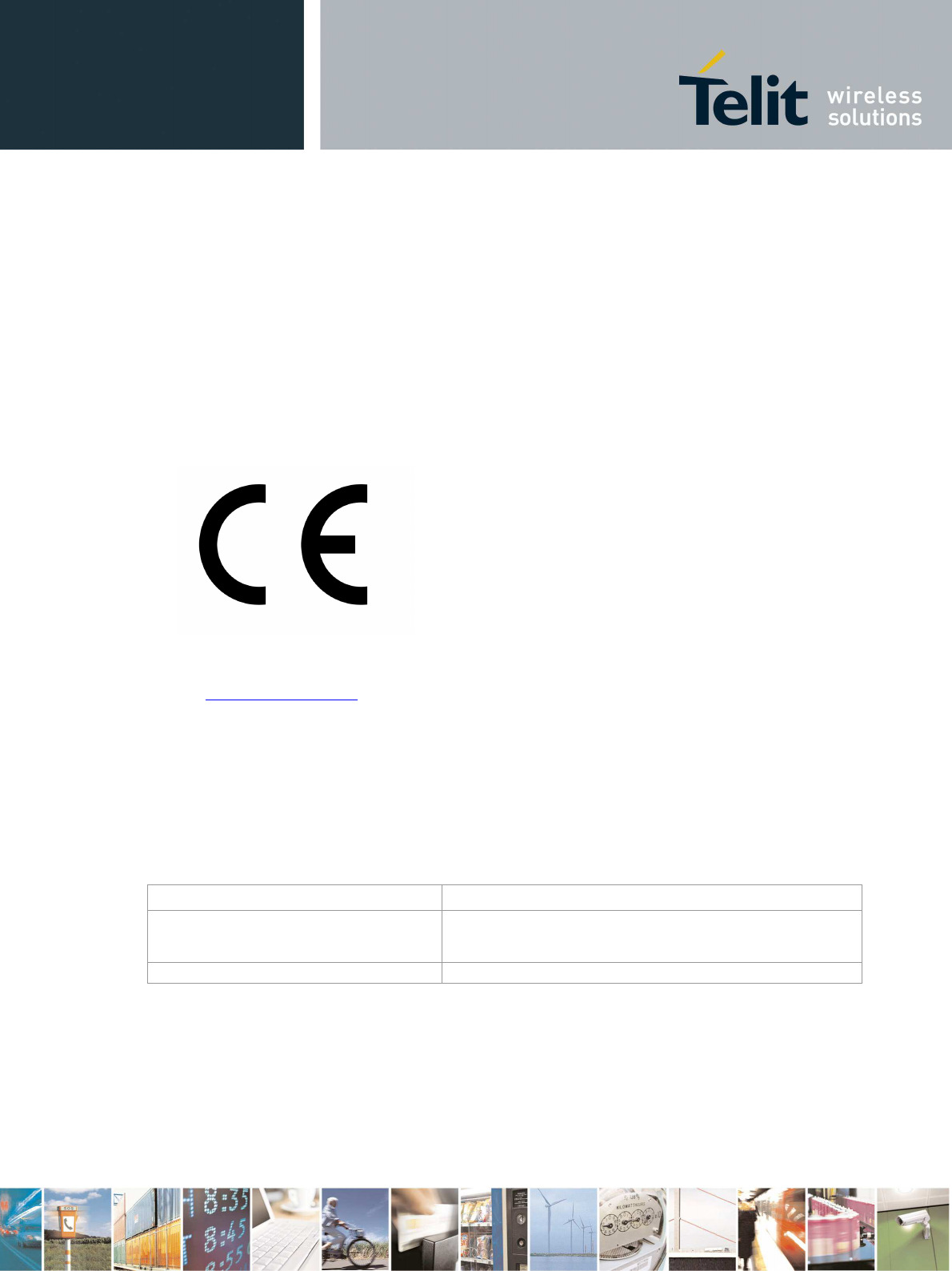
GE910 Hardware User Guide
1vv0300962 Rev.12 2013-10-22
Reproduction forbidden without Telit Communications S.p.A. written authorization - All Rights Reserved
page 79 of 83
Mod. 0805 2011-07 Rev.2
The conformity assessment procedure referred to in Article 10 and detailed in Annex IV of
Directive 1999/5/EC has been followed with the involvement of the following Notified Body
Notified Body:
AT4 wireless, S.A.
Parque Tecnologico de Andalucía
C/ Severo Ochoa 2
29590 Campanillas – Málaga
SPAIN
Notified Body No: 1909
Thus, the following marking is included in the product:
The full declaration of conformity can be found on the following address:
http://www.telit.com/
There is no restriction for the commercialisation of the GE910-QUAD module in all the
countries of the European Union.
Final product integrating this module must be assessed against essential requirements of the
1999/5/EC (R&TTE) Directive. It should be noted that assessment does not necessarily lead to
testing. Telit Communications S.p.A. recommends carrying out the following assessments:
RF spectrum use (R&TTE art. 3.2) It will depend on the antenna used on the final product.
EMC (R&TTE art. 3.1b) Testing
Health & Safety (R&TTE art. 3.1a) Testing
1909
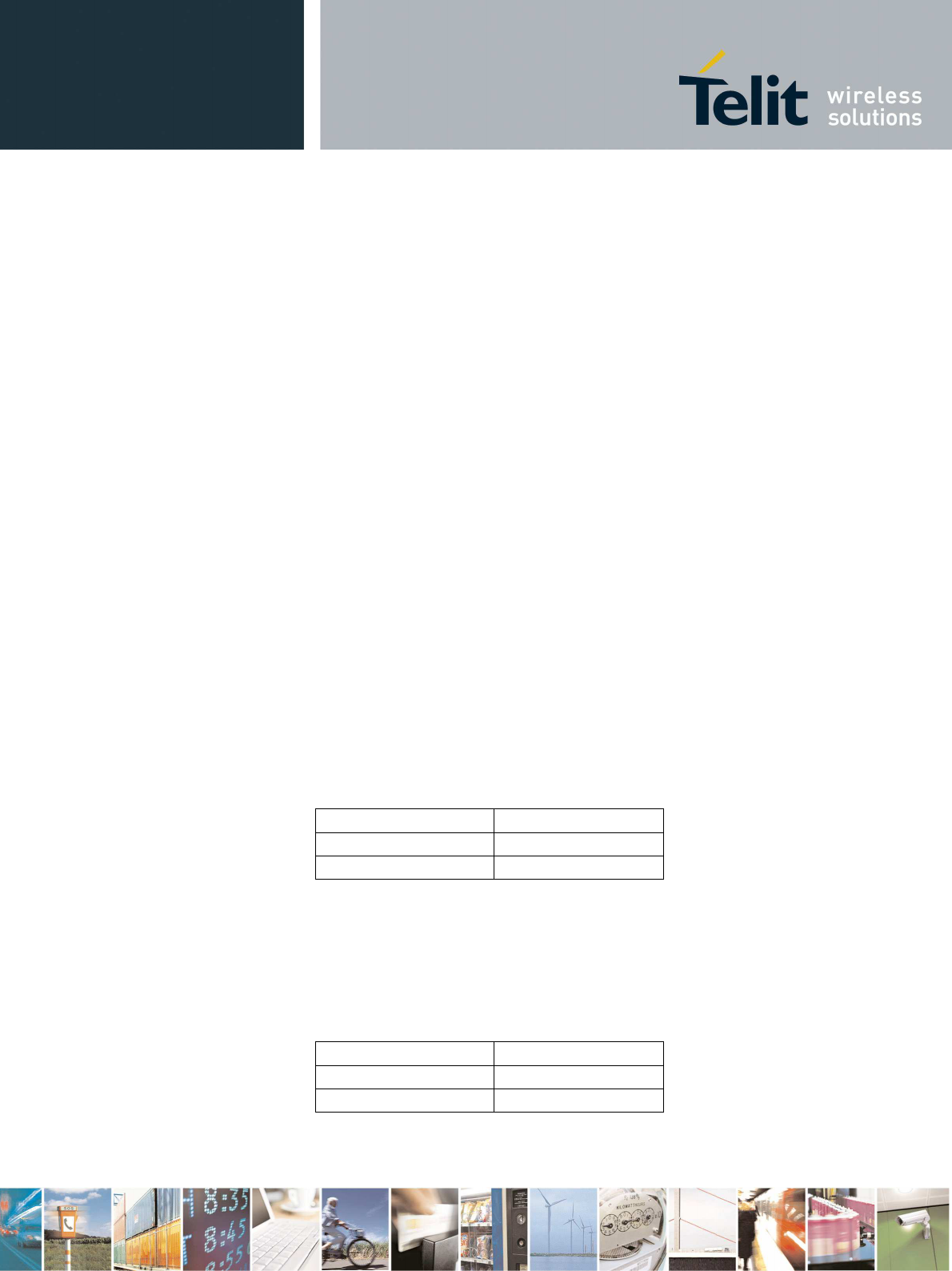
GE910 Hardware User Guide
1vv0300962 Rev.12 2013-10-22
Reproduction forbidden without Telit Communications S.p.A. written authorization - All Rights Reserved
page 80 of 83
Mod. 0805 2011-07 Rev.2
FCC/IC Regulatory notices
Modification statement
Telit has not approved any changes or modifications to this device by the user. Any changes or
modifications could void the user’s authority to operate the equipment.
Telit n’approuve aucune modification apportée à l’appareil par l’utilisateur, quelle qu’en soit la
nature. Tout changement ou modification peuvent annuler le droit d’utilisation de l’appareil par
l’utilisateur.
Interference statement
This device complies with Part 15 of the FCC Rules and Industry Canada licence-exempt RSS
standard(s). Operation is subject to the following two conditions: (1) this device may not cause
interference, and (2) this device must accept any interference, including interference that may
cause undesired operation of the device.
Le présent appareil est conforme aux CNR d'Industrie Canada applicables aux appareils radio
exempts de licence. L'exploitation est autorisée aux deux conditions suivantes : (1) l'appareil ne
doit pas produire de brouillage, et (2) l'utilisateur de l'appareil doit accepter tout brouillage
radioélectrique subi, même si le brouillage est susceptible d'en compromettre le fonctionnement.
Wireless notice
This equipment complies with FCC and IC radiation exposure limits set forth for an
uncontrolled environment. The antenna should be installed and operated with minimum distance
of 20 cm between the radiator and your body. Antenna gain must be below:
Frequency band Antenna gain
GSM 850 6.43 dBi
PCS 1900 3.00 dBi
This transmitter must not be co-located or operating in conjunction with any other antenna or
transmitter.
Cet appareil est conforme aux limites d'exposition aux rayonnements de la IC pour un
environnement non contrôlé. L'antenne doit être installé de façon à garder une distance
minimale de 20 centimètres entre la source de rayonnements et votre corps. Gain de l'antenne
doit être ci-dessous:
Bande de fréquence Gain de l'antenne
GSM 850 6.43 dBi
PCS 1900 3.00 dBi
L'émetteur ne doit pas être colocalisé ni fonctionner conjointement avec à autre antenne ou
autre émetteur.

GE910 Hardware User Guide
1vv0300962 Rev.12 2013-10-22
Reproduction forbidden without Telit Communications S.p.A. written authorization - All Rights Reserved
page 81 of 83
Mod. 0805 2011-07 Rev.2
FCC Class B digital device notice
This equipment has been tested and found to comply with the limits for a Class B digital
device, pursuant to part 15 of the FCC Rules. These limits are designed to provide
reasonable protection against harmful interference in a residential installation. This
equipment generates, uses and can radiate radio frequency energy and, if not installed
and used in accordance with the instructions, may cause harmful interference to radio
communications. However, there is no guarantee that interference will not occur in a
particular installation. If this equipment does cause harmful interference to radio or
television reception, which can be determined by turning the equipment off and on, the
user is encouraged to try to correct the interference by one or more of the following
measures:
- Reorient or relocate the receiving antenna.
- Increase the separation between the equipment and receiver.
- Connect the equipment into an outlet on a circuit different from that to which the receiver is
connected.
- Consult the dealer or an experienced radio/TV technician for help.
Labelling Requirements for the Host device
The host device shall be properly labelled to identify the modules within the host device. The
certification label of the module shall be clearly visible at all times when installed in the host
device, otherwise the host device must be labelled to display the FCC ID and IC of the module,
preceded by the words "Contains transmitter module", or the word "Contains", or similar
wording expressing the same meaning, as follows:
Contains FCC ID: RI7GE910Q3
Contains IC: 5131A-GE910Q3
L'appareil hôte doit être étiqueté comme il faut pour permettre l'identification des modules qui
s'y trouvent. L'étiquette de certification du module donné doit être posée sur l'appareil hôte à un
endroit bien en vue en tout temps. En l'absence d'étiquette, l'appareil hôte doit porter une
étiquette donnant le FCC ID et le IC du module, précédé des mots « Contient un module
d'émission », du mot « Contient » ou d'une formulation similaire exprimant le même sens,
comme suit :
Contient FCC ID: RI7GE910Q3
Contient IC: 5131A-GE910Q3
CAN ICES-3 (B) / NMB-3 (B)
This Class B digital apparatus complies with Canadian ICES-003.
Cet appareil numérique de classe B est conforme à la norme canadienne ICES-003.

GE910 Hardware User Guide
1vv0300962 Rev.12 2013-10-22
Reproduction forbidden without Telit Communications S.p.A. written authorization - All Rights Reserved
page 82 of 83
Mod. 0805 2011-07 Rev.2
16. SAFETY RECOMMANDATIONS
READ CAREFULLY
Be sure the use of this product is allowed in the country and in the environment required. The
use of this product may be dangerous and has to be avoided in the following areas:
Where it can interfere with other electronic devices in environments such as hospitals,
airports, aircrafts, etc
Where there is risk of explosion such as gasoline stations, oil refineries, etc
It is responsibility of the user to enforce the country regulation and the specific environment
regulation.
Do not disassemble the product; any mark of tampering will compromise the warranty validity.
We recommend following the instructions of the hardware user guides for a correct wiring of the
product. The product has to be supplied with a stabilized voltage source and the wiring has to be
conforming to the security and fire prevention regulations.
The product has to be handled with care, avoiding any contact with the pins because electrostatic
discharges may damage the product itself. Same cautions have to be taken for the SIM, checking
carefully the instruction for its use. Do not insert or remove the SIM when the product is in
power saving mode.
The system integrator is responsible of the functioning of the final product; therefore, care has to
be taken to the external components of the module, as well as of any project or installation issue,
because the risk of disturbing the GSM network or external devices or having impact on the
security. Should there be any doubt, please refer to the technical documentation and the
regulations in force.
Every module has to be equipped with a proper antenna with specific characteristics. The
antenna has to be installed with care in order to avoid any interference with other electronic
devices and has to guarantee a minimum distance from the body (20 cm). In case of this
requirement cannot be satisfied, the system integrator has to assess the final product against the
SAR regulation.
The European Community provides some Directives for the electronic equipments introduced
on the market. All the relevant information’s are available on the European Community website:
http://ec.europa.eu/enterprise/sectors/rtte/documents/
The text of the Directive 99/05 regarding telecommunication equipments is available, while the
applicable Directives (Low Voltage and EMC) are available at:
http://ec.europa.eu/enterprise/sectors/electrical
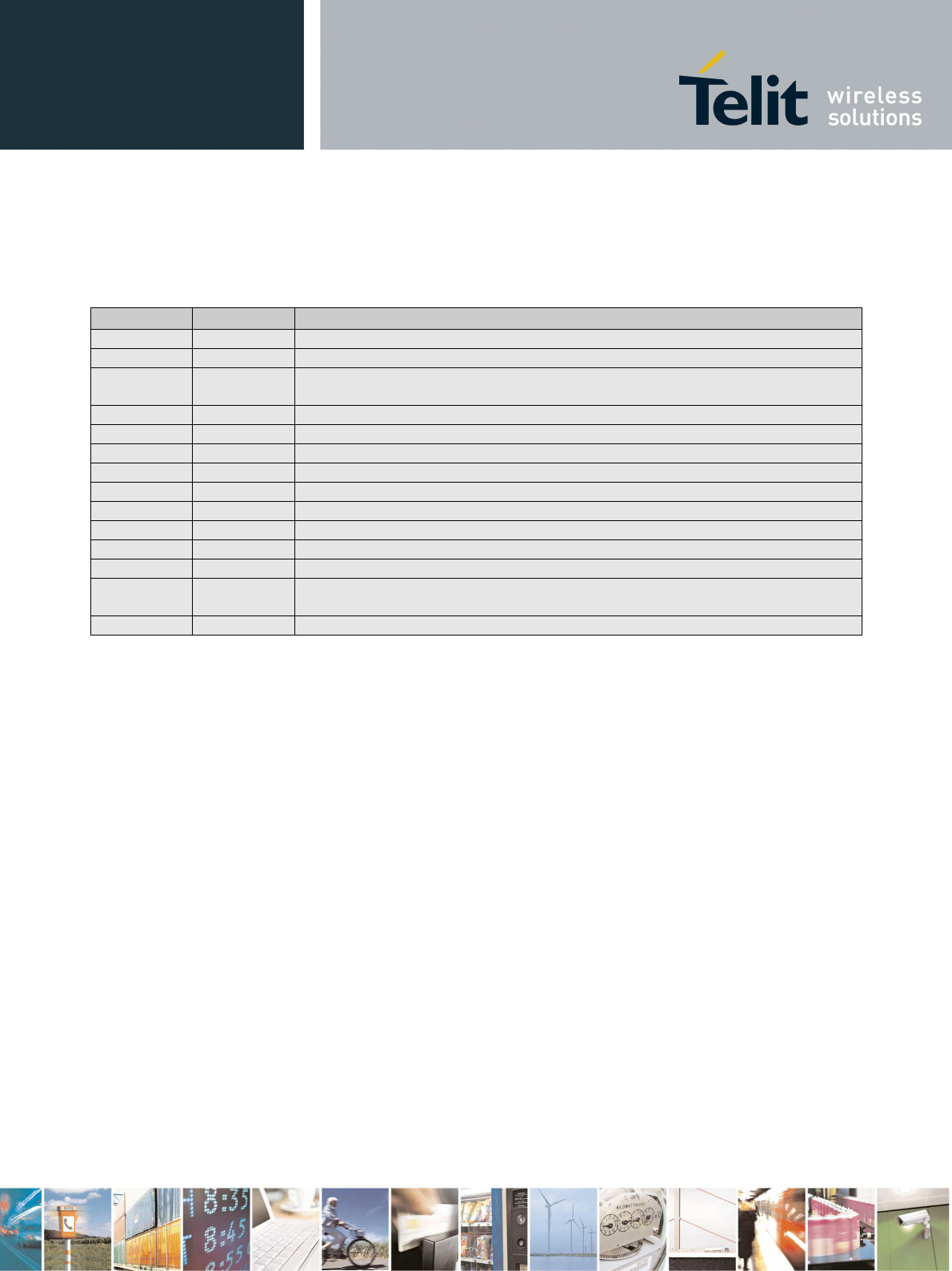
GE910 Hardware User Guide
1vv0300962 Rev.12 2013-10-22
Reproduction forbidden without Telit Communications S.p.A. written authorization - All Rights Reserved
page 83 of 83
Mod. 0805 2011-07 Rev.2
17. Document History
R
R
e
e
v
v
i
i
s
s
i
i
o
o
n
n
D
D
a
a
t
t
e
e
C
C
h
h
a
a
n
n
g
g
e
e
s
s
Rev.0 2011-11-11 First Release Rev.0 Preliminary 1
Rev.1 2012-02-27 First Release Rev.1
Rev.2 2012-06-07 Added chapter 11.7 ADC Converter – renaming pin RESET# in HW SHUTDOWN*
Chapter 5.2 Power consumption
Rev.3 2012-06-20 Added chapter 12.3 inhibit area around the RF pins
Rev.4 2012-06-25 Updated chapter 15 Conformity Assessment Issues
Rev.5 2012-06-28 Minor changes
Rev.6 2012-07-27 Chapter 3.2. The pin E13 is RESERVED; chapter 3.1. – pin R13, pinR12 and B1
Rev.7 2012-10-12 Changed name of Chapter 10.1. from AF_IN to MIC, added a note about USB 2.0 FS
Rev.8 2012-10-30 Updated chapter 10.3
Rev.9 2013-03-01 Updated GNSS features, Pin-out, DVI, Power Consumptions plots, Reel Packaging
Rev.10 2013-03-25 Updated the default NMEA speed to 115200; some fields on GNSS variant.
Rev.11 2013-03-26 Updated with GE910-QUAD V3 variant;
Rev.11bis 2013-10-15 Updated Chapter 15 with correct antenna gain values and Labelling Requirements for
the Host device
Rev.12 2013-10-25 Updated Chapter 15 with correct antenna gain values